Financial Markets
本文是学习 https://www.coursera.org/learn/financial-markets-global这门课的学习笔记

这门课的老师是耶鲁大学的Robert Shiller https://en.wikipedia.org/wiki/Robert_J._Shiller

Robert James Shiller (born March 29, 1946)[4] is an American economist, academic, and author. As of 2022,[5] he served as a Sterling Professor of Economics at Yale University and is a fellow at the Yale School of Management’s International Center for Finance.[6] Shiller has been a research associate of the National Bureau of Economic Research (NBER) since 1980, was vice president of the American Economic Association in 2005, its president-elect for 2016, and president of the Eastern Economic Association for 2006–2007.[7] He is also the co‑founder and chief economist of the investment management firm MacroMarkets LLC.
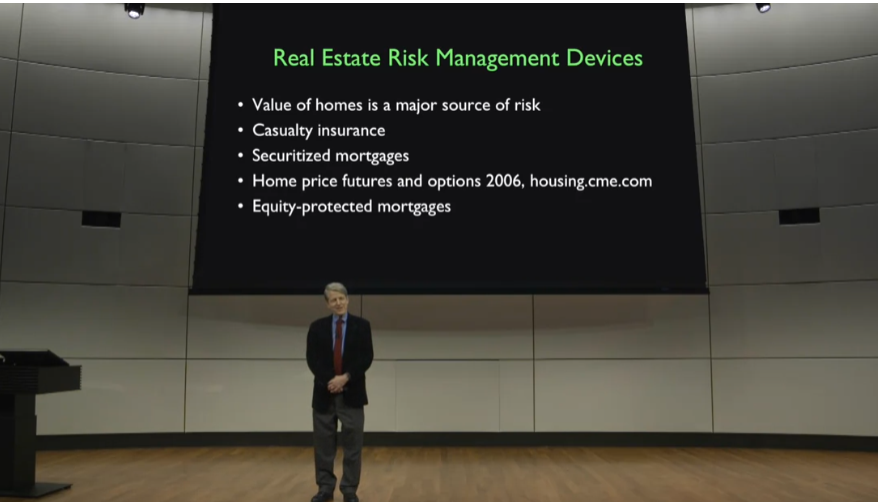
Week 02
In this next module, dive into some details of behavioral finance, forecasting, pricing, debt, and inflation.
Learning Objectives
- Understand the concept of limited liability and its connections with psychology, risk diversification and corporate finance.
- Describe inflation indexed debt, and monetary innovation designed to tackle hyperinflation.
- Understand the basics of the real estate market, assumptions behind forecasting the stock market, and the basic framework to price a stock.
- Describe the key intuition and definitions behind the Efficient Market Hypothesis, and why it might only be half-truth.
- Understand the basics of the real estate market, assumptions behind forecasting the stock market, and the basic framework to price a stock.
- Describe the key intuition and definitions behind the Efficient Market Hypothesis, and why it might only be half-truth.
- To describe and provide examples of the wishful thinking bias and of cognitive dissonance.
- List the key features of Antisocial Personality Disorder and Borderline Personality Disorder.
文章目录
以下是几个常见的与“economic”相关的单词以及它们的音标:
Economic
- 英式发音: /ˌiː.kəˈnɒm.ɪk/
- 美式发音: /ˌiː.kəˈnɑː.mɪk/ 或 /ˌɛk.əˈnɑː.mɪk/
Economics
- 英式发音: /ˌiː.kəˈnɒm.ɪks/
- 美式发音: /ˌiː.kəˈnɑː.mɪks/ 或 /ˌɛk.əˈnɑː.mɪks/
Economist
- 英式发音: /ɪˈkɒn.ə.mɪst/
- 美式发音: /ɪˈkɑː.nə.mɪst/
Economy
- 英式发音: /ɪˈkɒn.ə.mi/
- 美式发音: /ɪˈkɑː.nə.mi/
这些单词在英式英语和美式英语中的发音可能略有不同。希望这些音标对你有所帮助!
security: 证券
dividends: 美 [ˈdɪvəˌdendz] 股息;红利;被除数;(dividend的复数)
actuarial tables: 精算表格
archaeologist:美 [ˌɑːrkiˈɑːlədʒɪst] 考古学家
wheelbarrow:美 [ˈ(h)wilˌbɛroʊ] 手推车;独轮车
strap:美 [stræp] 带,皮带
trail:美 [treɪl] 拖;拉;拖沓行走;慢吞吞地走;
it would trail behind you 它会跟在你后面
aisle:美 [aɪl] 通道;走廊;过道 注意发音
subtitle:美 [ˈsʌbtaɪtl] 字幕, 注意发音
quirks:美 [kwɜrks] 怪癖;奇事;(quirk的复数)
enunciate:美 [əˈnənsiˌeɪt] 阐明;宣布;
But it was never enunciated as clearly as in 1811但它从未像1811年那样被清楚地阐明过
pursued:追赶;追捕;追击
investors in stocks can never be pursued for the mistakes of the company invested in 股票投资者永远不会因为所投资公司的错误而被追究责任
transgression:美 [trænzˈgreʃən] 违反;逸出;犯罪
This is going to lead to a wild transgression of our laws 这将导致严重违反我们的法律
mecca:美 [ˈmɛkə] 麦加;圣地;(mecca)朝拜的地方;
a mecca for business:商业圣地
nominal debt:名义债务
the government might print money, and debase the currency 政府可能会印钱,并使货币贬值
As Plato said, necessity is the mother of invention. 正如柏拉图所说,需要是发明之母。
rebellion:美 [rɪˈbeljən] 反叛;造反;叛乱
extol:美 [ɪkˈstoʊl] 颂扬;赞美
So here’s an invention that I’ve been extolling now for 25 years 这是一项我已经赞美了25年的发明
fluctuation: 波动
bizarre:美 [bɪˈzɑːr] 奇怪的
Finally, real estate risk management devices. Values of homes go up and down a lot and people are not protected against these fluctuations and this is bizarre to me. 最后,房地产风险管理工具。房屋价值大起大落,人们无法抵御这些波动,这对我来说很奇怪。
borne:美 [bɔːrn] 支持;支撑;
That is borne by you, the homeowner 这是由你这个房主承担的
lamp post 灯柱
exuberance: 美 [ɪg’zjʊbərəns] 丰富;茂盛;充沛
irrational exuberance 非理性繁荣
beeper:呼叫器;传呼机;蜂鸣器
coiner:美 [ˈkɔɪnər] 铸造钱币者;新词的创造者
utility:效用
Expected Utility Theory: 预期效用理论
concave ( l o g x log x logx) or convex ( x 2 x^2 x2): 凹凸性
dissonance: 美 [ˈdɪsənəns] 不和谐;不一致;不协调
Cognitive dissonance: 认知不一致, 认知失调
compartment: 美 [kəmˈpɑːrtmənt] 分离部分;分隔的空间;
mental compartments 心理隔间
option: 期权
call option:看涨期权
put option:看跌期权
anomaly: 美 [əˈnɑːməli] 异常;反常现象;
attention anomalies:注意力异常
arbitrage:美 [ˈɑrbəˌtrɑʒ] 套利
no arbitrage assumption: 无套利假设
bank teller:银行出纳
sculptress:美 [ˈskəlptrəs] 女雕刻家;女雕塑家
And the choices involved bank teller or sculptress. 选择包括银行出纳员或女雕塑家。
disjunction: 美 [ˌdɪsˈdʒəŋ(k)ʃ(ə)n] 不对应;不一致;析取
disjunction effect: 分离效应
superstition: 美 [ˌsuːpərˈstɪʃn] 迷信;盲目的迷信想法
fallacy: 美 [ˈfæləsi] 谬论;谬见;谬误
contagion:美 [kənˈteɪdʒən] 传播;散布;蔓延
social contagion: 社交传播
sociopathy:美 [sosiopæθi] 社会病态
Lesson #5
Invention Takes Time
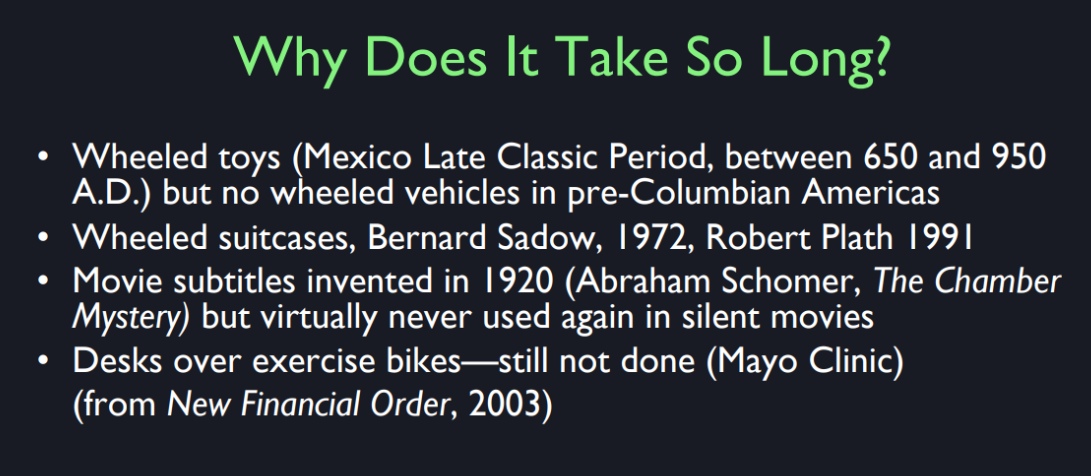
Why does it take so
long for ideas to develop? l mentioned insurance,
it goes back to ancient Rome. Why is it that we didn’t have any real
insurance, l mean in the sense of an insurance company with actuarial
tables and the like, until the 1600s? And why did fire insurance
on homes become important? Most people didn’t own
fire insurance until after the reformations
in the Great Depression. So the funny thing about invention to me,
is that ideas that seem simple and natural, somehow don’t get established,
I’ll give you some examples. These are from my book,
The New Financial Order. Wheeled toys okay, well archaeologists in Mexico find that there were children’s
toys, that had wheels on them. Little toy cars, and you could roll
them along the floor all right, so they knew about wheels. But you know what, nowhere in
the Americas, did they ever find a wheeled wagon, or anything used. A wheelbarrow, nothing,
they only had toys, strange.
Now this brings up another
example of wheeled suitcases. So I wrote this book in 2003,
13 years ago, and you have a suitcase with wheels on it,
right? Does anyone not have
wheels on their suitcase? Well it seems like this is so obvious,
suitcases should have wheels. But you know they didn’t until 1972? That’s not long ago, and in fact,
I was doing research for my book, and I had an undergraduate research assistant. And I was intrigued by
these wheeled suitcases. So I asked my student go find
the inventor, is he still alive? So he tracked him down,
it was Bernard Sadow in 1972. And called him up on the phone,
again inventors don’t tend to be famous. You didn’t know his name, right? It’s changed your life. [LAUGH] You don’t know what is
like carrying a heavy suitcase when there are no wheels on it. So my student asked him what was it
like inventing the wheeled suitcase? And he said, I had a lot of resistance, I showed my wheeled suitcases,
I went to department stores. Remember department stores? They used to have those
instead of online shopping. And I told them, this is a great idea,
and they said, no it isn’t, nobody’s going to buy that. It looks ridiculous, wheels on suitcases.
They said look, if you want help with
your luggage, every train station, every hotel has porters who will be ready
to help you, you don’t need these things. That’s what they told him, but
he did get some of them to sell. The problem with his wheeled suitcase,
however now he didn’t get it right either. He had a suitcase,
a big suitcase like this, and there were four little tiny wheels on
the bottom, and there was a strap, right? So you would pull on the strap
like a leather strap, and it would trail behind you. You might still have one
in your parents’ attic. They flop over, that’s the problem, you
start pulling and it falls over sideways. But you can do it, you can figure
out eventually how to pull it. It wasn’t until Robert Plath in 1991,
invented something he called the Rollaboard,
which you now have, right? And actually, it improved again. But in 1991, he had a suitcase with
just two wheels on the bottom, and a rigid handle,
not this leather strap. And the handle collapsed into
the suitcase, and you could pull it out, and then would tilt, and
it would be very stable. That was 1991, and
that just completely took over. He called it a Rollerboard,
because he was an airline pilot, and he made it narrow enough so
you could roll the suitcase down the aisle of the airplane, and
it wouldn’t bump into anyone. It was under control. You know what the latest thing is? It’s like a Rollaboard,
I’m going on too long about this. The latest thing is now they
have four wheels again. And you can either do it
like a Rollaboard, or you can stand it up, and people like that. Every one of these
inventions took ten years. You’d think Bernard Sadow would’ve
figured the whole thing out in 91, but that’s not the way it works.
Movie subtitles were invented in 1920, but never really used in silent movies,
I think this is amazing. They had this whole silent movie era,
they’d already invented subtitles, and they didn’t put them on movies. They had these intertitles,
you remember silent movies? They would stop the whole movie and
they’d show you this intertitle. But it’s so much better, and
I’m really used to it now. You can watch a movie with, it doesn’t
matter what language it’s in anymore. So obvious.
And desks over exercise bikes,
I have this in my basement. I put a desk over my exercise bike,
and I’m preparing my lecture. Mayo Clinic is selling them now,
but it’s a slow thing. Eventually you ought to get one,
so that you can exercise and do scholarly work at the same time.
I think that we’re moving ahead. Another way of putting it is,
financial theory and practice are good areas for
young people to go into, because I think it has been transforming and
will continue to be transforming. And I think that the nature of our
financial markets in 10, 20, 30, 50 years, which matters for young people today,
will be amazingly different and better. And you have to join the financial
community to make that happen, you don’t have to, I’m just saying. >> [LAUGH]
Do you have in your mind, an ideal of what future looks like? >> See there are people who proposed
like Karl Marx for example. >> Right. >> Robert Owen who’s the guy
who coined the term socialism. They had ideals which they sold on
the public as simple and obvious. >> Right. >> But I think it’s not quite so
simple and obvious. The human species is
the product of evolution, that gave us a number of different mental
quirks that served us well as cavemen. [LAUGH] But now they don’t really
fit into the modern world, we’re just seeing new opportunities. So we might be excessively fearful or
unwilling to change. We might be too focused on
our own personal lives. And we have to invent something different,
and it won’t be a perfect world, just like it’s never been a perfect world,
but it’s exciting and it’s getting better.
Salon - Innovation
What do you think has been
important about the innovation of people’s ability to insure
against risk in the marketplace? Whether it’s through just something
as simple as an insurance contract or by other means? >> Well, the history of risk management
goes back thousands of years. I would say that the history
of risk management is, the technology that we have has been
very slow to develop over the centuries. And that encourages me to think that
it has a lot more to develop yet, a lot more to develop yet. I think that there’s
an inherent conservationism and mistrust of new financial arrangements. In the sense that, I’m not coming to this party unless
the in-people coming to it also. And so things are very slow to develop. I don’t know if I’m
answering your question. It is a belief of mine that financial innovation is a pillar
of our civilization. That it’s not just
shifting papers around and getting people to sign documents that
trick them into signing away something. It’s a sequence of inventions
that incentivize people, provide capital for enterprises. Create organizations that last
through time that separate themselves from the objectives of the individuals
who comprise the corporation. And get people focused on some
common good that will be produced.
Do you think it’s safe
to say that historically, financial innovation has
occurred on the upside? Looking to capture new markets and
new ways of earning returns, versus on the, kind of the downside
risk management side of the ledger. >> Well, when we say risk management,
it seems to imply a focus on the downside. But it’s on the upside as well,
because people accept the downside risk because there’s something on the plus
side that is enticing and is exciting. So this is an interesting point, people seem to like gambles that involve a small amount of money
lost with high probability. And a large money gained
with low probability. So if that’s what people like,
we have to try to turn the natural risks which might be balanced equally into loss
and gain into something more appealing. So that’s one thing that
limited liability did.
People like lottery tickets. I paid $2 today, and
I have the chance of winning $10 million. For some reason, the chance is minuscule. It’s virtually zero, but
somehow people like that. So that’s a discovery of our human nature. Why they like that is a puzzle but
we just know that people like that. It’s because people savor
the small probability. I have this lottery ticket
I bought this morning. I could be worth $10 million at the end
of the day when they announce the number. That just makes your day bright. And then, when you don’t win, you still
feel well, it was just $2, so what. So what limited liability
does is it creates that for corporate, that same sense for
investing in stock. You bought 100 shares,
so maybe that’s $3,000. That’s a little bit more
than a lottery ticket. But hey, I could be a multimillionaire
if I bought the right company. It’s like a lottery ticket. So people flock to these things. And they’re actually,
they’re disappointed almost always. But they’re not disappointed
because we end up with a more vital business sector
where things are created. So we have to try to reframe things. That’s what part of
financial innovation is. Reframe risk so that they’re appealing. And we want to also, for good social
purpose to be risks that need to be taken. So that they benefit the economy.
Here’s a summary of the professor’s key points:
Slow Development of Risk Management Technology:
- The history of risk management spans thousands of years but has developed very slowly.
- There is inherent conservatism and mistrust in new financial arrangements, causing slow adoption and innovation.
Financial Innovation as a Pillar of Civilization:
- Financial innovation is crucial for civilization, not just about paperwork or contracts.
- It provides capital for enterprises, creates lasting organizations, and focuses on common good beyond individual objectives.
Focus on Upside and Downside Risk Management:
- Risk management often implies focusing on downside risks, but it includes upside opportunities.
- People accept downside risks because of enticing upside gains, which is a key part of financial innovation.
Human Nature and Risk Preferences:
- People prefer gambles with small losses and large potential gains (e.g., lottery tickets).
- This preference can be harnessed through financial instruments like limited liability, which makes investing in stocks similar to buying lottery tickets.
Limited Liability and Investment Appeal:
- Limited liability appeals to investors by providing a chance of high returns while limiting losses, akin to the appeal of lottery tickets.
- This encourages investment and creates a more dynamic business sector.
Reframing Risk for Economic Benefit:
- Financial innovation involves reframing risks to make them appealing and beneficial for the economy.
- By doing so, necessary risks are taken, leading to overall economic growth and development.
The professor emphasizes the importance of financial innovation in managing both risks and opportunities, its slow historical development, and the psychological factors influencing investment behavior.
以下是教授要点的总结:
风险管理技术的发展缓慢:
- 风险管理的历史可以追溯到数千年前,但其技术发展非常缓慢。
- 对新金融安排的保守态度和不信任导致了这种缓慢的采纳和创新。
金融创新是文明的支柱:
- 金融创新对文明至关重要,不仅仅是处理文件或签订合同。
- 它为企业提供资本,创建持久的组织,并关注超越个人目标的共同利益。
侧重于上下风险管理:
- 风险管理通常意味着关注下行风险,但它也包括上行机会。
- 人们接受下行风险是因为上行收益具有吸引力,这是金融创新的关键部分。
人性与风险偏好:
- 人们倾向于接受小额损失和潜在大额收益的赌博(例如,买彩票)。
- 这种偏好可以通过有限责任等金融工具来利用,使股票投资类似于购买彩票。
有限责任与投资吸引力:
- 有限责任通过提供高回报的机会,同时限制损失,使投资者感到投资类似于购买彩票。
- 这鼓励了投资,创造了更具活力的商业部门。
为经济利益重新定义风险:
- 金融创新涉及重新定义风险,使其更具吸引力并有利于经济。
- 通过这样做,必要的风险得以承担,从而促进整体经济增长和发展。
教授强调了金融创新在管理风险和机遇中的重要性,它的历史性缓慢发展,以及影响投资行为的心理因素。
Limited Liability
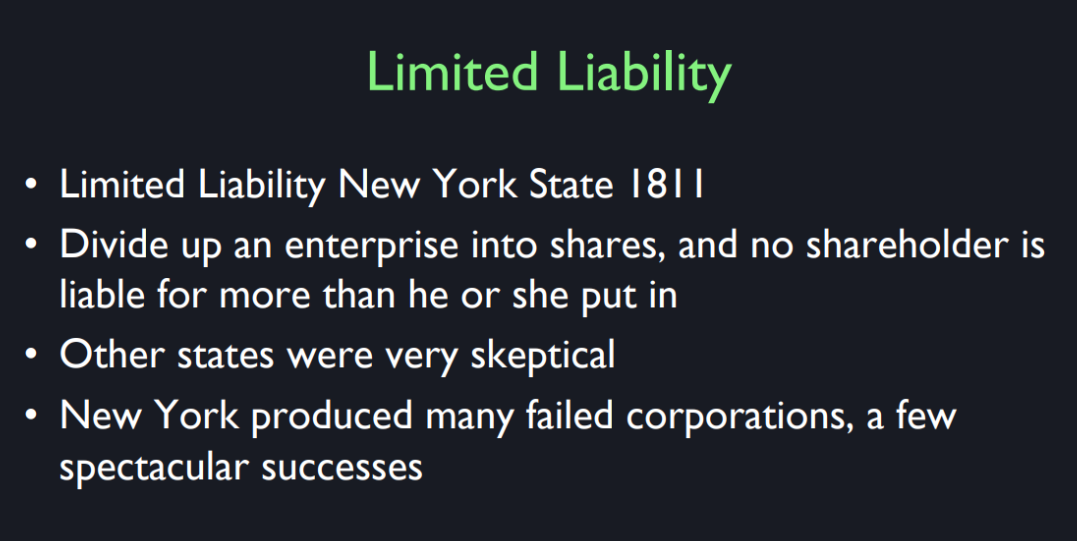
So I wanted to give some examples, both from the past and from the things that I’ve talked about now. So, the first example I like is limited liability. I’m going to credit New York State with inventing the full dimension of this idea in 1811. However, it precedes the idea of limited liability, it precedes 1811 and I don’t know what country can be given credit for discovering it. But here is the idea.
Well, actually it goes back in a way to Bottomley which I talked about. The idea is that investors, in order to be encouraged to invest in businesses, should have protection against liability for what the managers of the business do. They should have limited liability. So the example we gave before, is if you’re in ancient Rome and you are considering investing in a trade, a trip where they’re going to send out a ship to trade goods, if the ship sinks, you are not liable. You don’t have to pay the loan back. That’s an example. But it was never enunciated as clearly as in 1811.
So New York State passed a new law then, that said investors in stocks can never be pursued for the mistakes of the company invested in. So what we’re going to do is allow it. Well, already they had shares. You could buy shares in businesses but you only are liable for what you put in initially, and no more worries. So - but before this law, there was doubt about that. Apparently the idea of going after shareholders for the sins of a company was rare, but people had to worry about so this is what could happen. Before 1811 in New York, you could buy shares in some company and then the company commits a crime and then they come after you to pay up for the crimes of the managers. And you say, “I didn’t know. You know, I just bought some shares. I didn’t know who these guys were.” And they would say, “Well. tough luck. Pay up or go to debtors’ prison.” That’s what they would potentially do. And they had debtors’ prison. There was a different idea there, but the idea is if you invested in this company, you are responsible and we’re not going to forgive you.
So when New York State passed the law, there was a lot of controversy and a lot of people in other states said, "This is crazy. People are not responsible for what they invest in and what happens. This is going to lead to a wild transgression of our laws and our - Massachusetts passed a law, similarly around the same time, reaffirming that shareholders are responsible for what they invest in, you are a party to the crime. So what happened? Well, almost all of the business went to New York and New York became a mecca for business. And eventually, gradually, state by state, they all did it. They all passed limited liability laws. There were a few spectacular failures, you know corrupt businesses. But so many good businesses started this way. So I think this was an invention, and it was an experiment in human nature. The problem is that people, if you are responsible for everything you get involved in, then you won’t do it. You won’t supply capital to some business.
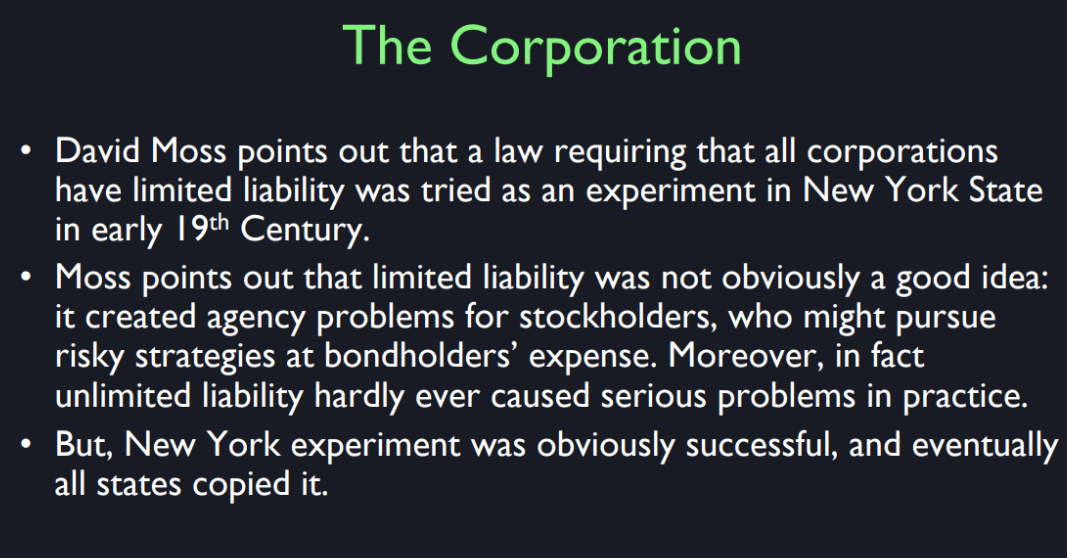
David Moss was a graduate. I mentioned him before, a graduate student here at Yale who wrote his dissertation and then a book called, “When all else fails, the role of government in risk management.” He describes this controversy in 1811. But the real genius of limited liability is that it makes it possible for you to make an investment in some enterprise and then it’s just fun. There are no more - you can lose what you put in, but you know exactly what you put in. So what Moss said in his book is that it’s really behavioral. You know, this is human factors engineering. Nobody knew when they tried limited liability what would happen. It might encourage corruption. It might not affect the supply of capital.
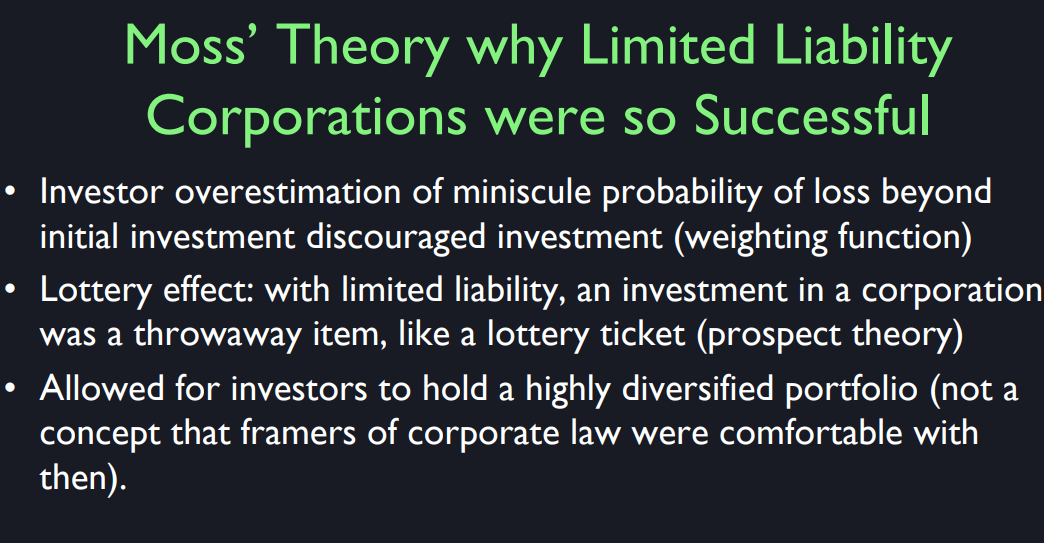
But we discovered that investor psychology favors limited liability. That’s because investors tend to- if they’re not limited liability, they overestimate the minuscule probability of loss. Just as when they buy lottery tickets, they over estimate the minimal probability of winning. So he thought that what the limited liability did, is created a sort of lottery effect. People are basically you know, you’re driven toward fun things and you don’t like things that make you worry. So let’s make it buying a share in some startup company is like buying a lottery ticket. And, now you probably won’t get rich almost certainly won’t get rich, but hey it’s fun. And so, just like lotteries, I don’t know why people- when I go to the train station, I have to stand in line at the little store there behind people buying lottery ticket. I can’t imagine why me or anyone would buy those, because your chance of winning is so low. But people do buy and they just it makes their day, I guess they have fun. You buy a lottery ticket in the morning and then where do you turn on television? I don’t know. There’s some television clip that shows you them drawing the ball, and you’re all excited and you’re having fun and you lose. You think they keep losing, that they would stop that they don’t. There’s something- you wouldn’t know this but that’s human nature. The other thing about limited liability, is that it created the whole idea of holding a diversified portfolio. If you don’t have limited liability, absolutely not. You should not hold a diversified portfolio. Especially if you have some wealth, they’ll go after you. One of those companies is going to go down and they’ll go after you. So, don’t hold that diversified portfolio. Once they discovered that- once they did limited liability, then you could start enjoying your investment and diversify over many things. And we know that there is risk management power in the diversification.
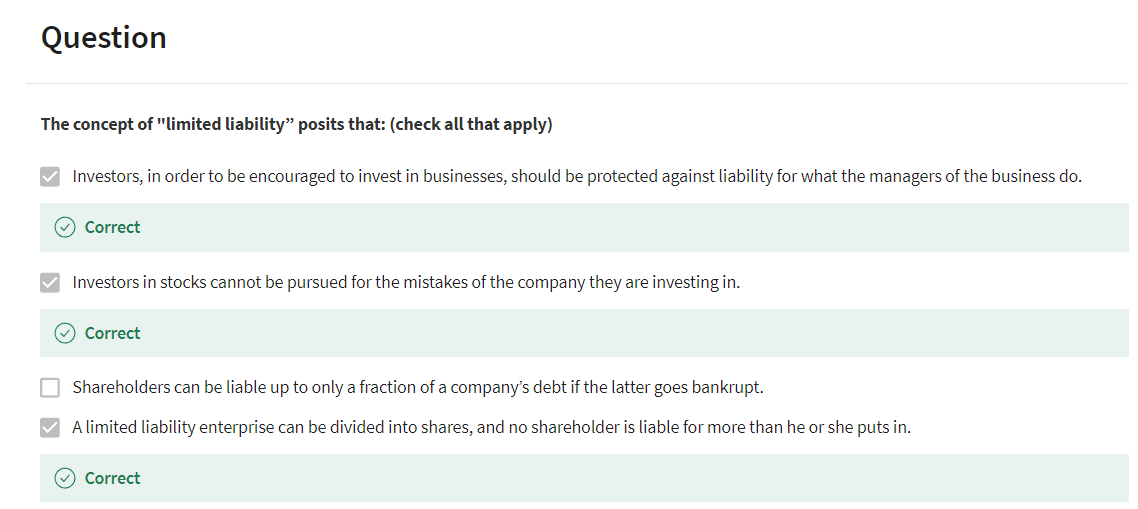
Investors in stocks cannot be pursued for the mistakes of the company they are investing in. 股票投资者不能因为所投资公司的错误而被追究责任。
Investors, in order to be encouraged to invest in businesses, should be protected against liability for what the managers of the business do. 为了鼓励投资者投资于企业,投资者应该受到保护,不为企业管理者的行为承担责任。
A limited liability enterprise can be divided into shares, and no shareholder is liable for more than he or she puts in. 有限责任企业可以分成股份,任何股东都不必为超过其投入的部分承担责任。
Inflation Indexed Debt
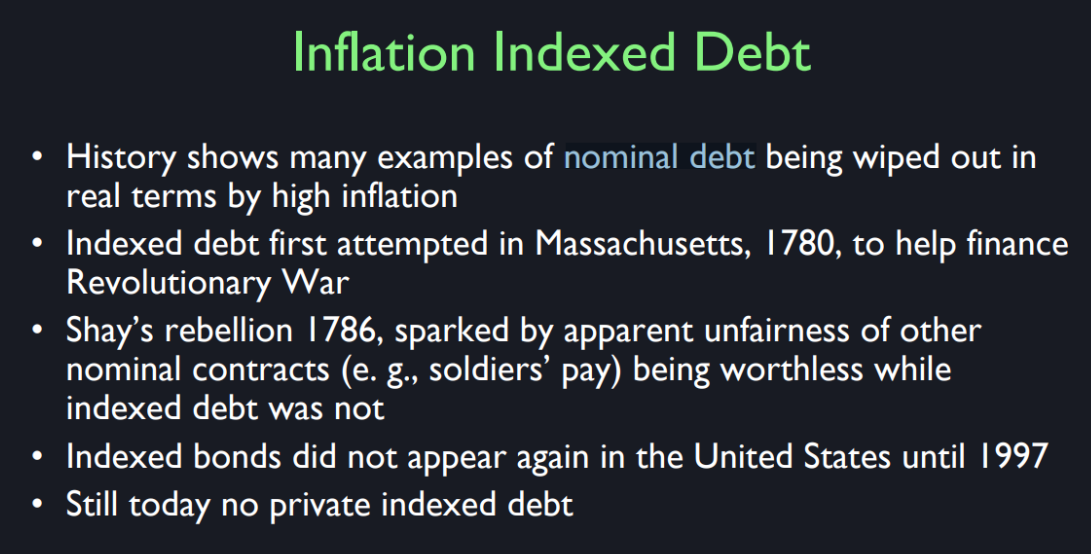
So I give you another example of
practical financial innovation. Towards here about inflation indexed debt. So we’ve always traditionally
borrowed money in debt contracts and promised to pay them back in the currency. But there are so many examples
where the currency is unstable, especially if the government prints it. They make big mistakes. So, the idea is,
why don’t we have a price index and have a debt contract that
pays back index to inflation? Then it’s fixed in real terms. What could be more obvious? But the history of it is very slow to get going. I’ve tried to find who is
the first person to define that in terms of a consumer price index. There were earlier examples. For example, in Japan, they had rice
bonds, and maybe other places too. So a rice bond was a debt instrument
that was payable in rice, yes, the grain, instead of a currency. And you’re safer with that than in
currency if the government might print money, and debase the currency. But the idea that I’m referring
to is something broader. The problem with rice bonds
is the price of rice isn’t stable relative to other prices. So you really want an index of prices. You want to tie the contract to an index. So, as far as I’ve been able to tell,
I wrote a paper about this.
The first indexed debt was invented
here in the United States in 1780, and it occurred because of inflation. The US Government was giving debt to the soldiers during the revolutionary war, denominated in currency that was
issued then by state governments. And they debase the currency because
of the war, it was rapid inflation. And the soldiers were really
unhappy because what they got was already worthless before they got it. And in order to keep the soldiers happy,
this was a necessity. As Plato said,
necessity is the mother of invention. He was quoting someone else, I believe,
but that’s where it appears. So they decided to define
a consumer price index. They didn’t call it that,
they just defined it. And the bond had to pay out
in inflation-indexed terms. And what a wonderful idea, its simple. You should promise them in real terms
not money terms, and then inflation. But there was a lot of other
people were paid in nominal debts. And there was an actual rebellion called
Shays’ rebellion about the unfairness of this debt. So, somehow the US government
didn’t issue them again.
Well, the indexed bonds in 1780
were issued by Massachusetts, but no state issued indexed
bonds again until 1997. I can’t believe that it took so long. I was there advocating, this is one
thing I advocated before it happened. Not that that necessarily made
a difference, but I just wonder about. It seemed impossible. I called treasury like in 1996 and
I said, I want to talk to someone here, why don’t you do inflation-indexed debt? And I got a guy on the phone and
he said, we’d thought of that. We have a joke here at treasury. And that is that if we ever do
issue inflation-indexed debt in the United States, we should send
the prospectuses to the members of the American Economic Association. because they’re the only ones
who would be interested. I said, how can that be? I mean, people are getting the real value
of their debt wiped out by inflation, don’t they care? I mean, and it still puzzles me
that it isn’t more important. People just don’t get it, they make
the same mistake again and again. They think, well, inflation is only 2%. But they don’t know that history shows
that governments messed up all the time. Now of course, this is America,
we don’t mess up here, I guess, you could say it patriotic feeling. You don’t want to raise the possibility
that we would mess up and have a lot of inflation. But maybe even if it isn’t a lot,
maybe how about 4% a year inflation, and you lose half your money
in 20 something years. That’s within the realm of possibility,
people don’t even think about it. But we do have inflation-indexed
debt in the United States, and it has spread around the world. Now, the US was not the beginning
of inflation-indexed debt in 1997, it was in 1780, I believe.
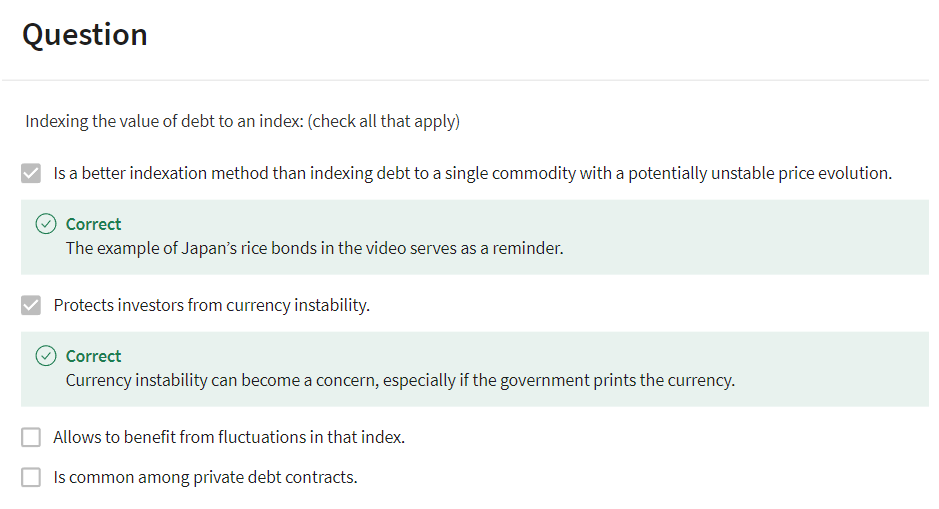
通胀指数债务(Inflation-indexed debt)指的是本金和/或利息支付会根据通胀率进行调整的一种债券或贷款。这种调整帮助保护投资的价值免受通胀侵蚀。
具体来说,对于通胀指数债券,本金额会定期根据特定的通胀指数(如消费者价格指数,CPI)进行调整。因此,利息支付也会随着通胀的变化而增加或减少,因为利息是根据调整后的本金计算的。
这意味着,如果通胀上升,债券的本金和利息支付都会增加,从而保护投资资金的购买力。反之,如果出现通缩,本金和利息支付可能会减少。
通胀指数债务的例子包括:
- 美国的通胀保值债券(TIPS)。
- 英国的指数联动国债(Index-linked gilts)。
- 加拿大的实值回报债券(RRBs)。
这些金融工具对于担心通胀会侵蚀其固定收益投资实际价值的投资者特别有吸引力。
Inflation-indexed debt refers to a type of bond or loan where the principal and/or interest payments are adjusted according to inflation rates. This adjustment helps protect the value of the investment against the eroding effects of inflation.
For instance, in the case of inflation-indexed bonds, the principal amount is adjusted periodically based on a specified inflation index, such as the Consumer Price Index (CPI). As a result, the interest payments, which are calculated as a percentage of the principal, also increase or decrease in line with inflation.
In practice, this means that if inflation rises, both the principal value and the interest payments of the bond will increase, preserving the purchasing power of the invested funds. Conversely, if there is deflation, the principal and interest payments may decrease.
Examples of inflation-indexed debt include:
- Treasury Inflation-Protected Securities (TIPS) in the United States.
- Index-linked gilts in the United Kingdom.
- Real Return Bonds (RRBs) in Canada.
These financial instruments are particularly attractive to investors who are concerned about inflation eroding the real value of their fixed-income investments.
**通胀指数债务(Inflation-indexed debt)**有着相对悠久的历史和广泛的应用。以下是其发展历史的简要概述以及当前的受欢迎程度:
历史背景
早期发展:
- 英国:世界上最早的通胀指数债券可以追溯到英国。英国政府在1981年首次发行了通胀指数债券(Index-linked Gilts),以保护投资者免受通胀影响。
其他国家的引入:
- 美国:美国在1997年引入了通胀保值债券(TIPS,Treasury Inflation-Protected Securities),这些债券使投资者能够获得与通胀挂钩的收益。
- 加拿大:加拿大在1991年发行了其首个通胀指数债券,称为实值回报债券(RRBs,Real Return Bonds)。
- 其他国家:许多其他国家随后也开始发行通胀指数债券,包括澳大利亚、瑞典和意大利等。
当前的受欢迎程度
在现代金融市场中,通胀指数债券继续受到投资者的青睐,特别是在以下情境下:
- 通胀预期上升:当市场预期未来通胀上升时,通胀指数债券变得特别有吸引力,因为它们能够保护投资者的购买力。
- 低利率环境:在低利率环境中,固定收益投资的实际回报率可能较低。通胀指数债券提供了一种保护手段,能够抵御潜在的通胀风险。
- 养老基金和长期投资:由于通胀指数债券提供了抵御通胀的保障,许多养老基金和长期投资者将其纳入投资组合,以确保长期购买力的稳定。
当前市场趋势
虽然通胀指数债券在某些时期会更受欢迎,但它们始终是投资组合中重要的组成部分,尤其对于那些希望在不确定的通胀环境中保护其投资的人而言。
- 市场波动:通胀预期和经济不确定性(如疫情、地缘政治风险等)常常会影响这些债券的受欢迎程度。
- 机构投资者的偏好:大型机构投资者,如养老基金、保险公司和主权财富基金,通常会将通胀指数债券视为对冲通胀风险的重要工具。
总结
通胀指数债务具有重要的历史背景和显著的市场价值。尽管其受欢迎程度可能随着经济环境和通胀预期的变化而波动,但它始终是金融市场中重要的一类工具,尤其对于那些寻求长期稳定回报的投资者而言。
History of Inflation-Indexed Debt
Early Development:
- United Kingdom: The earliest example of inflation-indexed bonds can be traced back to the UK. The British government first issued inflation-indexed bonds, known as Index-linked Gilts, in 1981 to protect investors from inflation.
Adoption by Other Countries:
- United States: The U.S. introduced Treasury Inflation-Protected Securities (TIPS) in 1997, allowing investors to receive returns linked to inflation.
- Canada: Canada issued its first inflation-indexed bond, called Real Return Bonds (RRBs), in 1991.
- Other Countries: Many other nations followed suit, including Australia, Sweden, and Italy.
Current Popularity
Inflation-indexed bonds remain popular among investors, particularly in certain contexts:
- Rising Inflation Expectations: When the market expects future inflation to rise, inflation-indexed bonds become particularly attractive because they protect investors’ purchasing power.
- Low-Interest Rate Environment: In a low-interest-rate environment, the real returns on fixed-income investments may be low. Inflation-indexed bonds offer a way to hedge against potential inflation risks.
- Pension Funds and Long-Term Investors: Due to their ability to protect against inflation, many pension funds and long-term investors include inflation-indexed bonds in their portfolios to ensure stable long-term purchasing power.
Current Market Trends
While the popularity of inflation-indexed bonds can fluctuate, they remain an important component of investment portfolios, especially for those seeking protection in uncertain inflationary environments.
- Market Volatility: Inflation expectations and economic uncertainties (such as pandemics, geopolitical risks, etc.) often influence the demand for these bonds.
- Institutional Investors’ Preference: Large institutional investors, like pension funds, insurance companies, and sovereign wealth funds, typically view inflation-indexed bonds as crucial tools for hedging against inflation risks.
Summary
Inflation-indexed debt has a significant historical background and considerable market value. Although their popularity may vary with changes in the economic environment and inflation expectations, they consistently serve as an essential tool in financial markets, particularly for those seeking long-term stable returns.
Unidad de Fomento

So here’s an invention that I’ve
been extolling now for 25 years. So far, I will note, well,
I shouldn’t say no success. I’ve gotten attention for it. But I think it won’t
happen in my lifetime, but we’ll do the Unidad de Fomento eventually. It’s coming. So let me tell you the invention. In 1967,
Chile was going through a hyperinflation. I mean, prices were just going up. I don’t know what it was,
1,000% a year or something like that. And people were distressed about it. When you got your paycheck,
you know what you did? You got your paycheck. Of course, you cash it immediately and you run to the store and
you spend the whole thing. Because by the end of the month,
[LAUGH] it won’t be worth anything. [LAUGH] So this is crazy. And so now the idea that Chile invented then was to create a new unit of account. In Spanish, unidad de fomento,
which means unit of development. I don’t know why they called it that,
but I can think of a better name. But that’s what they called it in 1967.
Now money has several functions. It’s a store value and a unit of
account and a means of transactions. You can separate out those functions. You can have a separate unit
of account that is not money. So they invented something called the UF,
a Unidad de Fomento, and they allowed its value to be
tied to the Consumer Price Index. Back then, they would publish in Chilean
newspapers every day the exchange rate between the, Escudo, which was the currency they had then,
and the UF. So I looked it up today. Now it’s a website,
used to be in the newspaper. Well, maybe it’s still in the newspapers. But there’s a website, valoruf.cl. I looked it up this morning and 1 uf is 25,655.55 pesos. Now you might wonder,
why did they pick such a big number? They didn’t, they picked some small, maybe
it was one to one, I don’t know exactly, in 1967. But they’ve had so
much inflation in their peso, that it’s up to 25,000 pesos per 1 UF. And that is worth,
at the current exchange rate, between peso and dollar, $35.92. So there’s been a huge increase, even though Chile has gotten its
inflation more under control, the price level has
still increased 50-fold, over 50-fold, since 1977. But the US is not the haven
of price stability either. Would you believe it, prices in the US
have gone up 24-fold since 1913? That’s not exactly a zero
inflation environment. And if you’re saving for your retirement,
for example, your grandmother buys you a savings bond that matures in 2050,
you should be worried, right? What is that going to be worth? So Chile had the escudo currency,
and between 1960 and 1975, they had so much inflation that they had to replace it with 1
escudo to 1,000 pesos. But then the peso then eroded away,
and they had to define a new peso, which was 1,000 old pesos. So we have something like a 50 million
fold increase in prices in Chile.
So why would anybody still
quote prices in pesos? I don’t know. There’s something about human psychology. But at least let’s give credit. The Chileans are the most advanced
country in the world in terms of dealing with inflation. When I was in Chile, I was giving
a talk at the Central Bank, and I said, whose idea was this? This is amazing. The whole world should be following to it. And then, you know what? Nobody knew whose idea it was, nobody. They think it’s a national embarrassment
because it reveals how much inflation they’ve had. I said, no, you are the world’s leader,
and the world ought to copy you. Eventually, they will.
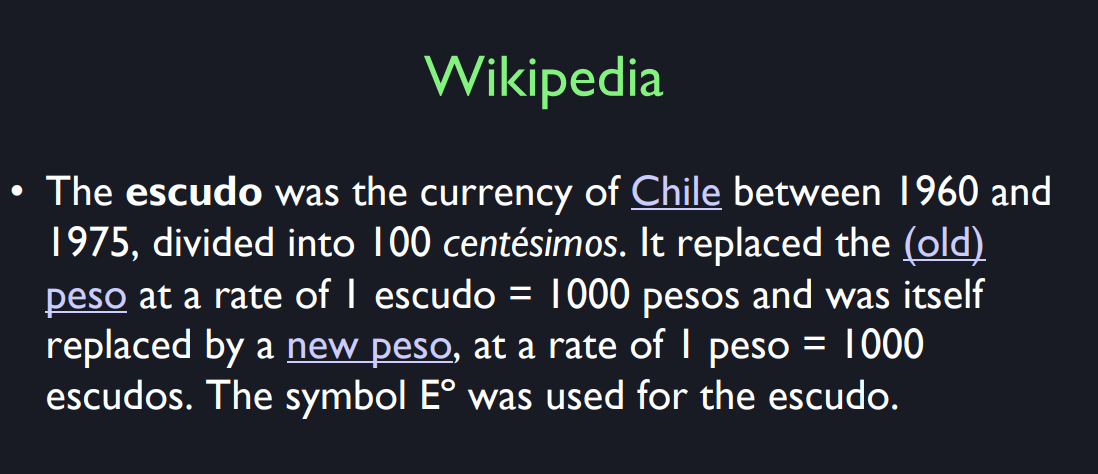
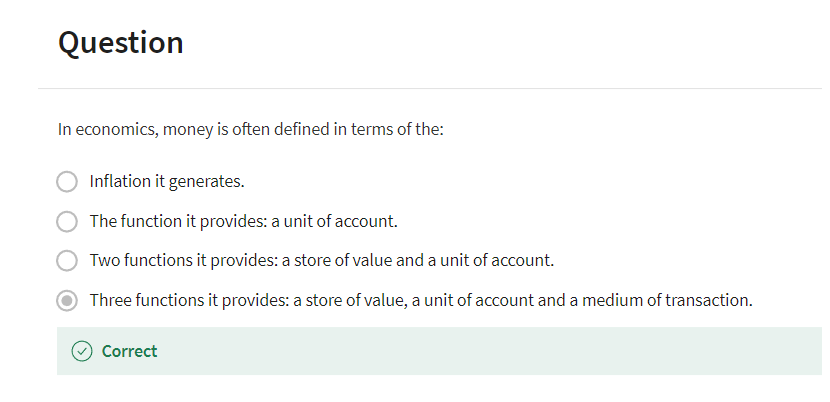
Unidad de Fomento(UF) 是智利的一种货币单位,主要用于调整和衡量经济活动中的货币价值,以应对通货膨胀带来的影响。UF的价值每天都会根据前一天的通货膨胀率进行调整。其主要特点和用途如下:
通货膨胀调整:
- UF的价值每天会根据智利的消费价格指数(CPI)进行调整,因此它能反映出货币的实际购买力。
- 这种调整机制使UF在通货膨胀期间保持相对稳定,保护货币价值不受通货膨胀的侵蚀。
使用场景:
- 房地产交易:很多房地产买卖合同和租赁协议都是以UF计价的。这可以防止因通货膨胀导致的货币贬值对合同金额的影响。
- 金融合同:银行贷款、抵押贷款和其他长期金融合同也常用UF计价。
- 公共服务费用:一些公共服务和公用事业费用也以UF计价,以保持费用的实际价值。
- 储蓄和投资:某些储蓄账户、保险合同和年金也会以UF计价,以确保其价值不会因通货膨胀而减少。
计算与发布:
- 智利中央银行负责计算并发布UF的每日价值。UF的价值通常在各大媒体和银行网站上公布,方便公众查阅。
历史背景:
- UF于1967年首次引入,目的是为了在高通货膨胀环境下提供一种稳定的价值衡量单位。自引入以来,UF已经成为智利经济中不可或缺的一部分。
总之,Unidad de Fomento 是一种旨在对抗通货膨胀影响的货币单位,通过每日调整其价值,使其在各种金融和经济交易中提供一种相对稳定的价值参考。这种机制在高通胀经济体中尤为重要,有助于确保合同和金融资产的实际价值不因通货膨胀而显著减少。
Unidad de Fomento (UF) is a unit of account used in Chile, primarily designed to adjust and measure the value of economic activities to counteract the effects of inflation. Here are its main features and uses:
Inflation Adjustment:
- The value of the UF is adjusted daily based on the previous day’s inflation rate, as measured by the Consumer Price Index (CPI) in Chile.
- This adjustment mechanism allows the UF to maintain a relatively stable purchasing power during periods of inflation.
Use Cases:
- Real Estate Transactions: Many real estate purchase contracts and rental agreements are denominated in UF. This prevents the devaluation of contract amounts due to inflation.
- Financial Contracts: Bank loans, mortgages, and other long-term financial agreements are often priced in UF.
- Public Service Fees: Some public services and utility charges are also priced in UF to maintain the real value of fees.
- Savings and Investments: Certain savings accounts, insurance contracts, and annuities are denominated in UF to ensure their value is protected from inflation.
Calculation and Publication:
- The Central Bank of Chile is responsible for calculating and publishing the daily value of the UF. The value is typically available in major media outlets and on bank websites for public reference.
Historical Background:
- The UF was introduced in 1967 to provide a stable unit of value in an environment of high inflation. Since its introduction, the UF has become an integral part of the Chilean economy.
In summary, the Unidad de Fomento is a monetary unit designed to combat the effects of inflation by adjusting its value daily. This mechanism is crucial in high-inflation economies, ensuring that contracts and financial assets retain their real value over time.
**通货膨胀(Inflation)和货币贬值(Currency Depreciation)**之间有密切的关系,但它们是不同的经济现象。下面解释它们之间的关系,并通过具体例子说明。
通货膨胀
通货膨胀是指物价普遍上涨的现象,导致货币购买力下降。换句话说,同样数量的货币在未来能够购买的商品和服务会比现在少。
货币贬值
货币贬值是指一种货币相对于其他货币的价值下降。通常是由于市场供求关系、经济政策、政治稳定性等因素导致的。
二者的关系
通货膨胀可以导致货币贬值,尤其是在通货膨胀率较高的情况下,因为高通货膨胀率往往会削弱外国投资者对该国货币的信心,导致该国货币对其他货币的汇率下降。
具体例子
例子:委内瑞拉的经济危机
通货膨胀:
- 背景: 委内瑞拉经历了多年经济动荡,政府过度发行货币以应对经济困境。
- 结果: 物价飞速上涨。例如,2018年委内瑞拉的通货膨胀率达到惊人的1,000,000%。
- 影响: 人们发现日常必需品如食品和药品的价格每天都在上涨。同样数量的玻利瓦尔(委内瑞拉货币)今天能够购买的物品,在明天可能只能购买一半甚至更少。
货币贬值:
- 背景: 由于国内严重的通货膨胀和经济不稳定,外国投资者失去了对委内瑞拉经济和玻利瓦尔的信心。
- 结果: 玻利瓦尔对美元等主要外币的汇率迅速下跌。例如,2018年初1美元约等于10玻利瓦尔,但到年底,1美元已经等于约248,000玻利瓦尔。
- 影响: 国际贸易成本大幅增加,进口商品价格飞涨,进一步加剧了国内的通货膨胀。
总结
通货膨胀和货币贬值相互影响。高通货膨胀会削弱货币的购买力,从而导致国际市场上该国货币的贬值。反过来,货币贬值也会使进口商品价格上涨,进一步推动国内通货膨胀。通过委内瑞拉的例子,我们可以看到这种恶性循环的实际影响。
Exchange rates of Renminbi
汇率是指一种货币相对于另一种货币的价格,它在国际贸易和金融活动中起着至关重要的作用。以人民币(CNY)和美元(USD)为例,可以更清楚地说明汇率的作用。
- 国际贸易
汇率直接影响到进出口商品的价格。
- 人民币贬值:如果人民币对美元贬值,例如从1美元兑换6.5元人民币变为1美元兑换7元人民币,中国的出口商品对美国买家来说变得更便宜,这可能会刺激美国对中国商品的需求。同时,美国的出口商品对中国买家来说变得更贵,这可能会减少中国对美国商品的需求。
- 人民币升值:如果人民币对美元升值,例如从1美元兑换6.5元人民币变为1美元兑换6元人民币,中国的出口商品对美国买家来说变得更贵,可能会减少美国对中国商品的需求。同时,美国的出口商品对中国买家来说变得更便宜,这可能会增加中国对美国商品的需求。
- 投资流动
汇率影响外国投资者在某国投资的成本和收益。
- 人民币贬值:如果人民币对美元贬值,外国投资者可能会发现他们的投资收益在兑换成美元时减少,从而降低他们在中国投资的意愿。
- 人民币升值:如果人民币对美元升值,外国投资者可能会发现他们的投资收益在兑换成美元时增加,从而增加他们在中国投资的意愿。
- 通货膨胀和物价水平
汇率变动对国内的物价水平和通货膨胀有直接影响。
- 人民币贬值:进口商品和原材料的成本上升,导致国内生产成本增加,进而推动物价上涨,可能引发通货膨胀。
- 人民币升值:进口商品和原材料的成本下降,可以抑制国内物价上涨的压力,甚至可能导致通货紧缩。
- 货币政策
中央银行可以通过干预外汇市场来影响汇率,从而实现宏观经济目标。
- 外汇干预:中国人民银行可以通过买卖外汇储备来影响人民币汇率。例如,卖出美元、买入人民币可以支撑人民币汇率,防止其过度贬值;反之,买入美元、卖出人民币可以抑制人民币升值。
- 利率调整:调整利率也可以影响汇率。提高利率可以吸引外国资本流入,推高人民币汇率;降低利率可以促使资本外流,压低人民币汇率。
- 旅游和教育
汇率影响旅游和留学的成本。
- 人民币贬值:中国居民出国旅游或留学的成本增加,因为他们需要更多的人民币兑换成外币。
- 人民币升值:出国旅游或留学的成本降低,中国居民更容易支付这些费用。
实际例子
- 中美贸易战:在中美贸易战期间,人民币对美元曾有贬值趋势。中国通过适度让人民币贬值,使得中国出口商品对美国更加有价格竞争力,以部分抵消美国关税的影响。
- 留学费用:假设某中国学生需要支付每年3万美元的学费。当汇率是1美元=6.5元人民币时,这需要支付195,000元人民币。如果人民币升值到1美元=6元人民币,那么只需要支付180,000元人民币,学费变得更便宜。
总结
汇率在国际贸易、投资、物价水平、货币政策以及个人消费等多个方面都起着重要作用。汇率波动会对经济产生广泛的影响,因此各国政府和企业都密切关注汇率变化并采取相应措施应对。
Exchange rates represent the value of one currency relative to another and play a crucial role in international trade, investment, and financial activities. Using the exchange rate between the Chinese Yuan (CNY) and the US Dollar (USD) as an example, we can better understand the importance and implications of exchange rates.
- International Trade
Exchange rates directly affect the prices of imported and exported goods.
- Renminbi Depreciation: If the Chinese Yuan depreciates against the US Dollar, for example, from 1 USD = 6.5 CNY to 1 USD = 7 CNY, Chinese exports become cheaper for American buyers. This could increase demand for Chinese goods in the US. Conversely, US exports become more expensive for Chinese buyers, potentially reducing demand for US goods in China.
- Renminbi Appreciation: If the Chinese Yuan appreciates against the US Dollar, for example, from 1 USD = 6.5 CNY to 1 USD = 6 CNY, Chinese exports become more expensive for American buyers, potentially decreasing demand for Chinese goods in the US. Conversely, US exports become cheaper for Chinese buyers, potentially increasing demand for US goods in China.
- Investment Flows
Exchange rates impact the cost and returns of foreign investments.
- Renminbi Depreciation: If the Yuan depreciates, foreign investors might see their investment returns decrease when converted back to their home currency, which could reduce their willingness to invest in China.
- Renminbi Appreciation: If the Yuan appreciates, foreign investors might see their investment returns increase when converted back to their home currency, which could increase their willingness to invest in China.
- Inflation and Price Levels
Exchange rate fluctuations affect domestic price levels and inflation.
- Renminbi Depreciation: The cost of imported goods and raw materials rises, increasing domestic production costs and potentially leading to higher prices and inflation.
- Renminbi Appreciation: The cost of imported goods and raw materials falls, reducing domestic price pressures and potentially leading to lower inflation or even deflation.
- Monetary Policy
Central banks can intervene in the foreign exchange market to influence exchange rates and achieve macroeconomic goals.
- Foreign Exchange Intervention: The People’s Bank of China can buy or sell foreign exchange reserves to influence the Yuan’s exchange rate. For example, selling US Dollars and buying Yuan can support the Yuan’s value, preventing excessive depreciation. Conversely, buying US Dollars and selling Yuan can curb the Yuan’s appreciation.
- Interest Rate Adjustments: Adjusting interest rates can also impact exchange rates. Raising interest rates can attract foreign capital inflows, increasing the Yuan’s value. Lowering interest rates can encourage capital outflows, decreasing the Yuan’s value.
- Tourism and Education
Exchange rates affect the cost of travel and education abroad.
- Renminbi Depreciation: Traveling or studying abroad becomes more expensive for Chinese residents, as they need more Yuan to exchange for foreign currency.
- Renminbi Appreciation: Traveling or studying abroad becomes cheaper for Chinese residents, as they need fewer Yuan to exchange for foreign currency.
Real-world Example
- US-China Trade War: During the US-China trade war, the Chinese Yuan experienced depreciation against the US Dollar. By allowing the Yuan to depreciate moderately, China made its exports more price-competitive in the US market, partially offsetting the impact of US tariffs.
- Study Abroad Costs: Suppose a Chinese student needs to pay $30,000 annually for tuition. When the exchange rate is 1 USD = 6.5 CNY, the cost in Yuan is 195,000 CNY. If the Yuan appreciates to 1 USD = 6 CNY, the cost drops to 180,000 CNY, making tuition more affordable.
Conclusion
Exchange rates are vital in various aspects of the economy, including international trade, investment, price stability, monetary policy, and personal consumption. Exchange rate fluctuations can have widespread economic impacts, prompting governments and businesses to closely monitor and respond to these changes.
Real Estate: Risk Management Devices
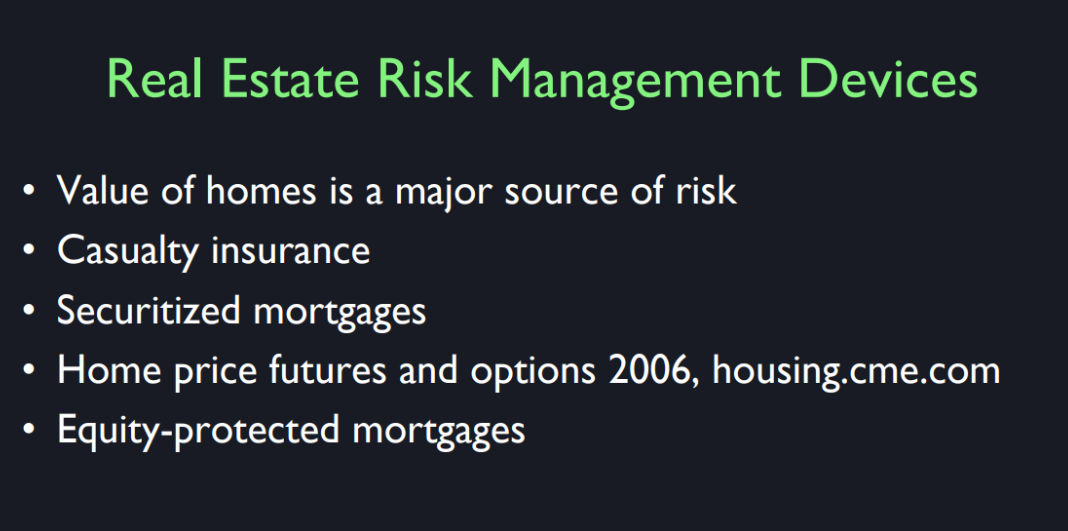
Finally, real estate risk management devices. Values of homes go up and down a lot and people are not protected against these fluctuations and this is bizarre to me. We have home insurance, casualty insurance that protects you against accidents in your home or you get protection against fires so why not protect them against the big risk, which is the change in value of your home. Are people who do things like short the financial markets good people or bad people? Shorting, is it evil to short a market? Well, if you’re shorting a market for homes in your own city, you’re just trying to protect yourself against the collapse. It’s not so evil. If you’re doing it to make billions of dollars it’s a little bit ambiguous, your moral stance. But anyway it’s legal, you can short markets and I thought it would be a good thing if people could short the housing market. It would help stop bubbles and it would help people protect themselves against this. There could also be a source of risk management for equity protected mortgages. You should have a mortgage that tells you when you buy a house, if your home price falls below the amount you owe, we’ll correct your debt downward. Isn’t that sensible? But that’s not what we did, not what we are doing. If you buy a house for $500,000, you borrow $450,000, the price of the house falls to 400,000, you are now $50,000 underwater. You go into your mortgage lender and you say, "I’m underwater. What do we do? " And the mortgage lender will typically say, “Tough luck, we’ll sue you. We’l go after you if you don’t pay?” Why do we leave it like that? Well, it’s because progress is slow.
When you talk a lot about financial innovations is there anything of recent that is really credit for you or that you think it’s, kind of, the next frontier of finance? There are many innovations. I don’t know where to begin. Well, but let me put it this way that most of our risks are still not managed well, for example, your home price risk. That is borne by you, the homeowner. I actually work with the Chicago Mercantile Exchange and we do have a futures market for single, and an options market, for single family homes so that you can buy a put option on your house to protect you against the big fall. That is up and running. I want to see it grow and get more more active but it is, it does exist. Another risk which is even bigger is the risk of your human capital that you are investing in now as a student. And now, you are an MBA student so you have chosen a very fungible form of human capital management. That has to be a very versatile skill that right, at least that sounds like it to me, that won’t be replaced by a computer. Now, it might be partly replaced by computers, in fact, it already has partly been replaced, I think. But, I think, that’s, but the question is, what if you pick a human capital that is more focused, like nuclear engineering. Now you could, how can you protect yourself against that risk to your human capital? Well, I have an idea how you could do it. You could short the stock of a nuclear power company, assume that it’s going to correlate negatively with your risk, so you can sort of do it. But I think there are other things that might be more appropriate for most people. I think that’s kind of requires some sophistication to pick a company and short it to protect yourself, your own human capital. President Obama in his State of the Union address for 2016 proposed wage insurance that when people lose their job and switch to a permanent job with a lower wage, there should be some pay out that would, insurance pay off for the loss of livelihood. I’ve advocated things like that, too, in my writings. I call it livelihood insurance. But I can keep coming up with there’s so many innovations and we don’t know which ones, but what we do know is that risk is not well-managed worldwide. And we also know that enterprises are not functioning well everywhere, that there are many places in the world where free enterprise and entrepreneurship seems limited, so there’s a lot of things to be innovated.
Lesson #5 Quiz
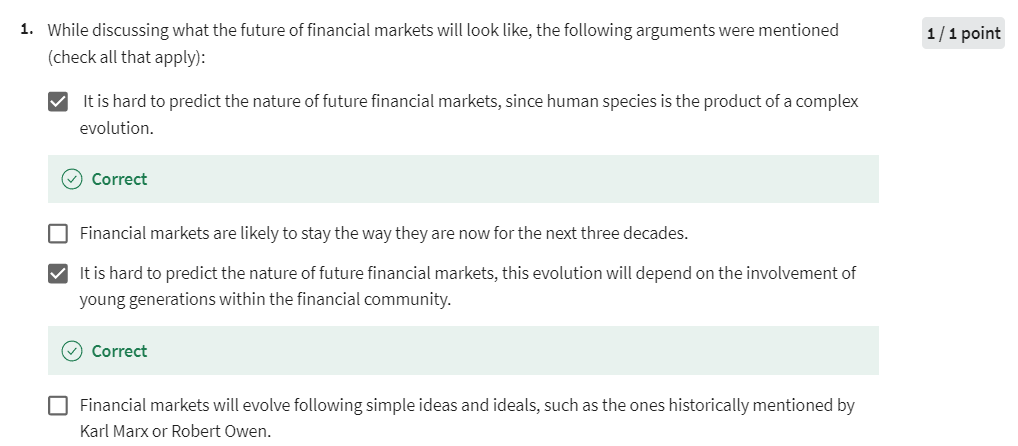


Lesson #6
Forecasting
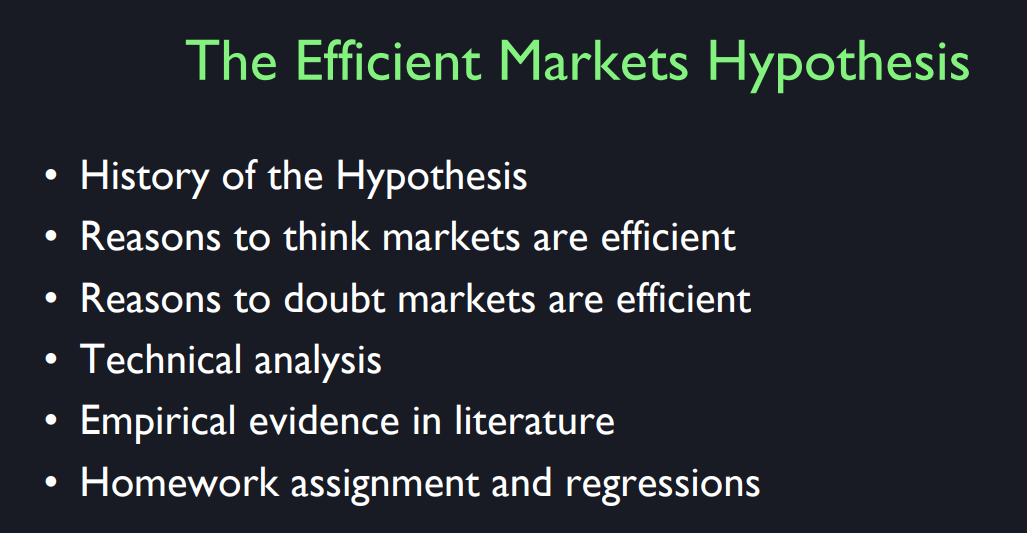
So today I want to talk about
the Efficient Markets Hypothesis. The history of the hypothesis, reasons
to think that markets are efficient, and reasons to doubt it. Let me start with the dinner
experiment on Friday.
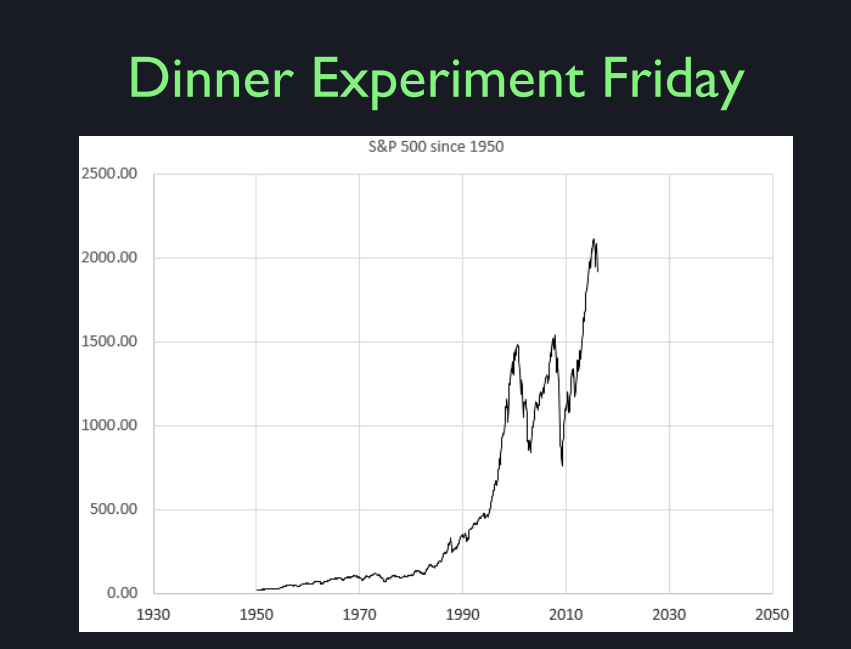
So we had a nice dinner at
Berkeley College, and as an experiment, those of you who were there
will know my experiment. I passed out slips of
paper with this chart. So the chart shows
the Standard & Poor’s 500 from 1950 until a couple days ago where it was. There it is, that is the stock market. And then I left room on the right,
up to the year 2050. And I asked each of you independently, and I asked you not to look at
each other when you did this, to pencil in a forecast for
the stock market from 2016 to 2050. So I’ll just give you a couple
examples that you filled in, this person is forecasting,
what does that look like? Another 20% drop in the market. Then a correction, then a drop, and then another boom, and
then another crash, and then another boom. So, I picked this one out as
just typical of what was seen. I should have shown you more, I only have
one other here, this is another one. So you are very pessimistic bunch.
What would Efficient Market Theory
say should be the forecast? There are one or two of you actually
did that, or maybe it was three, so more or less. If markets are completely unforecastable,
what should it be? Well, one interpretation
of efficient market, your forecast should have been zoom,
straight across, it’s not going to leave. I mean, the central tendency is, tomorrow’s price is
the same as today’s price. Because I can’t forecast changes up or
down, who knows? That would be efficient markets. But there is another version
of efficient markets and some of you actually did this,
but not many of you. Your forecast would be
not straight across but perfectly growing exponentially
along an exponential growth path. That would be the efficient
markets hypothesis taking account of the fact
that there’s a growth.
It’s not a random walk, but
it’s a random walk with growth. But almost none of you did that. Maybe my instructions
weren’t clear enough. But what you’re doing is
showing plausible paths for the stock market rather the expected path. That’s how people seem to interpret
when I say, please forecast it. You are trying to show what’s plausible. So you’re making,
if you look at the recent history, this person made it look like
the recent history, right? But this is not unless you can tell me,
I don’t know who did this forecast. But unless you can tell me, why did you have a turning point here in,
what year is that? 2020, why did you have this turning point, why did you have this turning
point where you put it? They have no reason, this looked plausible
to them so they called that a forecast. I know you might have done better if
you had more time to think about it. But I think this gets back to, it’s related to a concept in behavioral
economics that and talked about, those are two psychologists,
called the representativeness heuristic. People don’t behave like forecasters. They think that something
they saw in the past is representative of what
will happen in the future. Now I’m not defining their theory exactly,
but I think this is how most people take
it when they have to give a forecast.

The random walk theory is a theory,
first, the term was coined by statistician Karl Pearson in
the scientific journal Nature in 1905. And he said,
a random walk is a process that changes in such a way that each
change is independent of previous changes and
totally unforecastable. So it has become popular
lore to think of a random walk as the walk of a drunk
at a lamp post, okay? And this toy, right here, is a mock-up that someone once made and
sold. If you want that,
I found it on the web, you can buy it. It’s amazing [LAUGH]
what you can buy today. But there’s your drunk. Now if the drunk is so totally drunk
that every step is completely random, so your job, according to Pearson, is to forecast the position
of the drunk in 10 minutes, in 20 minutes, in 30 minutes, okay? So what is your forecast? What do you think? What would be Karl Pearson’s forecast? Well, the forecast is he’s going to
be right at the lamp post. And the reason you’d make that as your
forecast is you have no idea whether it’s to the right, or to the left, or
whatever the direction is random. So he’s probably not going to
be at the lamp post but since you can’t predict which way, you
might as well predict at the lamp post. That’s why I was saying on the previous
slide that, I’ll go back here. Your forecast should have been zoom
straight across if stocks are few or random walk. But that’s not what you did.
In 1973, Burton Malkiel who was
a professor at Princeton and, I guess, still is, he came to Yale for some years
as Dean of the Yale School of Management. But he wrote a best selling book in 1973
called A Random Walk Down Wall Street, arguing that, it wasn’t original in
the book, this was a popularization. But it’s a best seller and
it sold millions of copies. The idea was coming out then that stock
market prices are really random walks, it’s all an illusion that you
think you can forecast it. So, you shouldn’t try to forecast it. You should just hold
a diversified portfolio. And that became conventional wisdom,
starting around that time.
Burton Malkiel, his book was very well
timed and a very appropriate title. The funny thing about Malkiel’s book,
though, is that he didn’t really believe the efficient market hypothesis
that he made the title of his book. Because if you look in at
the last chapter of the book, he had investing advice and he told
you to do various things that, well, I thought inconsistent with
random walk hypothesis. I finally met him at a cocktail party. And I asked him, I said, some of your investment advice
doesn’t quite fit with random walk. And then he said, well, I know. I can’t quote him exactly, so
I can’t get these other kinds of thinking completely out of my mind,
something like that. So, it’s like psychologically, we’re not
attuned to understand the random walk.
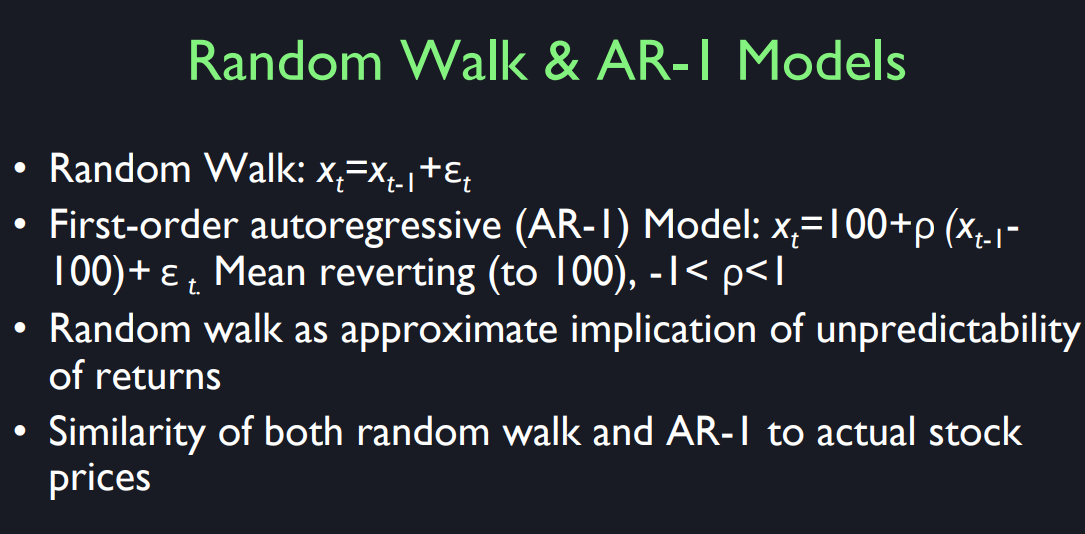
Now another alternative to a random walk,
a random walk has the property x sub t, if x is the random walk at time t,
is equal to its previous value plus noise epsilon sub t, and
the noise is totally unforecastable. An alternative to a random
walk model is a first-order autoregressive model, an AR-1 model. In this case, 100 represents the lamp
post, it’s the starting point. And then x sub t, the position at time t, is equal to the starting point +
rho where rho is between -1 and plus one, usually positive,
times xt -1- 100. So what this is, is a model which is modifying the drunk
at the lamp post a little bit. He’s now has a piece of elastic
wrapped around his ankle. And the elastic is tied to the lamp post. So if he starts walking away from
the lamp post in any direction, he gets tugged a little bit back to it. And the further away he goes,
the more he’s tugged back. So, in this case, this is xt-1-100 is how far
he is from the lamp post. And if rho is some high value, then, that means there isn’t that much of a tug,
that it’s a weak piece of elastic. So he can go wandering off, but
eventually, he’s going to come back. So this is mean reverting,
it’s reverting back to the lamp post.

Now the question is, there were a lot of studies suggesting
that the stock market is a random walk. But how do we know whether it’s
really a random walk or it’s an AR-1? Maybe when the stock market gets
really high, it’s going to go back. But not right away. But eventually, there’s something
tugging it back to a normal level. And when it gets really low,
it’s going to go back up. The problem is that it’s hard to
tell a distinction, if rho equals 1, you can see these hundreds drop out,
and it’s just a random walk. But if rho is lower than 1 but
not a whole lot lower than 1, then you really can’t tell whether
it’s a random walk or not. So this is an example of
a realization of a random walk, the blue line, and
an AR-1 with rho equals 0.9. And I defy you to tell me which one
of those is the, well, you can tell. In comparison,
this one started not at 100 but at 1, so you can see that the AR-1 it’s
come closer that’s the red line. It’s come closer back
to the starting point. The random walk has no tendency to
come back to the starting point. If stock prices are an AR-1, then it means
you should stay out of the market when the price is too high and
go back in when the price is too low. Which is different advice
than the random law theory.
Many would argue that when
you’re forecasting the future, whether economists or people in finance
who are working in Wall Street, for instance, forecasting what the future
of a market is going to look like, to look at what’s happened in recent
history, and try to project it forth. And using a rational, logic model-
Right. >> To try to project into the future. But, of course, you talk a lot about
sort of the irrational nature of the market and how we’re behavioral,
how we’re rational beings. But what I’m curious is, how do you
build in risk management to factor into sort of the irrational
nature of the markets and to capture sort of some of that irrational
exuberance that you talked about and the bubbles that might arise in
such things as housing markets?
Well, deep question, how do we handle? Why do we have irrational
exuberance at some times and not other times, and
what can we do about that [LAUGH]? Our principle to all that you talked
about is Central Bank policy. And Central Banks when they
think that the market is becoming overpriced, can tighten credit. And alternatively, when they think it’s
underpriced, they can loosen the credit. That is a tool that is being used. Although Central Banks don’t seem too
enthusiastic about trying to stabilize financial markets, it does seem to
influence their decision making. But that doesn’t get at
the basic psychology very much. So the problem is people are looking at the price of a speculative
asset as something largely separate from the underlying business that
is paying the bills, paying the dividends. They seem to often be looking
at the psychology of the market. They’re looking at trends
of technical analysis and they become unfocused on
the real fundamental which you might think ought to determine
the long run value of an investment. They’re focus is too much on the
short-term, predicting what it will do in the next month or so,
between the time I buy and sell. So there have been proposals
that might limit or reduce that short-term
speculative component.
So one idea is to put a transactions
tax on securities trades. So that would more force people to, or encourage them to be longer-term
in their investment. We have a distinct, that we have limited. We also have a capital gains tax that
distinguishes between short-term and long-term capital gains. And a reason to do that is to discourage
people from being short-term holders. They’ll end up paying
a capital gains tax on profit. There’s other longer term proposals. Mike O’Brennan at UCLA proposed that
we should create separate markets for corporate dividends at various horizons,
so that you’re focused on a dividend that some day in
the future you’re making an investment. You thought that would focus people
thinking on the fundamental. Well, now we do have markets for
claims and dividends that hasn’t
had any major impact. The problem is here that human
psychology is not easily managed. Talk to a psychiatrist and
you’ll hear that. We have antipsychotic drugs, they help,
but they don’t cure in a routine way. The same thing is true for anything you
might think of that might deal with irrational exuberance in the market. I wish we had lithium which is what
they use for irrational exuberance and bipolar disorder, but
it is not functioning in the stock market. >> Sure.
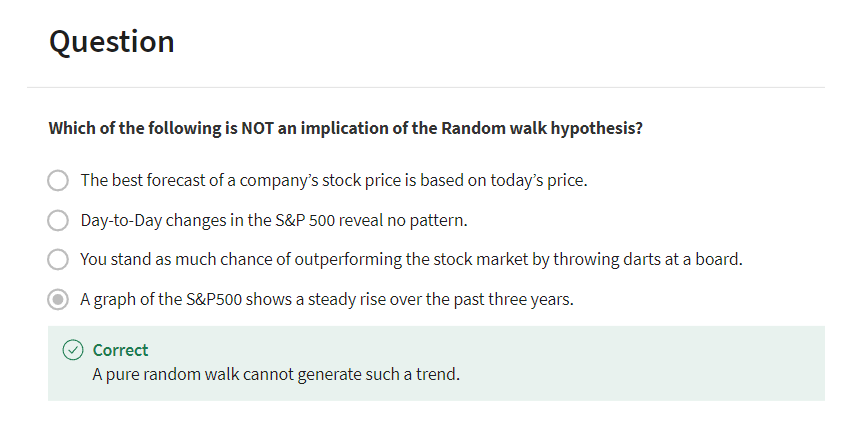
The key points of the professor’s talk can be summarized as follows:
Efficient Markets Hypothesis (EMH)
- Definition and History:
- EMH posits that market prices reflect all available information, making stock price movements unpredictable.
- An experiment with the S&P 500 index from 1950 to the present showed that most people’s predictions did not align with the random walk theory (an aspect of EMH).
Random Walk Theory
- Definition:
- Introduced by statistician Karl Pearson in 1905, it suggests that price changes are completely random and unpredictable.
- The analogy of a drunkard’s walk around a lamppost illustrates the random walk: predicting the drunkard’s future position means predicting the lamppost, as each step is random.
Autoregressive Model (AR-1 Model)
- Definition:
- An alternative to the random walk, assuming price changes are influenced by mean reversion.
- Prices deviate from the mean but gradually revert, though not immediately.
Behavioral Economics
- Representativeness Heuristic:
- People tend to predict future trends based on past patterns rather than adopting the random walk or mean reversion models.
Popularization of Random Walk Theory
- “A Random Walk Down Wall Street”:
- Burton Malkiel’s 1973 book advocates that stock prices follow a random walk and advises holding a diversified portfolio.
- Despite promoting EMH, Malkiel’s book includes some investment advice that doesn’t fully align with the theory.
Risk Management
- Market Psychology and Central Bank Policy:
- Central banks can tighten or loosen credit to address market overheating or cooling, but this doesn’t completely manage market psychology.
- Short-term speculative behavior is seen as a cause of market volatility and can be mitigated through measures like transaction taxes or differentiated capital gains taxes.
Conclusion
The professor discusses the history and theory of EMH, demonstrating the distinctions between the random walk theory and the autoregressive model, and analyzing the role of behavioral economics in market predictions. He also examines the role of central bank policies and market psychology in risk management, emphasizing the importance of reducing short-term speculation. Lastly, he notes the challenge of managing human psychology, making complete control over market fluctuations difficult.
教授的要点可以总结如下:
效率市场假说(Efficient Markets Hypothesis, EMH)
- 定义和历史:
- EMH主张市场价格反映所有可得信息,因此股票价格变动是不可预测的。
- 1950年代的标准普尔500指数预测实验显示,大多数人的预测并不符合EMH的随机漫步理论(random walk theory)。
随机漫步理论
- 定义:
- 由统计学家卡尔·皮尔森在1905年提出,认为价格变化是完全随机且不可预测的。
- 用醉汉在灯柱旁的行走来比喻随机漫步,预测醉汉的未来位置是灯柱,因为每一步的方向是随机的。
自回归模型(AR-1 Model)
- 定义:
- 是随机漫步的替代模型,假设价格变化受到平均回归(mean reverting)的影响。
- 价格偏离均值后会逐渐回归,但不会马上回归。
行为经济学
- 代表性启发法(Representativeness Heuristic):
- 人们倾向于用过去的模式预测未来,而不是采用随机漫步理论或平均回归模型。
随机漫步理论的普及
- 《漫步华尔街》:
- 伯顿·马尔基尔在1973年出版的书主张股市价格是随机漫步的,建议持有多样化的投资组合。
- 马尔基尔在书中仍然包含了一些与EMH不完全一致的投资建议。
风险管理
- 市场心理与中央银行政策:
- 中央银行可以通过紧缩或宽松信贷来应对市场过热或过冷,但难以完全管理市场心理。
- 短期投机行为被认为是导致市场波动的原因之一,可以通过交易税或资本利得税来减少。
总结
教授探讨了EMH的历史与理论,展示了随机漫步理论和自回归模型的区别,并分析了行为经济学在市场预测中的作用。他还讨论了市场心理和中央银行政策在风险管理中的角色,强调了减少短期投机的重要性。最后,他指出人类心理难以管理,因此市场波动难以完全控制。
Wall Street
华尔街简介
华尔街位于纽约市曼哈顿下城,是全球最重要的金融中心之一。它代表了美国的金融市场,并且是许多重要金融机构的所在地。以下是对华尔街的概述:
历史背景
- 起源:"华尔街"这个名字源于17世纪,当时荷兰定居者为了保护新阿姆斯特丹(现在的纽约市)免受英国和美洲原住民的攻击,修建了一道墙。这道墙就位于现在的华尔街位置。
- 发展:随着时间的推移,华尔街演变成了一个繁忙的商业和贸易中心。18世纪末,随着1792年《梧桐树协议》的签订和纽约证券交易所(NYSE)的成立,华尔街成为金融活动的核心。
金融机构和市场
- 纽约证券交易所(NYSE):位于华尔街11号,NYSE是全球市值最大的证券交易所,它在全球金融中扮演着重要角色。
- 纳斯达克(NASDAQ):尽管不在华尔街上,但纳斯达克通常与华尔街联系在一起。它是第二大证券交易所,并且以电子交易为主。
- 主要银行和公司:华尔街汇集了许多重要金融机构的总部和办公室,如高盛(Goldman Sachs)、摩根士丹利(Morgan Stanley)、摩根大通(JPMorgan Chase)、花旗集团(Citigroup)和美国银行美林(Bank of America Merrill Lynch)。
在全球金融中的作用
- 经济影响:作为全球金融中心,华尔街对世界市场有着重要影响。它吸引投资、促进贸易并推动经济政策。
- 金融服务:该地区提供广泛的金融服务,包括投资银行、资产管理、经纪和交易等。
文化和象征意义
- 美国资本主义的象征:华尔街代表了美国金融系统的力量和影响力,通常被用来指代整个金融部门。
- 文化参考:华尔街出现在许多电影、书籍和媒体中,往往象征着资本主义的繁荣与过度。术语“华尔街”有时被用来描述金融市场和大企业。
近期发展
- 技术进步:随着金融科技、电子交易和高频交易的兴起,华尔街不断适应并将先进技术融入其运作。
- 监管:2008年金融危机后,华尔街面临更多的监管审查,以防止未来的经济崩溃。像《多德-弗兰克法案》这样的改革旨在提高透明度并减少金融市场的风险。
结论
华尔街不仅仅是纽约市的一条街道,它是全球金融系统的中心,影响着经济,推动金融创新,并象征着现代资本主义的复杂性。
Wall Street is a significant financial district located in Lower Manhattan, New York City. It is synonymous with the American financial markets and is home to some of the most important financial institutions in the world. Here’s an overview:
Historical Background
- Origins: The name “Wall Street” originates from the 17th century when a wall was constructed by Dutch settlers to protect the New Amsterdam settlement from British and Native American attacks. The wall was located on what is now Wall Street.
- Development: Over time, Wall Street evolved into a bustling center for commerce and trade. By the late 18th century, it became the hub of financial activities with the establishment of the New York Stock Exchange (NYSE) in 1792 under the Buttonwood Agreement.
Financial Institutions and Markets
- New York Stock Exchange (NYSE): Located at 11 Wall Street, the NYSE is the largest stock exchange in the world by market capitalization of its listed companies. It plays a critical role in global finance.
- NASDAQ: Although not physically located on Wall Street, NASDAQ is often associated with it. It’s the second-largest stock exchange and operates electronically.
- Major Banks and Firms: Wall Street hosts the headquarters and offices of major financial institutions such as Goldman Sachs, Morgan Stanley, JPMorgan Chase, Citigroup, and Bank of America Merrill Lynch.
Role in Global Finance
- Economic Impact: Wall Street is a global financial hub that significantly influences world markets. It attracts investment, facilitates trade, and drives economic policies.
- Financial Services: The district offers a wide range of financial services, including investment banking, asset management, brokerage, and trading.
Cultural and Symbolic Significance
- Symbol of American Capitalism: Wall Street represents the power and influence of the U.S. financial system. It’s often used as a metonym for the financial sector as a whole.
- Cultural References: Wall Street has been featured in numerous films, books, and media, often symbolizing both the prosperity and the excesses of capitalism. The term “Wall Street” is sometimes used to describe financial markets and big businesses in general.
Recent Developments
- Technological Advances: With the rise of fintech, electronic trading, and high-frequency trading, Wall Street has adapted to incorporate advanced technologies into its operations.
- Regulations: Post-2008 financial crisis, Wall Street has seen increased regulatory scrutiny to prevent future economic collapses. Reforms like the Dodd-Frank Act aim to increase transparency and reduce risk in financial markets.
Conclusion
Wall Street is more than just a street in New York City; it is the epicenter of the global financial system, influencing economies, driving financial innovation, and symbolizing the complexities of modern capitalism.
Intuition of Efficiency

So let me just talk about what, I mean, I gave you history of thought, sort of about market efficiency. And and what people have thought over the time. Starting in the 19th century, information technology began to develop. There was a man named Reuter, who in just before the invention of the telegraph, decided that stock markets need up-to-date information. And so, he thought, how “How can I get information fair or of sell information?” So what he does is, these pigeons fly faster than any human transport, carrier pigeons. So what he did is he set up offices in major European cities and bought pigeons. And pigeons, and as soon as some market event happened in London, he would tie a piece of paper to the leg of the pigeon in London and send the news to Paris. And how long will it take a pigeon to fly from London to Paris? I don’t know. It takes 4-6 hours for a pigeon to fly from London to Paris. So it gave a trading advantage to people. So he was a big success with his pigeon service, and later, when they invented the telegraph. That that was here in New Haven, By the way way, Samuel F. B. Morse invented the telegraph. What year was that? Wasn’t it around 1840? I don’t remember exactly. The Reuter went to the telegraph to speed it up even more.
By the late 19th century, everyone was getting information with the speed of electricity. And they got beepers in the 20th century installed that would beep them when there were some important news. They would carry that around. Even before you had a cell phone, you could get a beeper. So the idea is that the information, there’s so many smart people trying to get information. It must be hard to beat the market and that means that you really can’t predict it. So the random work became plausible because people thought, “Yeah, all these people are trying so hard to get the information as quickly as they can and they trade on it as soon as they get it.” So doesn’t that mean that if anyone has some idea, so if the market goes down in London, it will probably go down in Paris too. So if the London market falls, you would like to sell in Paris. The problem is you can’t get the information in Paris fast enough. But now that they get it really fast. the market must adapt, adjust almost immediately. So this is what it came to.
The reason efficient market sounds plausible is you have to educate people out of naive ideas that they can predict the market. So some people will go to their broker and say, “You know, the other day I read in the Wall Street Journal that this company has a new drug that’s about to come out, so is that a reason for me to buy?” Then, the broker will tell you, “You read it when, last week?”. Your broker might say, “When that news came out, I remember my beeper went off immediately and I rushed to my colleagues and said, what’s this news mean?” And someone said, “Sell, sell right now.” So I placed an order in 15 seconds. He had it and said, “You got to beat the others.” And then I said, “I just saw but I hadn’t even had 15 seconds to talk about it.” They talked more about it and they think, “Well, maybe I shouldn’t have sold.” So 30 seconds later, you buy. And then within two minutes, they’ve got got an expert advice on what it means and the market has gone wild, and now it sells down at the new optimal level. So, maybe the market wasn’t perfectly efficient for 15 seconds. But you had better be educated that if you read something in the newspaper last week week, it’s already incorporated into in the market prices. Even in 1889, it oh, I didn’t have beepers then.
A moment’s reflection should convince that person that a function which occupies so important a place in the mechanism of modern business must be a useful and necessary part of the economy片刻的思考应该使那个人相信,在现代商业机制中占有如此重要地位的一项职能一定是经济中有用和必要的一部分
Here’s a 1904 article, it’s a really nice article by Charles Conant. In in a magazine, and it’s about the beauty of markets, and he was referring to the public. He referred to a ignorant public view that markets are a sort of gambling casino. But he said, a “A moment’s reflection should convince that person that a function which occupies so important a place in the mechanism of modern business must be a useful and necessary part of the economy.” Yeah, what he’s getting at is that those prices in markets are the result of people trying to figure out values, and if we didn’t have the markets, we wouldn’t know what anything was worth. Any business plan involves prices. As a business, you’re going to have to buy commodities or you’re going to have to borrow at interest rate. All these prices are relevant to an intelligent decision. So not only are markets efficient in the current economy, they’re better knowledge than any individual because it involves so many people of all putting their money on the line and trading them. And then it produces values which he implicitly assumes in 1904, are the best estimate of fundamental value, and then it drives businesses and make decisions, whether to build a new factory or to hire new people based on these prices. So it’s a beautiful system that he talks about. Until the financial crisis.
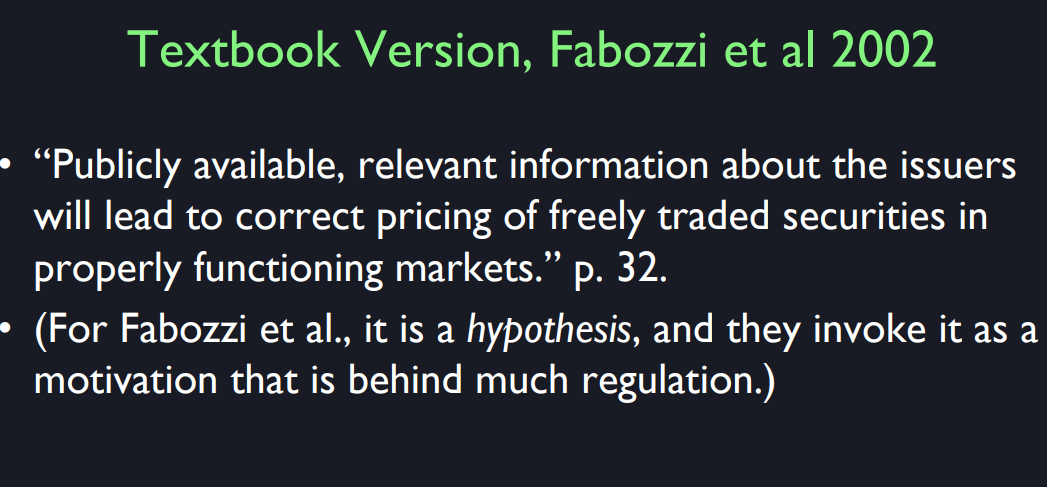
Textbooks were glowing in defense of the financial market. Even your textbook Fabozzi those in an earlier edition in 2002 said, “Publicly available, relevant information will lead to correct pricing of freely traded securities in properly functioning markets.” Here’s another textbook of finance by Richard Brealey and Stewart Myers in an earlier edition.
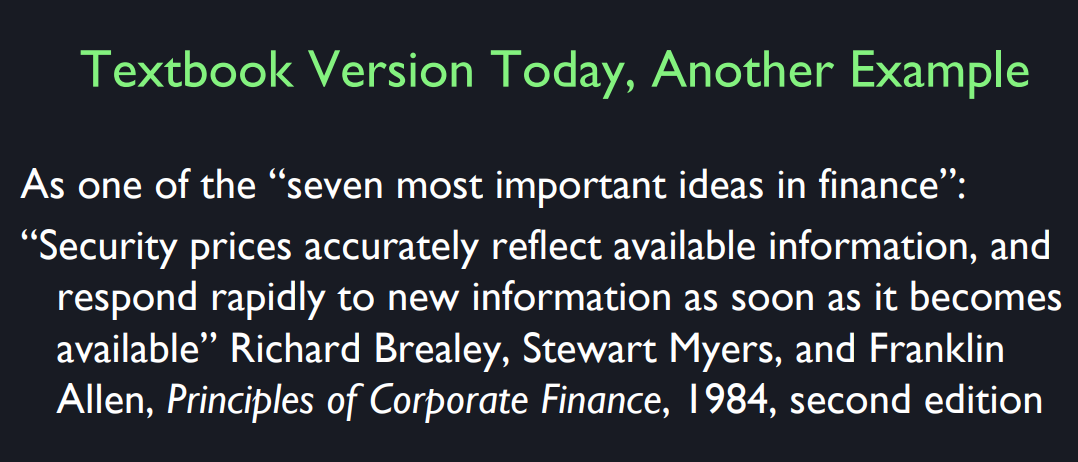
Security prices accurately reflect the available information, and respond rapidly to new information as soon as it becomes available 证券价格准确地反映了可获得的信息,并在新信息出现时迅速作出反应
Efficient markets really took hold the theory in people’s thinking, starting after [inaudible] book. It really was intellectual revolution. But according to Brealey, Myers and Allen. “Security prices accurately reflect the available information, and respond rapidly to new information as soon as it becomes available.” That’s a pretty strong statement, and then they did qualify it. “Don’t misunderstand the efficient markets idea. It doesn’t say that there are no taxes or costs. It doesn’t say that there aren’t some clever people and some stupid ones. It merely implies that competition in capital markets is very tough. There are no money machine, and security prices reflect the true underlying value of assets.” So he’s not really qualified. They’re not really qualifying it very much. They’re telling you to believe prices you see in the markets as if they were truth.
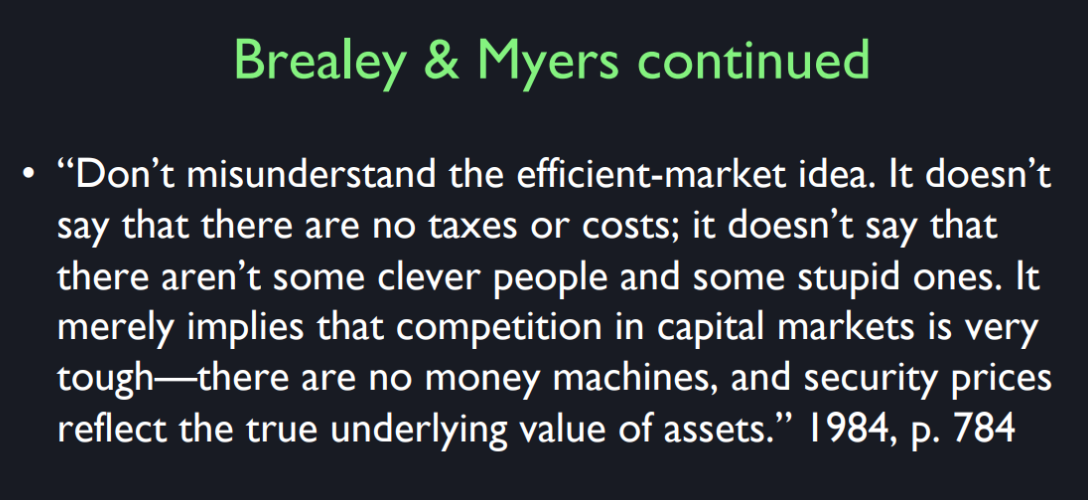
They have subsequently however, in their 2000 a day eighth edition edition, this is after the beginning of the financial crisis. They have qualified it. I don’t mean to laugh. They’re great people. They’re reflecting, when you read a textbook, the ideas of the time. But I’m just using this as a sign of how much. Thinking has changed. They now say say, “Much more research is needed before we have a full understanding of why asset prices sometimes get so out of line with what appears to be their discounted future payoffs.”
Much more research is needed before we have a full understanding of why asset prices sometimes get so out of line with what appears to be their discounted future payoffs 在我们完全理解为什么资产价格有时会如此偏离其贴现的未来收益之前,还需要进行更多的研究
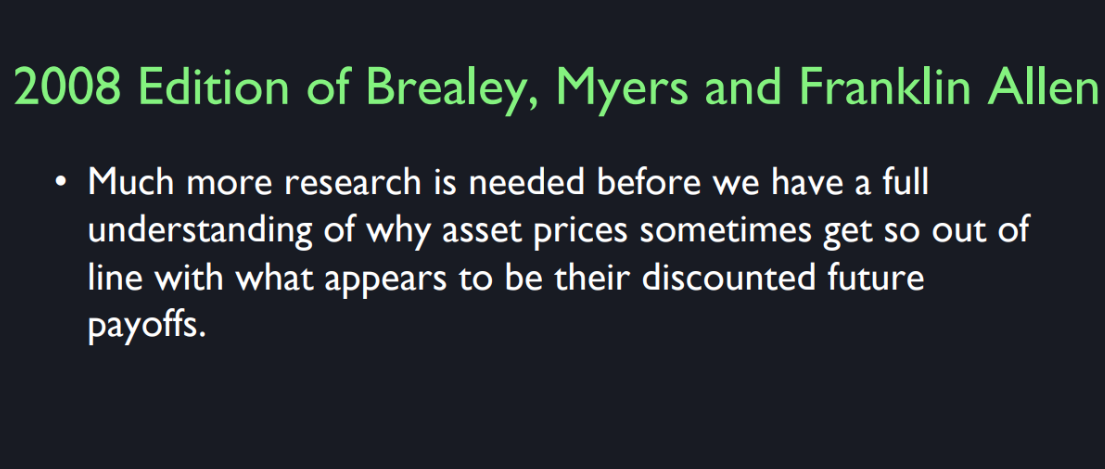
So the efficient markets hypothesis has taken a hit after the financial crisis, and you can see it in the textbooks. So, I think efficient markets is like that it was a scientific revolution that came out really in the '60s, and then the '70s, and it led to the extreme bull market that we had around the world in the 1990’s. People then finally decided that whatever the stock market does is right. Whatever the housing market does is right because its markets are efficient, and that unfortunately wasn’t quite right.
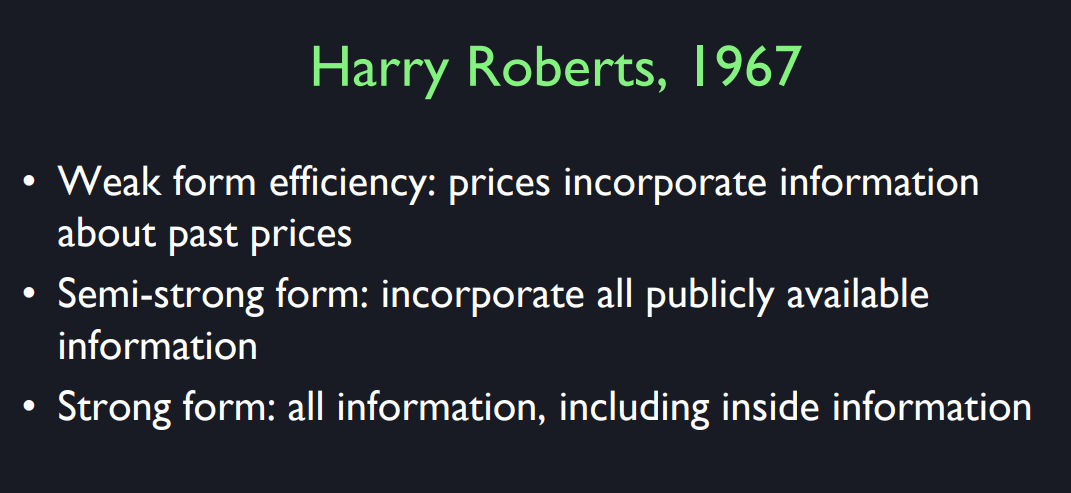
Harry Roberts is the coiner of the term efficient markets. Although I’ve traced the history back almost 100 years before him they didn’t call it the efficient markets hypothesis. He said there are three forms for market efficiency. Weak form is that information in past prices can’t help you to forecast, the semi-strong form of efficient markets is that all publicly information is already incorporated in the market prices, and the strong form is that all information including inside information held by the companies is already incorporated in the stock prices, prices because it leaks out. Companies can’t keep secrets. Actually, I think this semi-strong form is the one that we focus on. I don’t think that companies can’t keep secrets. They sometimes leak out but they don’t always leak out.
哈里·罗伯茨(Harry Roberts)提出了市场有效性(Efficient Markets)的概念,并将市场有效性分为三种形式:弱式有效市场、半强式有效市场和强式有效市场。这三种形式描述了市场价格反映信息的程度。以下是对每种形式的介绍:
- 弱式有效市场
- 定义:在弱式有效市场中,市场价格已经反映了所有历史价格和交易量数据。这意味着过去的交易信息已经被纳入当前的股票价格中。
- 含义:技术分析(依赖于过去价格走势来预测未来价格)无法持续获得超额收益,因为过去价格中的任何信息都已经反映在当前价格中。
- 例子:如果某只股票在过去一个月内价格持续上涨,弱式有效市场认为,仅凭这个趋势无法可靠地预测未来的价格走势。
- 半强式有效市场
- 定义:在半强式有效市场中,市场价格反映了所有公开可获得的信息,包括历史数据、财务报表、新闻发布以及其他公开声明。
- 含义:基本面分析(基于公开的财务数据来评估股票)无法持续跑赢市场,因为所有的公共信息已经被纳入股票价格中。
- 例子:如果一家公司宣布收益大幅增长,股票价格会几乎立即调整以反映这一新信息,使得投资者在公告之后难以从这一信息中获利。
- 强式有效市场
- 定义:在强式有效市场中,市场价格反映了所有信息,包括公开信息和内部(内幕)信息。这意味着没有人能够获得超额收益,因为所有信息都已经反映在市场价格中。
- 含义:内幕交易不会导致异常利润,因为即使是私人信息也已经反映在股票价格中。此级别的有效性假设市场是完美的,所有信息无论其来源如何,都会立即反映在股票价格中。
- 例子:如果一家公司的CEO知道即将发生的并购交易但尚未公开,强式有效市场认为股票价格已经反映了这一信息,使得CEO无法从这一知识中获利。
总结来说,哈里·罗伯茨提出的市场有效性理论分为弱式、半强式和强式有效市场。这三种形式分别描述了市场价格反映不同类型信息的程度,并对投资者基于历史数据、公开信息和内部信息获取异常收益的能力产生不同的影响。
Harry Roberts, who coined the term “efficient markets,” identified three forms of market efficiency: weak, semi-strong, and strong. These forms of market efficiency describe how well market prices reflect available information. Here’s an introduction to each form:
- Weak Form Efficiency
- Definition: In weak form efficiency, market prices reflect all historical price and volume data. This implies that past trading information is already incorporated into current stock prices.
- Implications: Technical analysis, which relies on past price movements to predict future prices, would not be able to consistently achieve superior returns because any information contained in past prices is already reflected in current prices.
- Example: If a stock’s price increased steadily over the past month, weak form efficiency suggests that this trend alone would not provide a reliable basis for predicting future price movements.
- Semi-Strong Form Efficiency
- Definition: In semi-strong form efficiency, market prices reflect all publicly available information, including historical data, financial statements, news releases, and other public announcements.
- Implications: Fundamental analysis, which evaluates a stock based on publicly available financial data, would not be able to consistently outperform the market because all public information is already incorporated into stock prices.
- Example: If a company announces a significant increase in earnings, the stock price will adjust almost immediately to reflect this new information, making it difficult for investors to benefit from this information after the announcement.
- Strong Form Efficiency
- Definition: In strong form efficiency, market prices reflect all information, both public and private (insider) information. This means that no one can achieve superior returns because all information is already priced into the market.
- Implications: Insider trading would not result in abnormal profits since even private information is reflected in stock prices. This level of efficiency assumes that markets are perfect and all information, regardless of its source, is immediately incorporated into stock prices.
- Example: If a company’s CEO knows about a future merger that has not yet been made public, strong form efficiency suggests that the stock price would already reflect this information, making it impossible for the CEO to profit from this knowledge.
In summary, the three forms of market efficiency proposed by Harry Roberts—weak, semi-strong, and strong—describe the extent to which market prices incorporate different types of information. Each form of efficiency has different implications for the ability of investors to achieve abnormal returns based on historical data, public information, and insider information.
So my first question is, so the efficient market hypothesis was stated 50 years ago, but why is it still a hypothesis? Shouldn’t there be enough research and data to whether either accept or reject it? And even more puzzling, how was the Nobel Prize awarded to someone who clearly advocates this theory, Eugene Fama, and someone who’s saying, this theory, and you at the same time?
There’s a lot of things I have to say about this topic. One of them is even more than 50 years old. They didn’t call it the efficient markets hypothesis, but going back centuries, there were people who thought markets are wonderful and perfect. They may not have articulated it well. The term efficient markets was popularized by Eugene Fama, who won the Nobel Prize with me. I actually am a big admirer of Eugene Fama, and his papers, honest, were very interesting. I would say that the efficient markets hypothesis is a half truth. It’s sort of true. It’s good. I try to teach it to you. I hope I taught it. Maybe I didn’t go far enough in extolling it, but it’s useful for you to think of that if you want to go into investing because you probably have exaggerated expectations of for what you can do. So, I said that Eugene Fama would be pleased to hear this. But then then, I have also a sense that it’s not that efficient, it’s not that perfect and that we shouldn’t trust it. So someone listening to efficient markets theory might say that the head of a Central Bank should never comment on the stock market because the stock market itself is smarter than any individual.
And now now, I think maybe they shouldn’t usually comment on it, but there are times when the market looks crazy. And I’m sorry, I think that the Fed or the Central Bank head is smarter than the market, often at least, not always, and I ought to come out to make an opinion on that. And also, that certain anomalies have appeared. For example, buying stocks with low price earnings ratios has paid off historically for a long time. I think that that’s probably best explained by psychological theories theories, that some stocks become ignored and they get underpriced because nobody remembers them. Others get overpriced because they’re hot. hot. Isn’t it something to keep in mind to understand the market fluctuation? So it is a hypothesis. I would say maybe it’s wrong to call it a hypothesis. The better name for it would be the efficient markets half truth.
尤金·法玛(Eugene Fama)是金融经济学领域的一位重要学者,以其对市场有效性理论(Efficient Market Hypothesis, EMH)的研究而闻名。以下是对尤金·法玛及其贡献的介绍:
个人背景
- 出生:尤金·法玛出生于1939年,是美国经济学家和学者。
- 教育:法玛在塔夫茨大学(Tufts University)获得学士学位,在芝加哥大学(University of Chicago)获得工商管理硕士和博士学位。
- 职业生涯:他在芝加哥大学布斯商学院(Booth School of Business)担任教授,并且是芝加哥大学的资深学者。
市场有效性理论
尤金·法玛最著名的贡献是其在1960年代和1970年代提出和发展的市场有效性理论。该理论假设金融市场是“有效的”,即所有可获得的信息都已经反映在证券价格中。这一理论可以分为三种形式:
- 弱式有效市场:认为所有的历史价格信息都已经反映在当前的股票价格中。
- 半强式有效市场:认为所有公开信息(如财务报表和新闻公告)都已经反映在股票价格中。
- 强式有效市场:认为所有信息,包括内部信息,都已经反映在股票价格中。
研究与影响
- 随机漫步理论:法玛通过其研究支持了股票价格遵循随机漫步的观点,即股票价格变化是不可预测的,因而技术分析和基本面分析在市场中无法持续获得超额收益。
- 资产定价模型:他还对资本资产定价模型(CAPM)进行了深入研究,并进一步发展了三因素模型(Fama-French Three-Factor Model),该模型引入了规模和价值因素,解释了市场中的资产回报。
主要成就
- 荣誉与奖项:尤金·法玛在2013年获得了诺贝尔经济学奖,表彰他在“实证分析资产价格”方面的贡献。这一奖项肯定了他在金融经济学领域的开创性工作和深远影响。
- 著作与论文:法玛撰写了大量的学术论文和书籍,对现代金融理论的发展产生了深远影响。他的研究不仅在学术界广受认可,也对实际投资实践和金融市场监管产生了重要影响。
总结
尤金·法玛是现代金融经济学的奠基人之一,以其市场有效性理论和资产定价模型的研究而著称。他的工作为理解金融市场如何运作提供了理论基础,并对投资策略、市场预测和金融政策制定具有重要意义。
Eugene Fama is a prominent figure in the field of financial economics, known for his work on the Efficient Market Hypothesis (EMH). Here is an introduction to Eugene Fama and his contributions:
Personal Background
- Birth: Eugene Fama was born in 1939.
- Education: He earned his bachelor’s degree from Tufts University and his MBA and Ph.D. from the University of Chicago.
- Career: Fama is a professor at the University of Chicago Booth School of Business and a distinguished scholar at the university.
Efficient Market Hypothesis
Eugene Fama is best known for developing the Efficient Market Hypothesis in the 1960s and 1970s. The EMH posits that financial markets are “efficient,” meaning that all available information is already reflected in security prices. The theory is categorized into three forms:
- Weak-form Efficiency: All past trading information is reflected in stock prices.
- Semi-strong Form Efficiency: All publicly available information is reflected in stock prices.
- Strong-form Efficiency: All information, including inside information, is reflected in stock prices.
Research and Impact
- Random Walk Theory: Fama’s research supports the idea that stock prices follow a random walk, meaning that price changes are unpredictable, making it difficult for investors to consistently achieve excess returns through technical or fundamental analysis.
- Asset Pricing Models: He extensively studied the Capital Asset Pricing Model (CAPM) and developed the Fama-French Three-Factor Model, which incorporates size and value factors to explain market returns.
Major Achievements
- Awards and Honors: In 2013, Eugene Fama was awarded the Nobel Prize in Economic Sciences for his empirical analysis of asset prices. This award recognized his groundbreaking work and significant contributions to financial economics.
- Publications: Fama has authored numerous scholarly papers and books that have profoundly influenced the field of finance. His work is widely cited and has had a substantial impact on both academic research and practical investment strategies.
Summary
Eugene Fama is a foundational figure in modern financial economics, renowned for his Efficient Market Hypothesis and asset pricing models. His research has provided a theoretical basis for understanding how financial markets operate and has significant implications for investment strategies, market forecasting, and financial regulation.
虽然Harry Roberts确实提出了“有效市场”这个术语,但尤金·法玛(Eugene Fama)因其对有效市场假说(Efficient Market Hypothesis, EMH)的系统性发展和深入研究而出名。他对有效市场理论的贡献使他成为这一领域的代表性人物。以下是尤金·法玛在有效市场假说方面的关键贡献:
尤金·法玛的贡献
- 系统化与理论化:
- 尤金·法玛在1960年代和1970年代系统化了有效市场假说,提出了市场效率的三种形式:弱式、半强式和强式。
- 弱式有效市场:所有过去的交易信息都反映在股价中。
- 半强式有效市场:所有公开可得的信息都反映在股价中。
- 强式有效市场:所有信息,包括内部信息,都反映在股价中。
Price as PDV
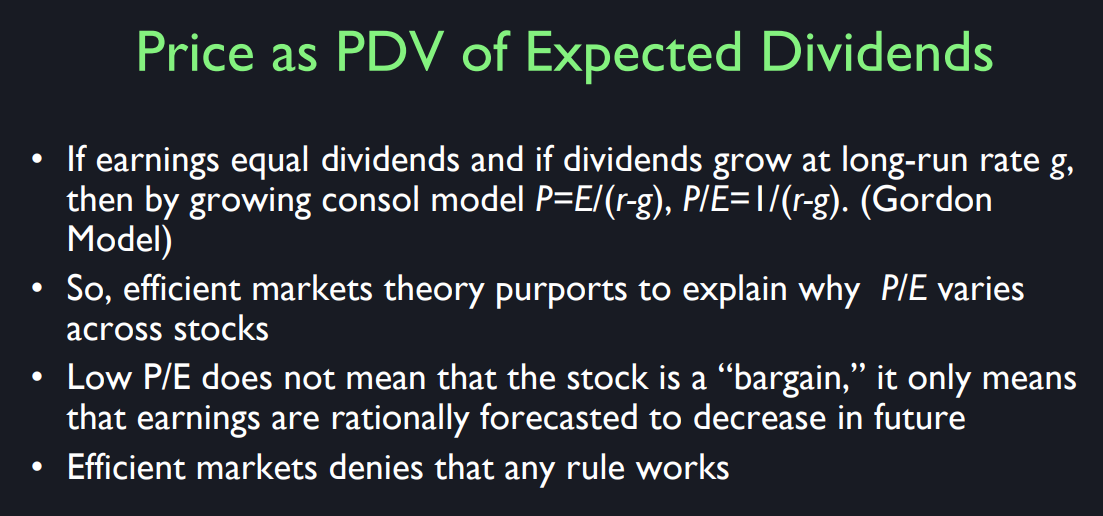
Now the idea is the price of a stock should be the present discounted
value of expected dividends. We’ll come back to present values last,
but what we have here is that,
oops, the price is equal to what I’m assuming
earnings equals dividends. Price equals earnings
divided by a discount factor, which is the discount rate minus
the growth rate of earnings. So price equals earnings over some number. This is called the Gordon model. So and these are not necessarily
exactly today’s earnings, but we’ll use that as an approximation. So what it implies then is that unless the
risk factor is different from some stock to another making for a different discount
rate, the price earnings ratio should be the same in every stock,
that’s the Gordon model.
So efficient market theory has
to explain why some companies are priced higher relative to
their earnings than others. And it would have to be,
if you believe the Gordon model, it have to be something about risk or
growth opportunities. So if you’re company is price high
relative to earnings it would either have to be because it’s low
risk as measured by beta, so we willing to pay more for
it because it’s low risk. Or would have to be that people
have reason to think that they’re earning path the gross rate g is high. So that you’re dividing
by a smaller number. So the efficient markets here
able to tribute, it would explain differences in
price relative to earnings. In terms of either the discount rate or
the growth rate of earnings. So that this markets are all priced right, even though in some markets the price
is high relative to earnings. So if this then gets that some stocks
are much more expensive than others. Some sell at a price earnings ratio of
as much as, sometimes is even more, but let’s say 100 times earnings. And you might ask, why would anyone
pay 100 times earnings for a stock?
Well, efficient market theory would say,
well, in its infinite wisdom, the market has decide either
that this stock is very good, in terms of risk, that’s r, or that the growth rate of the earnings of
this company is going to be phenomenal. So that high price-earnings ratio should
predict high growth rates of earnings.
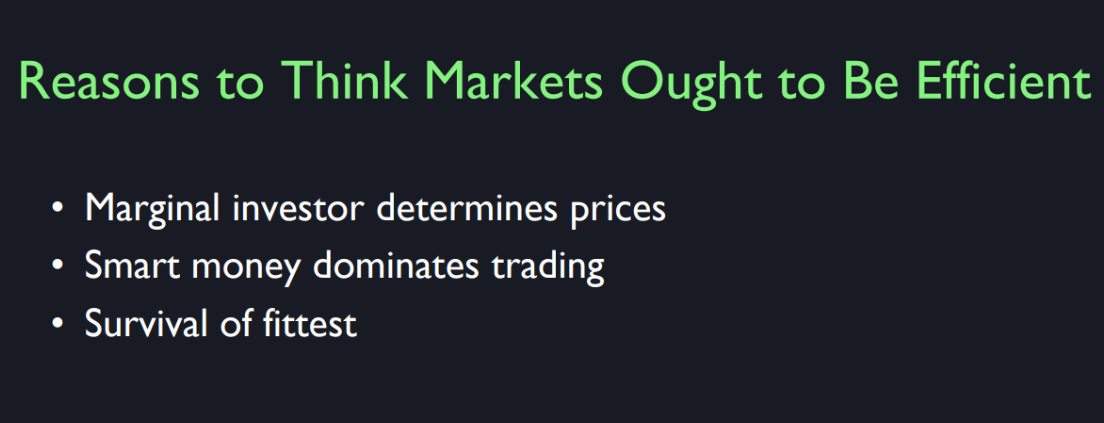
So these are ideas, why do people
think markets ought to be efficient? There’s the marginal investor. The smart guys are the ones
that trade regularly. They trade fast and immediately,
and they dominate trading. There’s also a survival
of the fittest argument. That some people go to Wall Street who
look smart, but they’re really not smart. [LAUGH]
Marginal investor
A marginal investor is an individual or entity whose actions reflect the consensus view of the market and whose buying or selling activity has a direct impact on the market price of a security. The marginal investor is considered to be at the margin of demand and supply and is thought to be representative of the average investor’s perspective in the market. Here are some key points about marginal investors:
Market Influence: The marginal investor’s trades are sufficient to influence the market price of a security. When they buy, the price tends to rise, and when they sell, the price tends to fall.
Equilibrium Price: The price at which a security trades in the market is often determined by the actions and perceptions of marginal investors. They help set the equilibrium price where the quantity demanded equals the quantity supplied.
Rational Decisions: Marginal investors are typically seen as making rational decisions based on available information. Their actions reflect a well-informed view of the security’s value, balancing risk and return.
Market Sentiment: The marginal investor’s behavior can also provide insights into overall market sentiment. Their buying and selling decisions are influenced by economic indicators, company performance, market trends, and other relevant factors.
Understanding the concept of the marginal investor helps in analyzing how security prices are determined and how market dynamics function based on the collective actions of individual investors.
边际投资者是指那些其买卖行为直接影响证券市场价格的个人或实体。边际投资者的行为反映了市场的共识观点,他们的交易活动位于需求和供给的边缘,被认为代表了市场中平均投资者的立场。以下是关于边际投资者的一些关键点:
市场影响:边际投资者的交易足以影响证券的市场价格。当他们买入时,价格往往会上升;当他们卖出时,价格则会下跌。
均衡价格:证券在市场上的交易价格通常由边际投资者的行为和观点决定。他们帮助设定了供需平衡的均衡价格。
理性决策:边际投资者通常被视为基于可用信息做出理性决策。他们的行为反映了对证券价值的良好判断,平衡了风险和回报。
市场情绪:边际投资者的行为也可以提供市场整体情绪的洞察。他们的买卖决策受经济指标、公司表现、市场趋势等相关因素的影响。
理解边际投资者的概念有助于分析证券价格是如何确定的,以及市场动态是如何基于个别投资者的集体行为运作的。
Marginal investors can be various types of individuals or institutional investors whose buying and selling activities directly impact market prices. Here are some common types of marginal investors:
Institutional Investors:
- Hedge Funds: These funds typically engage in large-scale trading and use complex strategies to influence market prices.
- Pension Funds: Pension funds manage substantial amounts of capital, and their trading decisions can affect market prices.
- Mutual Funds: Mutual funds trade frequently in the market, often significantly impacting prices.
- Insurance Companies: These companies manage large asset portfolios and adjust their investments based on liabilities, affecting market prices.
Individual Investors:
- High-Net-Worth Individuals: Wealthy individuals whose large trades can influence the prices of specific stocks or market segments.
- Active Traders: Including day traders and short-term speculators, their frequent trading has an immediate impact on market prices.
Passive Investors:
- Index Funds: These funds buy and sell based on changes in index components, influencing the prices of the parts of the market they track.
Quantitative Traders:
- Algorithmic and High-Frequency Trading Firms: These firms use computer programs to execute trades at high frequencies. Although individual trades may be small, their overall volume and frequency significantly impact market prices.
Sovereign Wealth Funds:
- National Investment Funds: These funds manage substantial national assets, and their investment decisions can have a significant impact on the market.
Private Equity Firms:
- Private Equity Companies: They typically make large equity investments and significant adjustments to their portfolio companies, affecting market prices.
Each type of marginal investor has different behaviors and strategies in the market, but collectively, they play a crucial role in influencing market prices and dynamics.
边际投资者可以是多种类型的个人或机构投资者,他们的买卖行为对市场价格产生直接影响。以下是一些常见的边际投资者类型:
机构投资者:
- 对冲基金:这些基金通常进行大量交易,并使用复杂的策略来影响市场价格。
- 养老基金:管理大量资金的养老基金,其买卖决定会影响市场。
- 共同基金:共同基金在市场上交易频繁,通常对市场价格有显著影响。
- 保险公司:这些公司管理大量的资产,并根据其负债情况进行资产配置。
个人投资者:
- 高净值个人:拥有大量资金的个人投资者,其买卖行为可以影响个股或市场板块的价格。
- 活跃交易者:包括日内交易者和短期投机者,他们频繁交易,对市场价格有即时影响。
被动投资者:
- 指数基金:指数基金会根据指数成分的变化进行买卖,对被动跟踪的市场部分价格产生影响。
量化交易者:
- 算法交易和高频交易公司:这些公司使用计算机程序进行高频率的交易活动,虽然单笔交易量可能较小,但其高频率和总交易量对市场价格有显著影响。
主权财富基金:
- 国家投资机构:这些基金管理着国家级别的大额资金,其投资决策可以对市场产生巨大影响。
私人股本公司:
- 私募股权公司:他们通常进行大规模的股权投资,并对其投资组合公司进行重大调整,这些行为会影响市场价格。
每一种类型的边际投资者在市场中的行为和策略各有不同,但他们共同对市场价格和动态产生重要影响。
On the P/E ratios though, do you think that different industries
should have different P/E ration averages? >> Good question. There are historic long run
differences across industries, and across countries in price earnings ratios. A good example is Japan. Which if you go back to the 1980s had, the overall Japanese market had a price
earnings ratio almost up to 100. People back then were
saying in everywhere, but Japan, they were saying this is crazy,
what with those Japanese? That’s too high, but if you go to Japan,
it seemed different. I actually did a questionnaire
survey comparing US and Japan, attitudes towards the Japanese market, and
I know this is true that US people where as highly skeptical, but
the Japanese were very enthusiastic. So the price earnings ratios did
come way down in Japan after that. I think it’s because the Japanese,
they’re human like all, I’m not criticizing the Japanese, but they got kind of carried away with their
success and they bid the price up. And that can be a psychological cause for
differences and it can be prolonged differences
in price earnings ratios. There could also be other
of course differences, like differences in accounting standards.
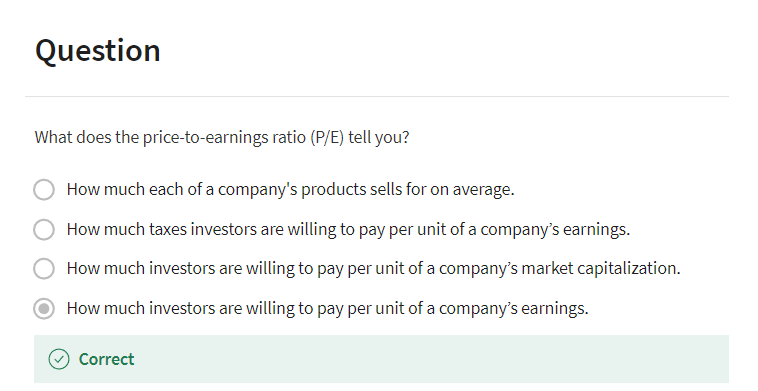
price-to-earnings ratio (P/E): How much investors are willing to pay per unit of a company’s earnings.
价格与收益比率(Price-to-Earnings Ratio,简称P/E)是一种用于评估公司股票相对价值的常用财务指标。它表示的是每股股票价格与每股收益(Earnings Per Share, EPS)之间的比率。计算公式如下:
[ $P/E = \frac{\text{每股股票价格 (Price per Share)}}{\text{每股收益 (Earnings per Share, EPS)}} $]
这个比率反映了投资者愿意为每单位的当前收益支付多少钱。P/E比率通常用于比较不同公司之间的估值水平,或者衡量某一公司股票的投资吸引力。一般来说:
- 较高的P/E比率可能意味着投资者对公司未来的增长有较高的期望。
- 较低的P/E比率可能表明该股票被低估,或公司面临的风险较大。
P/E比率可以分为“前瞻性P/E”(基于预期的未来收益)和“滞后性P/E”(基于过去12个月的实际收益)。投资者通常会综合考虑这两种P/E比率,以做出更加全面的投资决策。
The Price-to-Earnings Ratio (P/E Ratio) is a common financial metric used to evaluate the relative value of a company’s stock. It represents the ratio between the market price per share and the earnings per share (EPS). The formula for calculating the P/E ratio is:
[ P / E = Price per Share Earnings per Share (EPS) P/E = \frac{\text{Price per Share}}{\text{Earnings per Share (EPS)}} P/E=Earnings per Share (EPS)Price per Share ]
This ratio indicates how much investors are willing to pay for each unit of current earnings. It is often used to compare the valuation levels of different companies or to assess the attractiveness of a company’s stock. Generally speaking:
- A higher P/E ratio may indicate that investors have high expectations for a company’s future growth.
- A lower P/E ratio may suggest that the stock is undervalued or that the company faces significant risks.
The P/E ratio can be divided into “forward P/E” (based on expected future earnings) and “trailing P/E” (based on actual earnings from the past 12 months). Investors typically consider both types of P/E ratios to make more informed investment decisions.
Doubting Efficiency
It was here at Yale that was when Alison did a study of Smart Money and they judged smartness by the average score you got on your entrance exam, the SAT exam, not you, they couldn’t get it for the individual, they got it for the college they went to. And they found that people who had, by inference, the higher scores did outperform the others. And I think that’s very significant. I hate to say it but not everyone is equally intelligent.
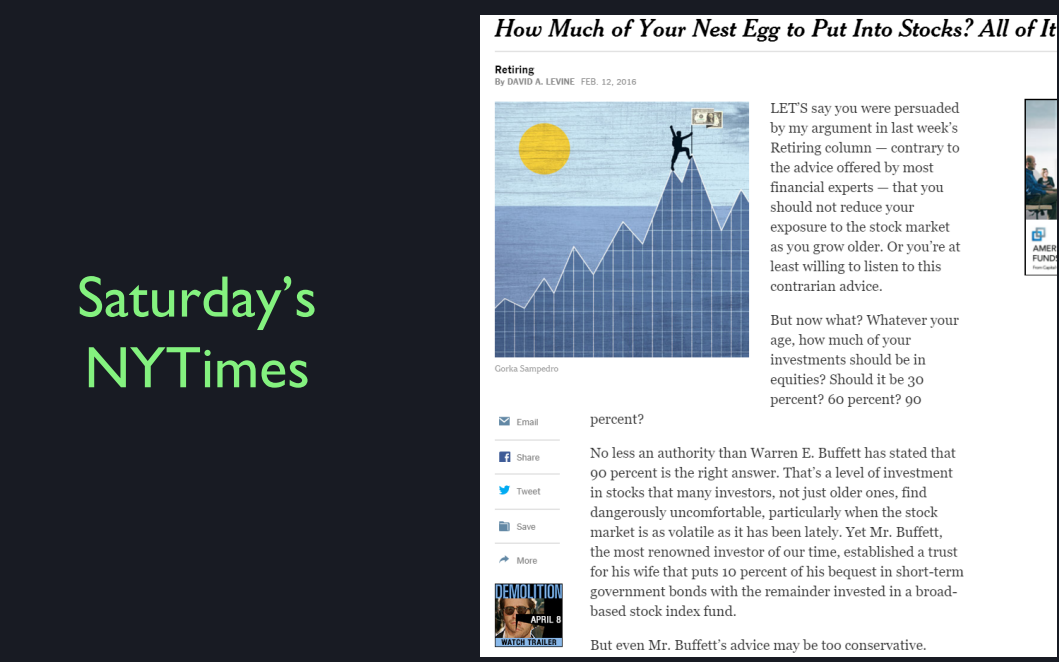
Saturday’s newspaper. Someone is doing it again, it’s Mr. David Levine. At this point in the market, when three-quarters of you are predicting a crash as of last Friday, he says how much of your nest egg to put in this stock. All of it. OK. I was kind of shocked to see it. Right now when the market looks so tumultuous, he’s telling people, he says Warren Buffett has stated that 90 percent of your portfolio should be in stocks. I’m wondering is that recent, when did Buffett say that? But anyway apparently at some point Buffett said that. He said, Mr. Buffett is too conservative. So I’ll stop with that. What I’m trying to convey is efficient markets theory is a, I’ll say it again, is a half truth. There are a lot of smart people investing. But a lot of that smartness is devoted to marketing and manipulation of your psychology. And this guy, I don’t know, he might be right. In fact it was kind of a thoughtful article, but the sales pitch I thought, was kind of a non-sequitur, if you read the whole article. Why is he so confidently telling you to put everything in the stock market? It’s just a gut feeling. Ultimately he’s got, and maybe he’s well-meaning of the whole thing. I’m not trying to disparage people’s ethic, I’m saying it may be well-meaning but the kind of things that get heard are things like this and they tend to drive market.
After the efficient markets hypothesis do you think that large stock market crashes like that in 1987 or in 2008, disprove or prove the efficient markets hypothesis? Is this like price is catching up with information, information is catching up with price, how is that?
Well one problem, if you look at 1987 or 2000 or 2007, there’s only a handful of examples and to disprove a hypothesis you need a lot of data. But on the other hand, people who lived through these crises have often reported that their faith in the markets was diminished by the experience. And I think that maybe what they’re referring to is, how it was reading the news every day about these events and talking to people about them. I think the experience of living through a crash makes it obvious that human emotions play a role. And that people were buying and selling who didn’t know what was happening. And so I think that it’s often a human judgment thing. Having experienced an event like this makes it seem, you know it’s kind of crazy to think these markets are perfect. You know I haven’t met anyone yet, who is behaving in a completely rational way. How could the combined effect of all their buying and selling be completely rational?
Actually going back to Eugene Fama, when he was asked about the 2008 crisis he said that the market behaved really well because prices started to fall in advance of when people accepted there was a recession so the prices were already incorporated in the recession. Right. So, how do you respond to that? So the stock market has been documented, this is known for almost 100 years, as a leading indicator. The stock market has a tendency to fall before a recession. So what do we take of that? Well there’s two possible explanations, you could say that the market is smarter than everyone else and it’s like a fortune teller and it sees the future. But there’s another explanation. You could say that what do you think it is? Is it cause? It causes the recession. So the market goes down and people say what, something’s wrong, you know. It’s just like if you take your temperature and you find it’s low or high and you suddenly think maybe I’m sick and he said maybe I feel a little sick. And when you do that with masses of people it can have that reverse causality. You can also say that the stock market crashed due to like an underlying problem in the housing market. And so with the prices, the stock market crashing is actually a reflection of new information. Right. The market provided, so is that maybe proving the efficient market hypothesis, actually?
Well this is something I’ve been involved in debating for many years. And there’s different approaches to answering your question, but one is to say, in any one of these questions, how big was the loss to the economy because of the recession and was the market acting appropriately to that? So for example in 1929 we had the beginning of a stock market crash that bottomed out in 1932. And the market lost over 80 percent of its real value. So wow, that’s a big drop, 80 percent. But then people say well but we had the great depression after that. Maybe we did, in fact, we did have the Great Depression but you know what, the Great Depression wasn’t that bad. It wasn’t anything like an 80 percent drop in GDP. It was temporary, you got over it. People like to tell stories. And they can tell a story that justifies the market as forecasting amazingly, but to me it’s just a story.
Lesson #6 Quiz
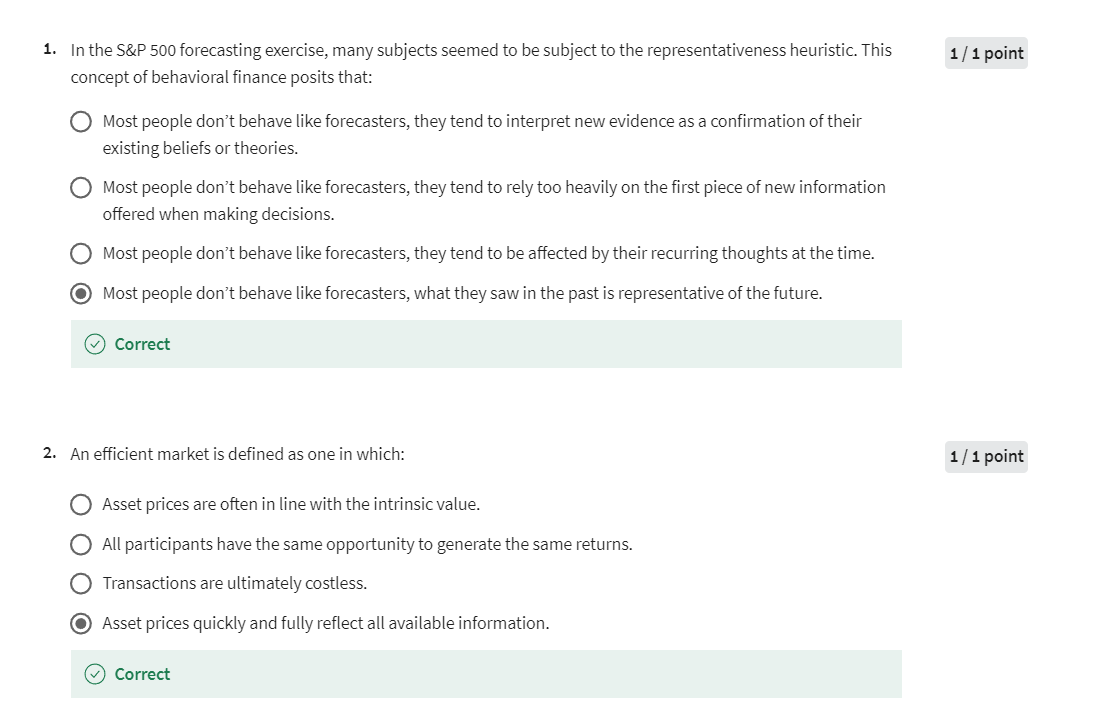

Lesson #7
Introduction to Behavioral Finance
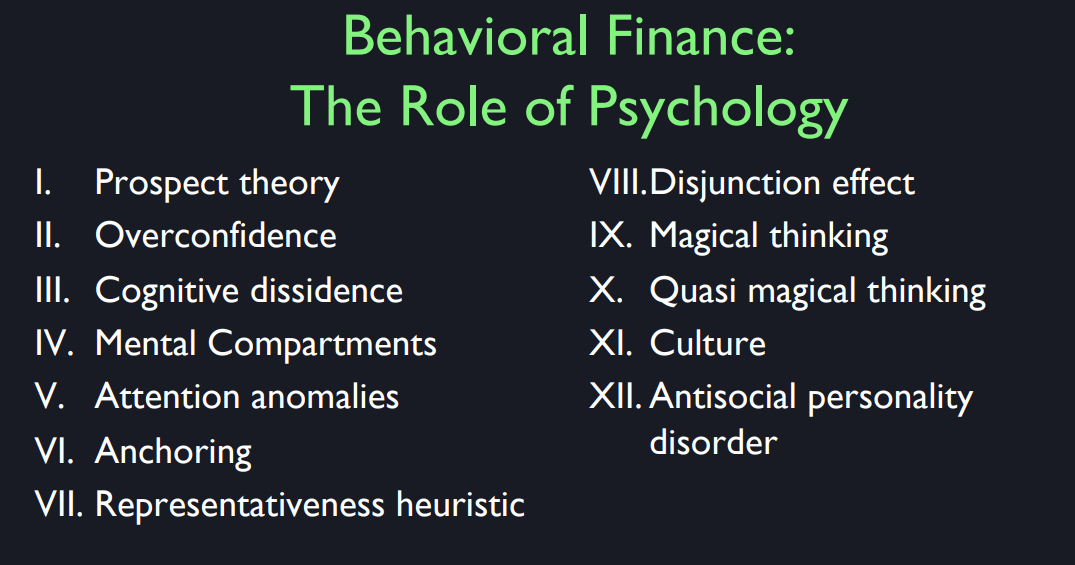
I’ve been very much involved
with this field since around the late 1980s,
joining psychology and finance, and it’s a deep belief of
mine that it really matters. So I’m trying not to over emphasize
this in this course, because this is a general course in finance and I don’t
want to over emphasize one aspect of it. On the other hand,
it sounds to me extremely relevant. Maybe I’m influenced by the fact
that my wife is a psychologist but I don’t think it’s just that. I think there’s a problem in academia, that departments are too separated. Professors don’t go to each other’s
seminars and get to know other fields as well as they ought to,
though there’s so many topics in behavior. By the way, it’s a revolution. I don’t know if I said this before. The first one we just talked about
was the efficient markets revolution. It came in with, also, the capital asset
pricing model and mathematical finance. That was an important revolution. I’m not saying they were wrong,
everything is half truth in life. Isn’t that true? No simple model will explain everything.
But the next one was behavioral
finance or, more broadly, behavioral economics, and
that came in around, well, it’s fuzzy but around 1990. Well, I think the term behavioral
economics appeared then and it became a sort of revolution. But the ideas go back very far and
they go back, in fact, to the father of economics,
Adam Smith. Now you know Adam Smith for his book, The Wealth of Nations,
which he wrote in 1776, which describes free market economics and is interpreted widely to be
a Libertarian or a free market tract. Adam Smith was a champion of letting prices go where they may because
they allocate scarce resources. I don’t think he used that term
exactly but had that meaning. He’s famous for the quote, invisible hand, that the free market is the invisible
hand that’s directing the economy. And he said that, who makes sure that enough coal is being
dug out of the ground for next winter? Is there a government
department of coal production? Well, there isn’t now and
there wasn’t in 1776. So what determines it? Well, it’s the profit motive. This is Adam Smith in his famous book,
The Wealth of Nations. And prices guide it, if price gets high, the coal mines will produce more because
it’s profitable for them to do that. And so, the price equilibrates at
a level that is just right for the upcoming winter when people
have to heat their homes. There will be enough coal.
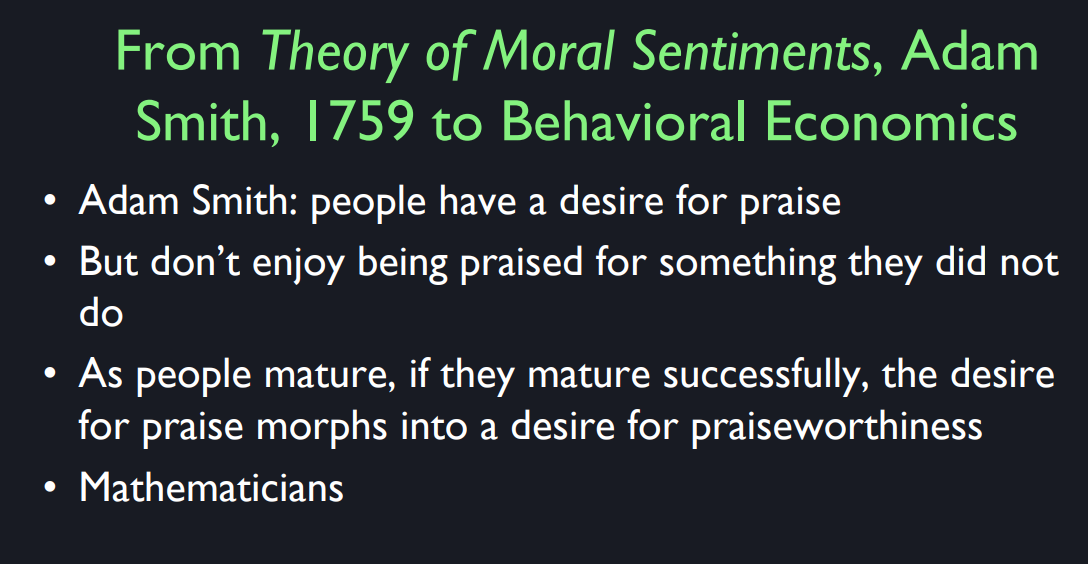
But the other side of Adam Smith is in
this other book called the Theory of Moral Sentiments. Now he’s not any academic psychologist. He’s just writing as a public
intellectual in 1759. He said that he has noticed throughout
life that people really like to be praised. Now I guess that’s obvious, right? You notice this in young children. You tell them, you did something good,
they seem to respond and it goes throughout life. But then Adam Smith points out,
are you happy with being praised for something that you didn’t do? Suppose somebody makes a mistake and thought that some achievement was yours, but, in fact, it’s just a mistake. Now suppose you also know that
the mistake will never be revealed, so you’ve got this on your resume,
some great achievement. Do you get pleasure from being praised for
this? And he said probably not, right? You want to be praised for
something you really did, and so he said, especially as one gets more
mature and thinks more about life. As people mature, the desire for praise
morphs into a desire for praiseworthiness. So people want to be, Suitable for praise,
even if nobody knows it. So he gives the example of mathematicians. Mathematicians are not famous usually. [LAUGH] That’s because the public
can’t see or understand what they do. In contrast, even in 1759,
actors and singers were famous, were wildly famous,
compared to mathematicians. So why don’t mathematicians despair? Nobody knows who I am,
I’m doing all this work. It is because they have a small
community of mathematicians who’ve read your work and respect it. And you know that you are praiseworthy for
this work, even if you’re totally unknown. So that’s what he said, and
I think that’s a real insight that he has. This is really true,
at least for mature adults, that you develop a sense of
your own praiseworthiness. So that’s very different from
the usual assumption in economics, that one wants to maximize consumption.
As people mature, the desire for praise morphs into a desire for praiseworthiness
这句话的意思是:随着人们的成熟,单纯想要得到别人的赞扬的欲望逐渐转变为渴望变得值得被赞扬的欲望。
具体来说,年轻时,人们可能更在意别人对他们的看法和赞美,希望通过外部的认可来获得满足感。但随着他们的成长和成熟,他们更倾向于追求内在的价值和道德上的满足,注重自身行为和成就的实际价值,而不仅仅是外界的认可。他们希望自己做的事情是真正值得被赞扬的,而不仅仅是为了得到赞扬而做事。
Adam Smith
亚当·斯密(Adam Smith,1723年6月16日-1790年7月17日),通常被誉为“经济学之父”。他是一位苏格兰的哲学家和经济学家,以其对现代经济学理论的奠基性贡献而著称。以下是关于亚当·斯密的一些介绍:
早年生活和教育
亚当·斯密出生于苏格兰的柯克卡迪,1723年进入格拉斯哥大学,后来又在牛津大学深造。他的教育背景主要集中在道德哲学和法律。
主要著作
《国富论》(The Wealth of Nations)
- 全名为《国民财富的性质和原因的研究》(An Inquiry into the Nature and Causes of the Wealth of Nations),于1776年出版。
- 这是经济学领域最具影响力的著作之一,被认为是现代经济学的奠基石。
- 书中讨论了分工、市场机制、自由贸易和政府角色等基本经济学概念。
《道德情操论》(The Theory of Moral Sentiments)
- 这本书于1759年出版,探讨了人类行为的伦理基础,强调了同情心和道德情感在社会行为中的作用。
经济学理论
亚当·斯密的主要理论包括:
- 看不见的手(Invisible Hand):他认为在自由市场中,个人追求自身利益时,无形中会促进整个社会的经济繁荣,这种效应被称为“看不见的手”。
- 分工(Division of Labor):斯密强调了分工的重要性,指出分工可以提高生产效率和经济效益。
- 市场机制(Market Mechanism):他主张自由市场经济,认为市场价格是由供需关系决定的,政府的干预应尽量减少。
影响
亚当·斯密的思想和著作对后来的经济学研究产生了深远的影响。他的理论奠定了古典经济学的基础,并为自由市场经济和资本主义制度的发展提供了理论支持。
亚当·斯密不仅是经济学的奠基者之一,也是启蒙时代的重要思想家,他的学说对经济学和社会科学的发展具有重要的里程碑意义。
Adam Smith (June 16, 1723 – July 17, 1790) is often referred to as the “Father of Economics.” He was a Scottish philosopher and economist whose work laid the foundation for modern economic theory. Here is an introduction to Adam Smith:
Early Life and Education
Adam Smith was born in Kirkcaldy, Scotland. He attended the University of Glasgow in 1737 and later studied at Balliol College, Oxford. His academic background was primarily in moral philosophy and law.
Major Works
“The Wealth of Nations”
- Full title: “An Inquiry into the Nature and Causes of the Wealth of Nations,” published in 1776.
- This is one of the most influential books in economics and is considered the foundation of modern economic theory.
- The book discusses fundamental economic concepts such as division of labor, market mechanisms, free trade, and the role of government.
“The Theory of Moral Sentiments”
- Published in 1759, this book explores the ethical basis of human behavior, emphasizing sympathy and moral sentiments as key factors in social interactions.
Economic Theories
Adam Smith’s key theories include:
- Invisible Hand: He posited that individuals’ pursuit of self-interest in a free market unintentionally promotes the public good, a concept famously known as the “invisible hand.”
- Division of Labor: Smith highlighted the importance of the division of labor, stating that it increases productivity and economic efficiency.
- Market Mechanism: He advocated for a free market economy, suggesting that prices are determined by supply and demand, and that government intervention should be minimized.
Influence
Adam Smith’s ideas and writings have had a profound impact on the field of economics. His theories laid the groundwork for classical economics and provided theoretical support for the development of free market economies and capitalism.
Adam Smith is not only one of the founding figures of economics but also a significant thinker of the Enlightenment era. His contributions to economics and social science are considered monumental, and his legacy continues to shape economic thought and policy.
Prospect Theory

So, let me start with
a more modern behavioral economic and talk about prospect theory. So, the term prospect theory was coined
by psychologists Daniel Kahneman and Amos Tversky in an economic journal,
Econometrica, 1979. A very important paper and, in fact,
at least as of some years ago, the most cited paper ever
published in Econometrica, which is the top journal for
economic mathematical economists. What they are criticizing is
the core theory of economics, and they’re replacing it with
a constructive alternative. The core theory being
expected utility theory. So, the economic profession tends to used the idea that
everyone has a utility function, which depends on the things that they
consume and it represents their happiness.
You’ve heard of indifference curves, those
are contours of the utility function. And that people in a world with
no uncertainty will choose how much to buy at the market prices
to maximize their utility function. And then if there’s uncertainty, then people use the probabilities
of possible events to calculate the expected utility and
the maximized expected utility.

Kahneman and Tversky changed two
things in expected utility theory. One, they replaced the utility function
with what they called a value function. And two,
they replaced the probabilities with subjective probabilities
determined by a weighting function in terms of
the actual probabilities. So, let me talk about
these two elements here. The first thing is the value function, that’s a plot from their 1979 paper of
what the value function might look like. This is based on their experiments,
but this is just a hand drawn story. Now, the utility function,
if you think of from elementary economics, the utility function exhibits
diminishing marginal utility everywhere. And it’s concaved down,
right, so the upper-right segment of their curve looks
like a utility function. You see it’s concaved down and
it’s growing. The axes, okay, the horizontal axis is
the amount of money gained or lost. And the vertical axis
is their counterpart, their replacement for utility,
which they call value. But if you look at it,
there’s a funny kink here, at the origin, and then they have it concave upward,
not downward for losses. The other thing is, or that I should
emphasize, the utility function is not usually put at, in this term,
between gains and losses in economic.
Your utility is determined by how
much you have, and it doesn’t apply, it doesn’t make a distinction,
it doesn’t focus on what you have now. What they’re talking about here is how you
react to an opportunity on any given day. And what they said is that on any given
day, you form a reference point for today, and
that’s this reference point, okay? And the utility depends on,
relative to your reference point, what your gains and losses might be. There’s a kink at the reference point,
okay, which means that, There’s something special going on. But this reference point
is kind of arbitrary, it’s just where you see yourself today. So, that is, now,
I’m not going to get into details of this, but this is the idea which they proposed, instead of utility,
based on experimental evidence. So let me talk about evidence,
quickly through this, the kink, the first thing is that
the origin moves through time, you’re not consistent through time. If I get more money, then I move my
reference point up to more money for the next choice that I make. And if I have less money, I move it back. That doesn’t happen with utility. What they’re saying is
that it’s subjective, I’m thinking always
relative to where I am now. So, for example,
there’s a kink in the slope. You see the slope is high here, and then it becomes low at a point,
which is today’s reference point. And so what it means is that people, one implication of this is
people will not take small bets.
So, I’ll give you an example,
the famous example occurred at lunch at MIT
about a half century ago. And Professor Paul Samuelson,
who’s a famous professor, was seated with E Cary Brown,
another professor, not so famous. And Samuelson said,
on the spur of the moment at lunch, hey, let’s try a little gamble here. Let’s flip a coin, and
if it come up heads, I will pay you $200, but if it comes up tails, you pay me $100. So he proposed, you see that he’s
being very generous here because he’s giving the other
guy $200 as against 100. What’s the expected value of that bet? Well, it’s 0.5, assuming it’s a fair coin
with a probability of coming up heads, 0.5 times 200 minus 0.5 times 100,
so that’s $50. So, Samuelson thought he would immediately
take it, but E Cary Brown said, no, I don’t, what are you talking about,
[LAUGH] I don’t want to do that. And he didn’t want to do it,
and Samuelson said, are you sure, I mean,
I gave you a positive expected value bet. It’s only a couple hundred dollars, right? Well, that sounded like a lot, but
back then it was worth more than it is now [LAUGH] sounded like a lot of money,
but he just didn’t want to do it. So, Samuelson then said to E Cary Brown,
okay, how about doing it 100 times? Well, I’ll do this, and this is
hypothetical, I’m not really offering this, but if I offered to do it 100
times in a row would you do it? And then E Cary Brown said, Gee,
I mean, by the law of large numbers, [LAUGH] I’m going to make something
like $5,000 practically for sure. So, E Cary Brown said,
okay, I would do that. So then Samuelson went back to his office,
and wrote out a mathematical proof
that E Cary Brown is irrational because if you would take 100 of them,
you should take one of them, right? But E Cary Brown was just behaving
the way this value function. The kink at the value function means the
gains look so much smaller than the loss. So, psychologically, so I don’t want that,
but if it’s 100 of them, then it’s just moving him up here for
sure, so, of course, he’ll do it. But see there’s a fundamental human error
here, that we focus on little things and we panic at little bets. You should be doing,
I don’t know if you’re ready for it. If I actually offer it,
I should have asked for a show of hands, if I offered you a coin
toss like that, you’d take it, right? I assume, at least if you learn anything
from this course about rationality, you should do it. Any time you get a bet like,
it’s a small bet, you should, with a positive expected value,
expected utility theory says you take it because there’s not much concavity
to the utility function, but people don’t. The other thing is that this
thing curves up for losses, and what that refers to is a,
There’s risk preference for losses. People, it’s a little bit hard to explain,
but the key idea is that people are willing to
take big risks to escape loses. So, for example, someone at a gambling
casino, who’s lost a lot of money and now is in the reign of losses,
starts to think, maybe, of taking a really big bet that might have
the possibility of bringing them away so they could close the day
up instead of down.
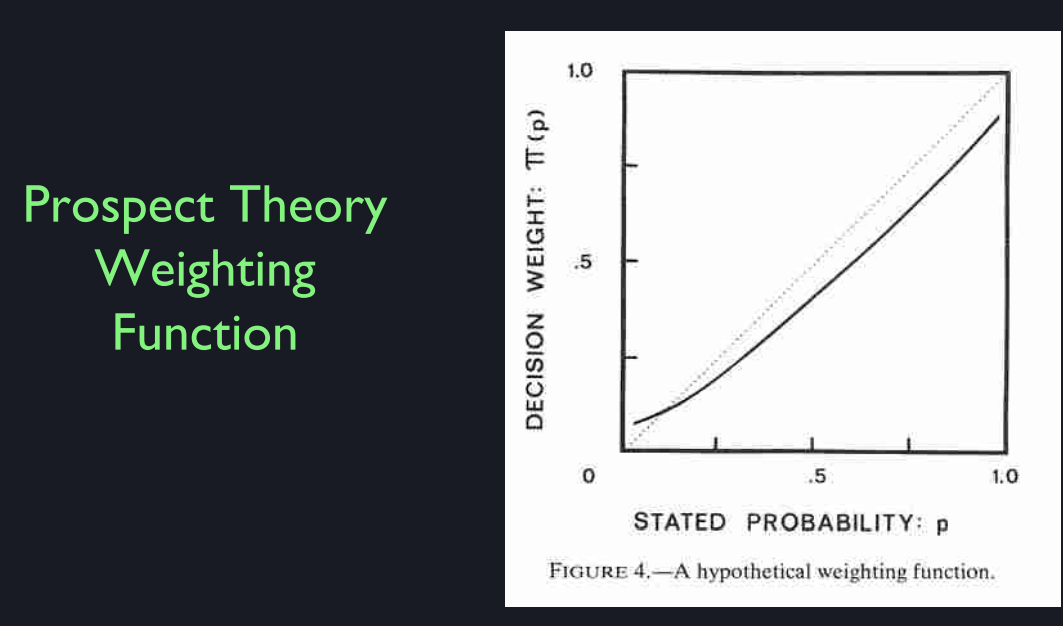
So that people have a tendency
to take risks in the domain of losses to try to get them back,
so that’s the value function. The other thing is the weighting function. Now, on this axis we have
the stated probability, now, probabilities range from zero to one, and so that’s the actual
probability of an event. But on this axis we have the decision
weight, which is a transformed, psychologically transformed probability. And you can see that they curve,
this is the 45 degree line, if people were completely rational, they would use the actual
probabilities in their calculations. But they do not actually
behave completely like that, they tend to transform their
weighting function, so it looks like a curve with
a slope less than one. Also, it doesn’t show, for
very low probabilities and very high probabilities, the line stops. You notice that it doesn’t tell you or, by some versions, it drops to the zero or
it jumps up to one. So, what they are referring to, let’s talk about the fact that
it doesn’t go to zero or one. What it means is for very low
probabilities you have a tendency to not appreciate them and, actually,
often, to drop them to zero. I’m not going to think about that. If it’s a probability of 10% of happening,
you might worry about it, but if it’s 1%, I’m going to round
that to 0 and not worry about it. Similarly, on the upper end, if something has a very high probability,
people don’t accept that hype, they don’t take that probability into
account, and they round it to one.
So, I’ll give you an example of
the application of the weighting function. And that is, it used to be that
when you board an airplane they had vending machines that offered you
insurance against dying on this flight. It’s one flight, and they would charge
you like $1 for an insurance policy. And they would put the machine right
there where you’re boarding the airplane. A lot of people would buy this because
they’re boarding an airplane and they just get a little
scared about this flight. Well, actually, the probability of this
flight crashing, what is it, one flight? It’s 1 in 10 million, right,
so that $1 insurance should give you a coverage of $10 million,
but it [LAUGH] doesn’t. It gives you something
very remote from that, and people still buy it, why do they buy it? It’s because they’re nervous. You hear about all these plane crashes,
you think this could be my last day on earth, I feel like I want to
have done something. But, in fact, you see,
the probability is exaggerated. So, most people didn’t buy it, so
those are the people who were down here, they rounded it to zero. But some people are right there, [LAUGH] there’s a little bit
of fluidity in this theory. And you either exaggerate it or
you ignore it, and so there’s a whole business exploiting
people who exaggerate it. Also, the curve has a slope less than one,
and you could caricature this by
saying there’s three possible weighting values, zero, a half, or one. And so, emotionally, I can’t process these numbers, that would
be the case if this curve were actually flat through a half, but
it’s not absolutely flat. But it is true that,
in this realm, people don’t, they don’t take full account of the
differences in probabilities of events. They tend to blur them a little bit,
so that’s prospect theory.
Expected Utility Theory
Expected Utility Theory is a fundamental concept in economics and decision theory, used to analyze how individuals make choices under uncertainty. This theory was systematized by John von Neumann and Oskar Morgenstern in their 1944 book “Theory of Games and Economic Behavior.” Here is an introduction to Expected Utility Theory:
Key Concepts of Expected Utility Theory
Utility:
- Utility is a measure representing the preference or satisfaction an individual derives from different outcomes. The higher the utility, the more desirable the outcome.
Expected Utility:
- When facing uncertain outcomes, individuals calculate the expected utility of each option by considering the utility of each possible outcome and the probability of its occurrence.
- The formula for expected utility is:
E U = ∑ i = 1 n p i ⋅ U ( x i ) EU = \sum_{i=1}^{n} p_i \cdot U(x_i) EU=∑i=1npi⋅U(xi)
where ( EU ) represents expected utility, ( p i p_i pi ) represents the probability of the ( i )-th outcome, and ( U ( x i ) U(x_i) U(xi) ) represents the utility of the ( i )-th outcome.
Risk Attitudes:
- Expected Utility Theory helps to analyze an individual’s attitude towards risk, typically categorized into three types:
- Risk Aversion: Individuals prefer certain outcomes over gambles with the same expected value. The utility function for risk-averse individuals is concave.
- Risk Neutrality: Individuals are indifferent between certain outcomes and gambles with the same expected value. The utility function for risk-neutral individuals is linear.
- Risk Seeking: Individuals prefer gambles over certain outcomes with the same expected value. The utility function for risk-seeking individuals is convex.
- Expected Utility Theory helps to analyze an individual’s attitude towards risk, typically categorized into three types:
Applications of Expected Utility Theory
Investment Decisions:
- Investors use expected utility to choose investment portfolios that maximize their overall utility, considering the risks and returns of different assets.
Insurance Decisions:
- Individuals weigh the cost of insurance against the expected utility of potential losses to decide whether and how much insurance to purchase.
Economic Policy:
- Policymakers use expected utility to evaluate the impact of different policies on social welfare and choose policies that maximize overall societal utility.
Limitations of Expected Utility Theory
Despite its powerful framework, Expected Utility Theory has some limitations:
Behavioral Biases:
- In reality, people’s decisions are often influenced by emotions, cognitive biases, and other psychological factors, which are not fully accounted for by Expected Utility Theory.
Complex Calculations:
- In practice, calculating expected utility can be complex, especially when there are many possible outcomes and probabilities are difficult to estimate accurately.
Alternative Theories:
- Theories such as Prospect Theory incorporate more behavioral and psychological factors, explaining phenomena that Expected Utility Theory cannot, such as loss aversion and framing effects.
Conclusion
Expected Utility Theory provides a systematic framework for analyzing decision-making under uncertainty. Despite its limitations, it remains a cornerstone of economics and decision science, widely applied in various fields from personal finance to public policy formulation.
预期效用理论(Expected Utility Theory)是经济学和决策理论中的一个核心概念,用于分析个体在面对不确定性时如何做出选择。该理论由约翰·冯·诺依曼(John von Neumann)和奥斯卡·摩根斯坦(Oskar Morgenstern)在他们1944年出版的《博弈论与经济行为》(Theory of Games and Economic Behavior)中系统化提出。以下是预期效用理论的介绍:
预期效用理论的基本概念
效用(Utility):
- 效用是一个度量标准,用于表示个体对不同结果的偏好程度。效用值越高,表示该结果对个体的吸引力越大。
期望效用(Expected Utility):
- 在面对不确定结果时,个体会根据各个可能结果的效用和这些结果发生的概率,计算其期望效用。具体来说,期望效用是各个结果效用与其对应概率的加权平均值。
- 期望效用的计算公式如下:
E U = ∑ i = 1 n p i ⋅ U ( x i ) EU = \sum_{i=1}^{n} p_i \cdot U(x_i) EU=∑i=1npi⋅U(xi)
其中,( EU ) 表示期望效用,( p i p_i pi) 表示第 ( i ) 个结果发生的概率,( U ( x i ) U(x_i) U(xi)) 表示第 ( i ) 个结果的效用。
风险态度(Risk Attitude):
- 预期效用理论还帮助分析个体对风险的态度,通常分为三类:
- 风险厌恶(Risk Aversion):个体更倾向于选择确定的收益而不是预期值相同或更高的风险收益。风险厌恶者的效用函数是凹形的。
- 风险中立(Risk Neutrality):个体对风险和确定收益的态度是无差别的,他们仅关注期望值。风险中立者的效用函数是线性的。
- 风险偏好(Risk Seeking):个体更倾向于选择风险收益而不是确定收益。风险偏好者的效用函数是凸形的。
- 预期效用理论还帮助分析个体对风险的态度,通常分为三类:
预期效用理论的应用
投资决策:
- 投资者在选择投资组合时,会根据各个投资项目的期望效用来做出决策,以最大化其整体效用。
保险决策:
- 个人在购买保险时,会权衡保险费用与潜在损失的期望效用,以决定是否购买保险及购买多少保险。
经济政策:
- 政策制定者可以使用预期效用理论来评估不同政策对社会福利的影响,并选择能最大化社会整体效用的政策。
预期效用理论的局限性
尽管预期效用理论是一个强大的工具,但它也有一些局限性:
行为偏差:
- 现实中,人们的决策往往受情绪、认知偏差和其他心理因素的影响,而这些因素并未被预期效用理论所充分考虑。
复杂计算:
- 在实际应用中,计算期望效用可能非常复杂,尤其是当可能结果众多且概率难以准确估计时。
替代理论:
- 像前景理论(Prospect Theory)等替代理论提出了更多考虑行为偏差和心理因素的方法,解释了一些预期效用理论无法解释的现象。
结论
预期效用理论提供了一个系统化的框架,用于分析在不确定性条件下的决策。尽管存在一些局限性,它仍然是经济学和决策科学中的一个基石,广泛应用于各种领域,从个人理财到公共政策制定。
In economics and decision theory, the concavity and convexity of utility functions reflect an individual’s attitude towards risk. Specifically, the shape of the utility function (concave or convex) explains how individuals make decisions under uncertainty.
Definitions of Concavity and Convexity
Concavity:
- A function is concave if, for any two points ( x 1 x_1 x1) and ( x 2 x_2 x2) on the function, the function value at any point on the straight line segment between them is above the function. Mathematically, a function (U(x)) is concave if for all ( x 1 x_1 x1) and ( x 2 x_2 x2) and ( 0 ≤ λ ≤ 1 0 \leq \lambda \leq 1 0≤λ≤1), it satisfies:
[
U ( λ x 1 + ( 1 − λ ) x 2 ) ≥ λ U ( x 1 ) + ( 1 − λ ) U ( x 2 ) U(\lambda x_1 + (1 - \lambda) x_2) \geq \lambda U(x_1) + (1 - \lambda) U(x_2) U(λx1+(1−λ)x2)≥λU(x1)+(1−λ)U(x2)
] - For risk-averse individuals, their utility function is typically concave, meaning they experience diminishing marginal utility for additional wealth.
- A function is concave if, for any two points ( x 1 x_1 x1) and ( x 2 x_2 x2) on the function, the function value at any point on the straight line segment between them is above the function. Mathematically, a function (U(x)) is concave if for all ( x 1 x_1 x1) and ( x 2 x_2 x2) and ( 0 ≤ λ ≤ 1 0 \leq \lambda \leq 1 0≤λ≤1), it satisfies:
Convexity:
- A function is convex if, for any two points ( x 1 x_1 x1) and ( x 2 x_2 x2) on the function, the function value at any point on the straight line segment between them is below the function. Mathematically, a function (U(x)) is convex if for all ( x 1 x_1 x1) and ( x 2 x_2 x2) and ( 0 ≤ λ ≤ 1 0 \leq \lambda \leq 1 0≤λ≤1), it satisfies:
[
U ( λ x 1 + ( 1 − λ ) x 2 ) ≤ λ U ( x 1 ) + ( 1 − λ ) U ( x 2 ) U(\lambda x_1 + (1 - \lambda) x_2) \leq \lambda U(x_1) + (1 - \lambda) U(x_2) U(λx1+(1−λ)x2)≤λU(x1)+(1−λ)U(x2)
] - For risk-seeking individuals, their utility function is typically convex, meaning they experience increasing marginal utility for additional wealth.
- A function is convex if, for any two points ( x 1 x_1 x1) and ( x 2 x_2 x2) on the function, the function value at any point on the straight line segment between them is below the function. Mathematically, a function (U(x)) is convex if for all ( x 1 x_1 x1) and ( x 2 x_2 x2) and ( 0 ≤ λ ≤ 1 0 \leq \lambda \leq 1 0≤λ≤1), it satisfies:
Explanation of Utility Functions for Risk Aversion and Risk Seeking
Risk Aversion:
- For risk-averse individuals, the utility function is concave, indicating that they prefer certain outcomes over gambles with the same expected value.
- Example: Consider a utility function ( U ( x ) = x U(x) = \sqrt{x} U(x)=x). In this function, as wealth (x) increases, utility (U(x)) increases, but at a decreasing rate, reflecting diminishing marginal utility.
- This diminishing utility makes risk-averse individuals prefer certain outcomes over risky ones. For instance, they might prefer a sure $50 over a 50% chance of winning $100 because the utility of the sure amount ( U ( 50 ) = 50 U(50) = \sqrt{50} U(50)=50) is greater than the expected utility of the gamble ( 0.5 ⋅ 100 + 0.5 ⋅ 0 = 0.5 ⋅ 10 = 5 0.5 \cdot \sqrt{100} + 0.5 \cdot \sqrt{0} = 0.5 \cdot 10 = 5 0.5⋅100+0.5⋅0=0.5⋅10=5).
Risk Seeking:
- For risk-seeking individuals, the utility function is convex, indicating that they prefer gambles over certain outcomes with the same expected value.
- Example: Consider a utility function ( U ( x ) = x 2 U(x) = x^2 U(x)=x2). In this function, as wealth (x) increases, utility (U(x)) increases at an accelerating rate, reflecting increasing marginal utility.
- This increasing utility makes risk-seeking individuals prefer risky outcomes over certain ones. For example, they might prefer a 50% chance of winning $100 over a sure $50 because the expected utility of the gamble ( 0.5 ⋅ 10 0 2 + 0.5 ⋅ 0 2 = 5000 0.5 \cdot 100^2 + 0.5 \cdot 0^2 = 5000 0.5⋅1002+0.5⋅02=5000) is greater than the utility of the certain amount ( 5 0 2 = 2500 50^2 = 2500 502=2500).
Conclusion
The concavity and convexity of utility functions play a crucial role in economics and decision theory, helping to explain individuals’ choices when facing risk and uncertainty. A concave utility function corresponds to risk aversion, while a convex utility function corresponds to risk seeking. Understanding these properties of utility functions aids in analyzing and predicting economic decisions.
在经济学和决策理论中,效用函数的凹凸性反映了个体对风险的态度。具体来说,效用函数的形状(凹形或凸形)可以解释个体在面临不确定性时的决策行为。
凹凸性的定义
凹性(Concavity):
- 一个函数是凹的,如果对于任意两个点 ( x 1 x_1 x1) 和 ( x 2 x_2 x2) 之间的每一点,函数值在直线上方。数学上,一个函数 (U(x)) 是凹的,如果对所有的 ( x 1 x_1 x1) 和 ( x 2 x_2 x2) 以及 ( 0 ≤ λ ≤ 1 0 \leq \lambda \leq 1 0≤λ≤1),满足:
[
U ( λ x 1 + ( 1 − λ ) x 2 ) ≥ λ U ( x 1 ) + ( 1 − λ ) U ( x 2 ) U(\lambda x_1 + (1 - \lambda) x_2) \geq \lambda U(x_1) + (1 - \lambda) U(x_2) U(λx1+(1−λ)x2)≥λU(x1)+(1−λ)U(x2)
] - 对于风险厌恶(Risk-Averse)个体,他们的效用函数通常是凹形的,这意味着他们对额外财富的边际效用递减。
- 一个函数是凹的,如果对于任意两个点 ( x 1 x_1 x1) 和 ( x 2 x_2 x2) 之间的每一点,函数值在直线上方。数学上,一个函数 (U(x)) 是凹的,如果对所有的 ( x 1 x_1 x1) 和 ( x 2 x_2 x2) 以及 ( 0 ≤ λ ≤ 1 0 \leq \lambda \leq 1 0≤λ≤1),满足:
凸性(Convexity):
- 一个函数是凸的,如果对于任意两个点 ( x 1 x_1 x1) 和 ( x 2 x_2 x2) 之间的每一点,函数值在直线下方。数学上,一个函数 (U(x)) 是凸的,如果对所有的 ( x 1 x_1 x1) 和 ( x 2 x_2 x2) 以及 ( 0 ≤ λ ≤ 1 0 \leq \lambda \leq 1 0≤λ≤1),满足:
[
U ( λ x 1 + ( 1 − λ ) x 2 ) ≤ λ U ( x 1 ) + ( 1 − λ ) U ( x 2 ) U(\lambda x_1 + (1 - \lambda) x_2) \leq \lambda U(x_1) + (1 - \lambda) U(x_2) U(λx1+(1−λ)x2)≤λU(x1)+(1−λ)U(x2)
] - 对于风险偏好(Risk-Seeking)个体,他们的效用函数通常是凸形的,这意味着他们对额外财富的边际效用递增。
- 一个函数是凸的,如果对于任意两个点 ( x 1 x_1 x1) 和 ( x 2 x_2 x2) 之间的每一点,函数值在直线下方。数学上,一个函数 (U(x)) 是凸的,如果对所有的 ( x 1 x_1 x1) 和 ( x 2 x_2 x2) 以及 ( 0 ≤ λ ≤ 1 0 \leq \lambda \leq 1 0≤λ≤1),满足:
风险厌恶和风险偏好的效用函数解释
风险厌恶(Risk Aversion):
- 对于风险厌恶的个体,效用函数是凹形的,这表明他们更倾向于确定的收益而不是具有相同期望值的风险收益。
- 例如,考虑一个效用函数 ( U ( x ) = x U(x) = \sqrt{x} U(x)=x)。在这个函数中,随着财富 (x) 的增加,效用 (U(x)) 增加,但增加的速度减慢,这反映了边际效用递减的特性。
- 这种递减效用使得风险厌恶个体更愿意选择确定的收益而不是赌博。例如,他们可能会选择确定的 50 美元而不是有50% 机会得到 100 美元的赌博,因为前者的效用 ( U ( 50 ) = 50 U(50) = \sqrt{50} U(50)=50) 大于赌博的期望效用 ( 0.5 ⋅ 100 + 0.5 ⋅ 0 = 0.5 ⋅ 10 = 5 0.5 \cdot \sqrt{100} + 0.5 \cdot \sqrt{0} = 0.5 \cdot 10 = 5 0.5⋅100+0.5⋅0=0.5⋅10=5)。
风险偏好(Risk Seeking):
- 对于风险偏好的个体,效用函数是凸形的,这表明他们更倾向于风险收益而不是具有相同期望值的确定收益。
- 例如,考虑一个效用函数 ( U ( x ) = x 2 U(x) = x^2 U(x)=x2)。在这个函数中,随着财富 (x) 的增加,效用 (U(x)) 以加速的速度增加,这反映了边际效用递增的特性。
- 这种递增效用使得风险偏好个体更愿意选择风险收益而不是确定收益。例如,他们可能会选择有 50% 机会得到 100 美元的赌博而不是确定的 50 美元,因为前者的期望效用 ( 0.5 ⋅ 10 0 2 + 0.5 ⋅ 0 2 = 5000 0.5 \cdot 100^2 + 0.5 \cdot 0^2 = 5000 0.5⋅1002+0.5⋅02=5000) 大于确定收益的效用 ( 5 0 2 = 2500 50^2 = 2500 502=2500)。
结论
效用函数的凹凸性在经济学和决策理论中起着关键作用,帮助解释个体在面对风险和不确定性时的选择行为。凹形效用函数对应风险厌恶,凸形效用函数对应风险偏好。理解这些效用函数的性质,有助于分析和预测个体的经济决策。
Prospect Theory is a behavioral economic theory developed by Daniel Kahneman and Amos Tversky in 1979. It describes how people make decisions involving risk and uncertainty, challenging the traditional economic assumption that people always act rationally to maximize their utility. Here’s an introduction and discussion of Prospect Theory:
Key Concepts of Prospect Theory
Reference Dependence:
- People evaluate outcomes relative to a reference point, which is often the status quo or an expected outcome, rather than in absolute terms.
Loss Aversion:
- Losses loom larger than gains. That is, the pain of losing is psychologically more impactful than the pleasure of gaining the same amount. For example, losing $100 feels worse than gaining $100 feels good.
Diminishing Sensitivity:
- As the magnitude of gains or losses increases, the incremental impact on people’s utility decreases. This means that the difference in perceived value between $100 and $200 is greater than between $1,100 and $1,200.
Probability Weighting:
- People tend to overweigh small probabilities and underweigh large probabilities. This means that unlikely events are given more importance than they deserve, while very likely events are given less importance.
Value Function
The value function in Prospect Theory is concave for gains (reflecting risk aversion) and convex for losses (reflecting risk-seeking behavior) with a steeper slope for losses than gains, illustrating loss aversion.
Implications of Prospect Theory
Risk Behavior:
- Risk Aversion in Gains: When faced with potential gains, people tend to avoid risks and prefer a sure gain over a gamble with higher or equal expected value.
- Risk Seeking in Losses: When faced with potential losses, people tend to seek risks, preferring to gamble rather than accept a certain loss.
Endowment Effect:
- People value items they own more highly than items they do not own, which is influenced by loss aversion. Selling an item feels like a loss, so people demand more money to give it up than they would be willing to pay to acquire it.
Framing Effects:
- The way choices are presented or framed can significantly impact decisions. For example, people might react differently to a treatment described as having a “90% survival rate” versus a “10% mortality rate,” even though they are statistically equivalent.
Certainty Effect:
- People tend to overvalue outcomes that are certain relative to those that are merely probable. They might prefer a sure, but smaller reward over a larger, uncertain one.
Applications of Prospect Theory
Finance and Investment:
- Understanding investors’ behavior in terms of risk aversion and risk seeking can explain market anomalies such as overreaction to market news or the equity premium puzzle.
Marketing and Pricing:
- Businesses can frame offers in ways that highlight gains or minimize perceived losses to influence consumer behavior.
Policy Making:
- Policymakers can design better interventions by understanding how people perceive gains and losses, and how they weigh probabilities, to nudge them towards better decisions.
Conclusion
Prospect Theory has significantly influenced behavioral economics by providing a more accurate description of human decision-making processes under risk and uncertainty. It reveals that people’s choices are often irrational and influenced by psychological biases, which traditional economic theories fail to account for. This theory helps explain a wide range of economic behaviors and has practical applications in various fields, including finance, marketing, and public policy.
前景理论(Prospect Theory)是由丹尼尔·卡尼曼(Daniel Kahneman)和阿莫斯·特沃斯基(Amos Tversky)于1979年提出的一个行为经济学理论。它描述了人们在面临风险和不确定性时如何做出决策,挑战了传统经济学中认为人们总是理性行事以最大化效用的假设。以下是对前景理论的介绍和讨论:
前景理论的关键概念
参照依赖性:
- 人们相对于一个参照点(通常是现状或预期结果)来评估结果,而不是用绝对值来衡量。
损失厌恶:
- 损失对人们的心理影响比同等数量的收益更大。举例来说,失去100美元的痛苦程度比得到100美元的快乐程度要高。
递减敏感性:
- 随着收益或损失金额的增加,其对人们效用的增量影响减少。这意味着,从100美元增加到200美元的感知价值差异比从1100美元增加到1200美元的感知价值差异要大。
概率加权:
- 人们倾向于高估小概率事件的发生可能性,而低估大概率事件的发生可能性。这意味着不太可能发生的事件被赋予了比应有更多的重要性,而非常可能发生的事件被赋予了比应有更少的重要性。
价值函数
前景理论中的价值函数对于收益是凹形的(反映出风险厌恶),对于损失是凸形的(反映出风险寻求行为),并且在损失区域的斜率比在收益区域的斜率更陡,说明损失厌恶。
前景理论的影响
风险行为:
- 收益中的风险厌恶:面对潜在收益时,人们倾向于避免风险,偏好确定的收益而不是预期价值相等或更高的赌博。
- 损失中的风险寻求:面对潜在损失时,人们倾向于寻求风险,宁愿赌博也不愿接受确定的损失。
禀赋效应:
- 人们对自己拥有的物品的估值高于对不拥有的物品的估值,这受到损失厌恶的影响。卖掉一个物品感觉像是损失,所以人们要求更多的钱才能放弃它,而不是他们愿意支付的钱来获得它。
框架效应:
- 选择的呈现或描述方式可以显著影响决策。例如,人们可能对“90%存活率”的治疗和“10%死亡率”的治疗反应不同,尽管它们在统计上是等价的。
确定效应:
- 人们倾向于高估确定结果的价值,而低估仅仅可能发生的结果的价值。他们可能更喜欢确定但较小的奖励,而不是较大但不确定的奖励。
前景理论的应用
金融与投资:
- 了解投资者在风险厌恶和风险寻求方面的行为,可以解释市场异常现象,如对市场消息的过度反应或股权溢价之谜。
市场营销与定价:
- 企业可以通过以突出收益或最小化感知损失的方式来框架优惠,以影响消费者行为。
政策制定:
- 政策制定者可以通过理解人们如何感知收益和损失以及他们如何权衡概率,来设计更好的干预措施,引导人们做出更好的决策。
结论
前景理论通过提供一个更准确的描述人类在风险和不确定性下的决策过程,极大地影响了行为经济学。它揭示了人们的选择往往是不理性的,并且受到心理偏差的影响,这些是传统经济学理论未能考虑到的。该理论帮助解释了广泛的经济行为,并在金融、市场营销和公共政策等各个领域具有实际应用价值。
Prospect Theory, introduced by Daniel Kahneman and Amos Tversky in 1979, aims to explain how people make decisions under risk and uncertainty. One of the critical components of Prospect Theory is the weighting function, which describes how individuals perceive and process probabilities in decision-making. Unlike traditional Expected Utility Theory, which assumes people evaluate probabilities linearly and rationally, Prospect Theory suggests that people systematically deviate from this ideal behavior.
Characteristics of the Weighting Function
Non-linear Transformation:
- People do not perceive probabilities linearly. They tend to overweigh small probabilities and underweigh moderate to high probabilities. In other words, individuals are likely to overestimate the occurrence of low-probability events and underestimate the occurrence of high-probability events.
S-shaped Curve:
- The weighting function often takes an S-shaped curve. The curve rises steeply at low probabilities, flattens in the middle range, and rises steeply again at high probabilities.
Critical Points and Flattening:
- The weighting function changes significantly near probabilities close to 0 and 1, indicating greater sensitivity to very unlikely or almost certain events, while changes are relatively smaller in the middle range.
Mathematical Form
A common form of the weighting function, proposed by Kahneman and Tversky, can be represented as:
[
π ( p ) = p γ ( p γ + ( 1 − p ) γ ) 1 / γ \pi(p) = \frac{p^\gamma}{(p^\gamma + (1-p)^\gamma)^{1/\gamma}} π(p)=(pγ+(1−p)γ)1/γpγ
]
where ( π ( p ) \pi(p) π(p) ) denotes the weighted probability, ( p ) represents the original probability, and ($ \gamma$ ) is a parameter (usually between 0 and 1) that controls the curvature of the function.
Examples
Overweighting Small Probabilities:
- Suppose a lottery has a winning probability of 0.01 (1%). People might perceive the probability as much higher, such as 5% or 10%. The weighting function in this case assigns a higher weight to this small probability.
Underweighting Large Probabilities:
- Suppose an event has a probability of 0.99 (99%). People might perceive the probability as lower, such as 95% or 90%. The weighting function assigns a lower weight to this high probability.
Importance in Decision-Making
Explaining Behavioral Biases:
- The weighting function helps explain various behavioral biases such as the tendency to buy lottery tickets (overweighting small probabilities) and the tendency to under-insure (underweighting high probabilities).
Investment and Financial Decisions:
- Investors may overestimate the probability of extreme gains or losses, leading to over-optimistic or over-pessimistic investment strategies.
Policy and Risk Communication:
- Understanding how people perceive probabilities can help in designing better communication strategies for public health, safety warnings, and policy-making.
Conclusion
The weighting function is a vital part of Prospect Theory, capturing how individuals perceive and weight probabilities in decision-making. By introducing a non-linear transformation of probabilities, it provides a more accurate description of real-world behavior, explaining why people often deviate from the rational predictions of Expected Utility Theory. Understanding the weighting function helps in various fields, from personal finance to public policy, by incorporating more realistic models of human behavior under risk and uncertainty.
前景理论(Prospect Theory)是由丹尼尔·卡尼曼(Daniel Kahneman)和阿莫斯·特沃斯基(Amos Tversky)于1979年提出的,用于解释人们在面对风险和不确定性时的决策行为。与传统的预期效用理论不同,前景理论通过引入加权函数(weighting function)来更准确地描述人们的行为。
加权函数(Weighting Function)的介绍
加权函数是前景理论中的一个关键概念,它描述了人们如何在决策过程中感知和处理概率。与传统理论假设人们能够理性地处理概率不同,前景理论认为人们在面对概率时往往存在系统性偏差。
加权函数的特性
非线性转换:
- 人们往往不是线性地感知概率,而是对小概率事件赋予过高的权重,对中等和大概率事件赋予较低的权重。换句话说,人们倾向于高估低概率事件的发生可能性,低估高概率事件的发生可能性。
S形曲线:
- 加权函数通常表现为一个S形曲线。在低概率范围内,曲线陡峭上升;在中等概率范围内,曲线变得较平缓;在高概率范围内,曲线再次陡峭上升。
临界点和扁平区:
- 加权函数在概率接近0和1时变化显著,而在中间区域变化相对较小。这反映了人们对非常确定或非常不确定的事件更敏感。
数学形式
一种常见的加权函数形式由卡尼曼和特沃斯基提出,可以表示为:
[
π ( p ) = p γ ( p γ + ( 1 − p ) γ ) 1 / γ \pi(p) = \frac{p^\gamma}{(p^\gamma + (1-p)^\gamma)^{1/\gamma}} π(p)=(pγ+(1−p)γ)1/γpγ
]
其中,( π ( p ) \pi(p) π(p)) 表示加权后的概率,( p ) 表示原始概率,( γ \gamma γ) 是一个参数,通常取值在0到1之间,控制加权函数的曲率。
例子
小概率事件的高估:
- 假设有一个彩票的中奖概率是0.01(1%),人们可能会认为它的发生概率远大于1%,例如,感觉上像是5%或10%。加权函数在这种情况下会赋予这个小概率一个更高的权重。
大概率事件的低估:
- 假设一个事件的发生概率是0.99(99%),人们可能会认为它的发生概率低于99%,例如,感觉上像是95%或90%。加权函数会在这种情况下赋予这个大概率一个较低的权重。
结论
加权函数在前景理论中起到了重要作用,通过描述人们如何感知和处理概率,它解释了许多在传统预期效用理论框架下无法解释的行为现象。这种非线性的概率加权帮助我们更好地理解人们在实际决策过程中的风险态度和行为偏差。
People are overly focused on little
losses, little gains and losses. I can get you worrying about a $2,
plus or minus, $2 loss, I can get you overly concerned by that. You should not worry about plus or minus $2, that’s nothing, but
people do worry about it. You should be worrying
about the big things, and that’s one mistake that Kahneman and
Tversky put in their prospect theory. Another thing is that people will
often try to gamble out of losses. If you went to the casino and
you lost money, you think, maybe I should gamble some more,
maybe I can get back to where I was. That only makes things worse, but that’s what people do,
that’s also part of prospect theory. So what I think prospect theory
is is a experimentally based set of knowledge about
mistakes that people make. And I think it’s good to learn
about prospect theory to help yourself from making those mistakes. >> So, it sounds like there’s a large
intersection between social psychology and finance, and
that we’ve been talking about it in class. And this is more abstract, but,
in terms of the chick and the egg, what do think comes first? Do you think that people have biases which
are then reflected onto the market and make changes? Or do you think that the market
is currently structured in a way that confuses the average investor?
Well, you said which comes first. I know, chronologically,
there were two important revolutions in finance over the last half century or
so. First was the efficient markets
mathematical finance revolution. The second one was,
that started in the 50s, 1950s maybe, it’s hard to define exactly when
it started, but let’s say the 50s. And then there was the behavioral finance
revolution which brought psychology in. So, I think these two revolutions are kind
of incompatible views of the world. But they both offer insights,
they’re both exciting. And so which one comes first,
[LAUGH] I don’t know. I think that it’s just a matter of models
that you have in any science are models that abstract from certain details and
offer you insights into what is happening.
But then if you are an engineer
trying to design, I’m thinking of physics and engineering, an engineer has to have a different
way of thinking than a physicist does. He has to say, I want to know all
the frictions, all the problems. What if someone tries to use my device in
freezing weather [LAUGH] will it still work, it’s still things like that. So, financial engineering
is an important field these days,
not using that term disparagingly. Sometimes people use the word
financial engineering to describe manipulative practices. I don’t mean it that way,
I mean in terms of innovation. Financial engineering
takes a somewhat different personality than financial theory. Financial theorists like to develop
beautiful models, but a financial engineer wants a beautiful device that works in
various conditions with real people. And so that requires,
I think like engineers will tell you, you can’t rely on any one physical model. You have to realize that
the world is complicated and funny things happened to machines and
they jammed up, or something goes wrong. Same with financial machines.
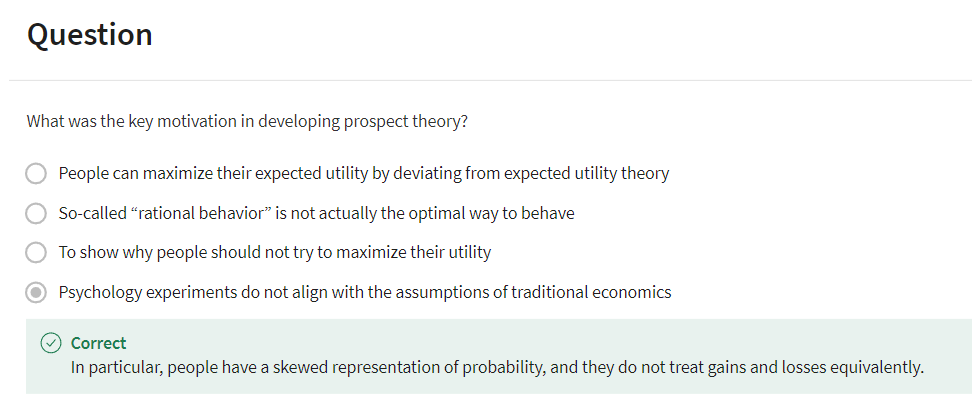
Chalk Talk - More on Prospect Theory
Professor I was wondering if we could go over some of the key features of Prospect Theory at a very high level, and just kind of talk about what features it has as well as how it might be different from more traditional approaches. Well, Prospect Theory is written by two psychologists and not economist, Daniel Kahneman and Amos Tversky, over 30 years ago, overturning, yeah, a key assumption of much economics that represents people as rational and calculating in a sensible way. So what Kahneman and Tversky said is that people are, maybe that’s a little bit rational, but it looks a little screwy what people do actually. And what they did is a number of experiments that show about decisions under uncertainty, that show funny behavior of individuals. So how to present it? The thing that it takes off from is the economist’s idea that people are maximizers, you know, we’re all calculating, we’re all out there figuring out, now to some extent we are. But what is it that we maximize? So economists say utility. And then this also have to recognize that people, utility is happiness or something like that, but they also recognize that you don’t know the outcome before you make your decision, so it’s random. So we have to say expected utility. This is traditional economists, I know what I want, and I am very consistent in pursuing that under uncertainty.
But Kahneman and Tversky said, well you know, people don’t always do that. Let’s talk. Okay, let’s talk about flipping a coin. Sure. I’m going to propose to you let’s toss a coin, if it comes up heads, I will pay you $200. If it comes up tails, you pay me $100. You want to do it? Yeah. I’m a little hesitant. But it’s a positive expected value because it’s equally likely the two are going to be one of them. I pay you 200. Right. But you only pay me 100 if it goes the other way. Right. So you have an expected gain of $50. So you know you said you were a little hesitant. Since I’m a grad student–. You’re not going to say no because you know what the right answer. The rational answer is. Right. The rational answer from expected utility theory is, of course I’ll take it because if it has positive expected value I will take lots of those bets, and they’ll all average out to a gain. And so you should take it unless there’s something very unusual about your utility.
So what Kahneman and Tversky said is that people have a value function. So I draw a curve here. Won’t be a curve. This is gains on this axis, and this is, they call it value, but it’s happiness or utility. And it’s the curve is kink like this. All right. This is where we are now. Right. The reference point. This is it for you. Right. Plus 200. And this is for you, minus, this is minus 100, right? So you’re looking at your happiness. Well you’re thinking, well plus 200 only gives me a little happiness, this amount. But losing 100 gives me a lot of unhappiness. So I won’t. You won’t do it. This kink here represents this is where we are now. Right. In Prospect Theory there’s always a kink where you are now. Now, you could make $10000 more in your work let’s say, and it push you way over here, the kink moves with you. It’s always there. So if at any point of time you’re always worrying about losses. Okay, relative to where you are now. But, yes relative to where you are now, but this is irrational because you should- any time anyone offers this bet to you, you should always take it. And you know if you do it many times, you’ll come out ahead on average but people don’t. That represents an irrational behavior that Kahneman and Tversky called loss aversion. We worry so much about losing money, we don’t have the idea that on average I’ll be fine. I just don’t, but you don’t feel you don’t feel that way. Any time that you make a loss, you kick yourself and you feel bad. So you don’t want it, you don’t want to take that chance. I see. And that’s irrational behavior, and it’s demonstrated that people behave this way. Okay, and so just to reiterate, it’s this steep curve that is kind of what is the key to all this. Right. That kink that you said follows you around. You’re always worried about little losses today.
Logical Fallacies
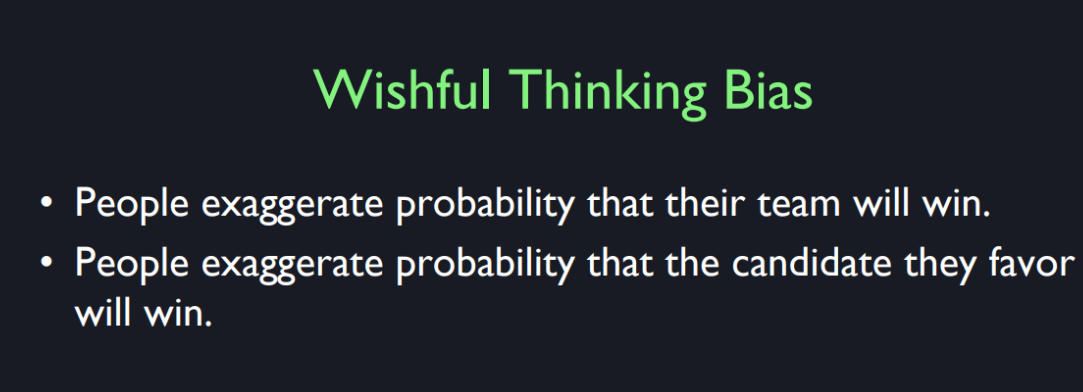
The second thing is overconfidence. Well, you can just do survey. Most people think they’re above average. Most people think they’re a better
driver than the average person. Most people think if they tried hard, they would be a better investor
than the average person. Most people think they understand
something that are not widely understood. Wishful thinking bias is actually
a term used in the psych literature that people overestimate the probability of the things that they identify with and
want to see happen. Very simple, you ask people what they think
the probability of their team winning is. And it’s always higher if it’s their
team or a political candidate. So this wishful thinking
bias also helps explain the immense volume of trade
in financial markets. There’s so many shares traded
every day that it seems a puzzle. Why would people need to change
their holdings so often? Well it must be because
of wishful thinking bias. There’s also a tendency for
overconfidence in friends and leaders. Well I say here the central bankers
tend to be, thought to be a genius. Throughout history, they’re always
geniuses until they mess up maybe, but there’s also overconfidence
in your own friends. You tend to think that your own friends
are really smarter than average, it’s not just you. Anyone you identify with,
you tend to be overconfident in.
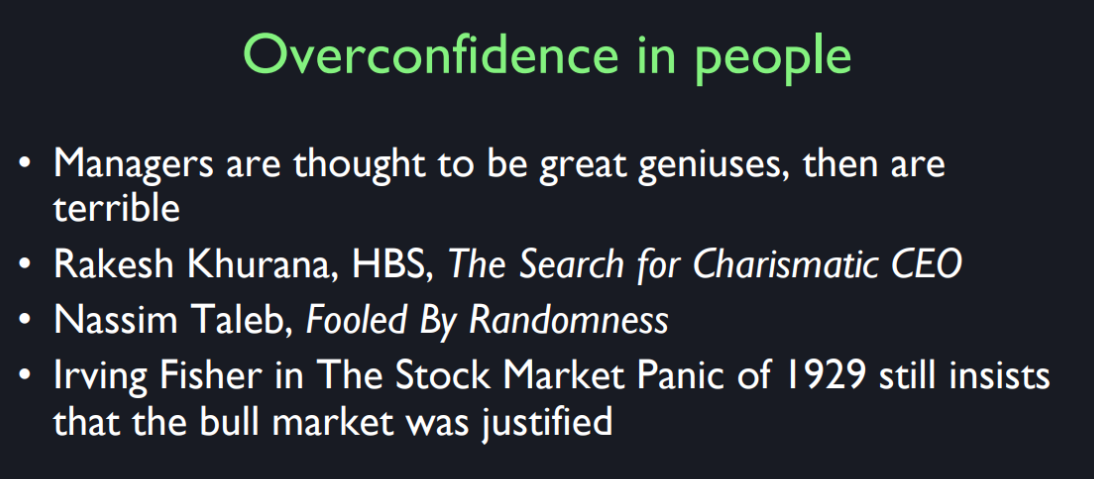
So, there was a book by Rakesh Khurana,
at the Harvard Business School, that documents the way CEOs, Chief Executive Officers,
are chosen by corporations. Now companies will bring in
a CEO from another company, that was a success,
to transform their own company. And pass over someone in their own company
who knows the business really well, and has been there 30 years, and
might well be promoted up to CEO. But they’ll take in someone from another
company that was a success there, without regard for the fact that it was probably mainly
luck that this person was a success. And they’ll put him in in
place of their own guy, and then he feels that he has
to make some transformation. He’s supposed to be a genius,
they’re paying him $50 million. So he does some dramatic things and
totally destroys the company, because he doesn’t know
what he’s talking about. Also, Nassim Taleb in his
book Fooled by Randomness, which is another great book to read, describes how people in
business are overly influenced by the random successes of themselves or
others. People are over, now Irving Fisher
was a professor here at Yale. And he wrote a book, he was writing
a book in 1929 about how the stock market will continue to make us richer and
richer. But the crash interrupted his book, so
he had to change the title of the book. So he called it The Stock Market Crash and
After. But what he said is the stock market crash
of 1929 is a terrific buying opportunity. I was right all along,
the stock market will just keep going up, or at least stay at a quote,
permanently high plateau. He ultimately borrowed money
to try to stay in the market. He borrowed money from his relatives,
he lost everything. He lost his house,
he had no place to live. His house is right near
here on Prospect Street. It was, they tore it down, it’s gone. Yale had to give him a place to live. But he never gave up, he kept saying that
the stock market will keep going up. Why do people do this? Well this is overconfidence,
and he’s a great speaker. But he wasn’t a great
stock market forecaster.
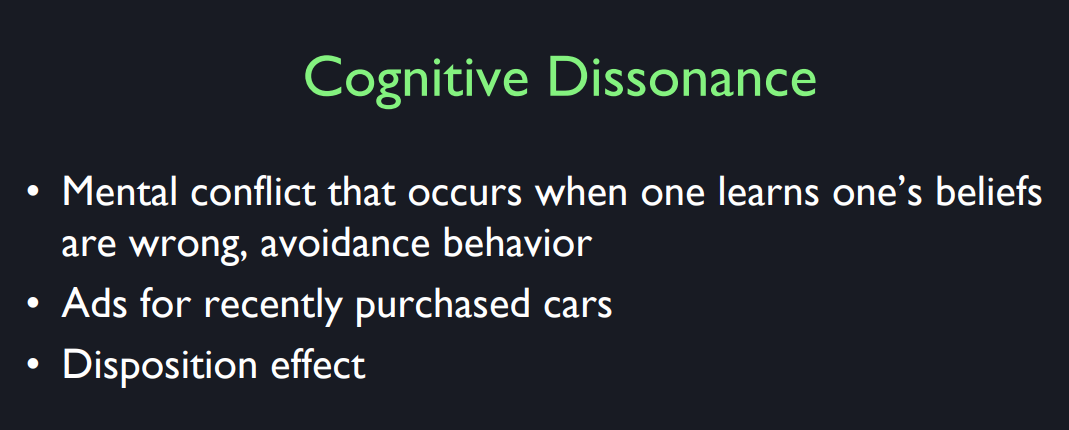
Cognitive dissonance, this is a term
used by social psychologists. It refers to the mental conflict
that occurs when one’s beliefs are discovered to be wrong. So I’ll give you a famous experiment
that revealed cognitive dissidence. The experimenters went to get a list from car dealers of people who
had just bought a new car. They knew that the person had bought a new
car and they knew what model it was. They then didn’t tell the subjects
how they had found them, and they asked them,
what magazines do you read?. And when they named the magazine,
they would pull out a copy, they had all the new magazines there and
say, lets go through the magazine. And you tell me which ads
you read in the magazine and also whether you thought about them and
read them carefully. So, what do you think people did? Did they read ads for
the car they just bought? Yes, they did that strongly. They read and reread and congratulated
themself about how great a car it was. Do you think they read the ads of a car
that they, a different make of car, that they were thinking of buying but
did not buy? As you expect, no,
they don’t read those ads. So why are they doing,
isn’t this irrational behavior? You’ve already bought the car,
why bother to read any ads? But on the other hand, why would
you selectively ignore the ads for the other cars? You’re just trying to make
yourself feel good, right? And so, it’s irrational behavior. Once you’ve made a decision, you kind of
identify with that decision and it’s me. Now I want to hear more
about why I was right. I don’t want to hear
that I might be wrong. It’s a personal thing, this isn’t really talking about
being embarrassed by a bad decision. It’s just perfectly internal to you
that you just get a bad feeling when you made a mistake. So the disposition effect might also
be partially explained by that. If you bought a stock and
its price goes down, you’re feeling that maybe you were wrong
and that gives you a cognitive dissidence. So you just avoid it, I’m not going to
think about that stock, I didn’t buy that, I’m not here. And then, until it goes up,
if it goes back up, then you might sell it as
soon as it comes back.
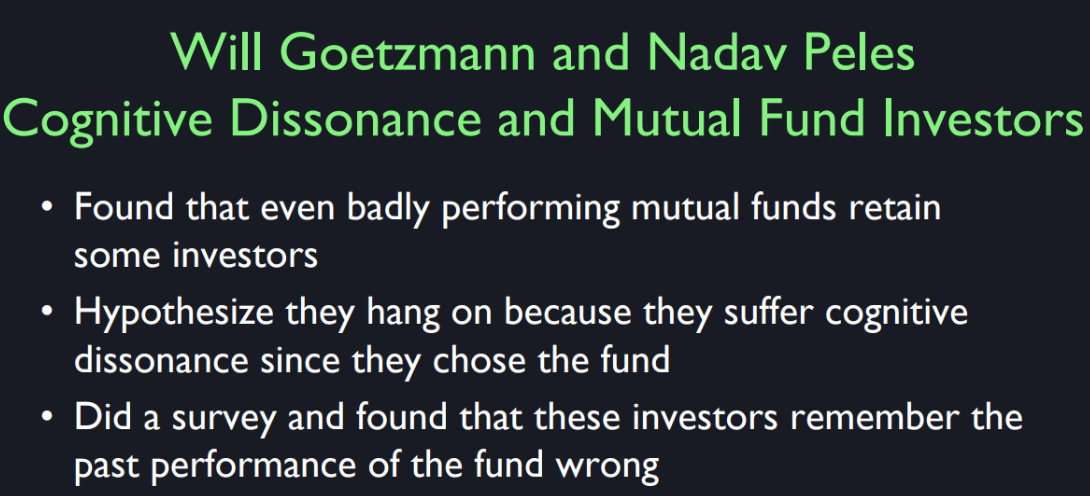
So Will Goetzmann here at Yale with Nadav
Peles looked at mutual fund investors. These tend to be small
retail investors and they found evidence for cognitive dissonance,
basically the disposition effect. But they also found that when
they talked to investors, they didn’t even remember the performance
of funds that had declined. So there’s a tendency of human thought
because of cognitive dissonance, just to blank out your bad memories
of times when you were wrong, and don’t even know that they happen. We live in an economy
that incentivizes people to capitalize on your
psychological quirks. And they strongly incentivize
people to do that. That’s what the profit
motive is all about.
So, do you think that we’re not
rational with these quirks, or would you agree that
most people are rational? >> Well, yeah, we’re not rational. I’m not rational, I don’t know about you. We’re not rational in the sense
that we have some consistent logical way of deciding things. We all make little mistakes and
we learn, by the way, we hear from others about when they
were really taken advantage of so we avoid some things, some gimmicks. And we have laws against them. The government regulates lotteries,
you can’t start a lottery. You can’t do it at all, or maybe you could
do it as part of a state government. And that’s because they know that
there are lots of giveaway contests, but they don’t charge,
because it’s illegal to charge for them. They can just use them as publicity. So we have a legal system that protects us
against our own psychological failings.
Bull Market and Bear Market in the Stock Market
Definitions
Bull Market:
- A bull market refers to a period in the financial market when the prices of securities are rising or are expected to rise. This term is most commonly used to refer to the stock market, but it can be applied to anything that is traded, such as bonds, currencies, and commodities.
- Characteristics:
- Increased investor confidence.
- Higher trading volumes.
- Positive economic indicators such as low unemployment and high GDP growth.
Bear Market:
- A bear market is the opposite of a bull market. It refers to a period when the prices of securities are falling or are expected to fall.
- Characteristics:
- Decreased investor confidence.
- Lower trading volumes.
- Negative economic indicators such as high unemployment and low GDP growth.
Origins of the Terms
Bull Market:
- The term “bull market” is believed to have originated from the way a bull attacks its prey – by thrusting its horns upward. This upward motion symbolizes the increase in market prices.
Bear Market:
- Similarly, “bear market” is thought to come from the way a bear attacks – by swiping its paws downward, symbolizing a decrease in market prices.
Causes of Bull and Bear Markets
Economic Indicators:
- Bull Market: Strong economic growth, low unemployment, high consumer confidence, and increased corporate profits often lead to bull markets.
- Bear Market: Economic recession, high unemployment, low consumer confidence, and declining corporate profits often lead to bear markets.
Interest Rates:
- Bull Market: Lower interest rates make borrowing cheaper, encouraging spending and investment, which can drive market prices up.
- Bear Market: Higher interest rates make borrowing more expensive, discouraging spending and investment, which can drive market prices down.
Market Sentiment:
- Bull Market: Optimism and positive news about future economic performance can drive more investors to buy, pushing prices up.
- Bear Market: Pessimism and negative news about future economic performance can lead to more selling, pushing prices down.
Global Events:
- Bull Market: Favorable international developments, such as trade agreements or geopolitical stability, can boost investor confidence.
- Bear Market: Unfavorable international developments, such as trade wars, geopolitical tensions, or pandemics, can reduce investor confidence.
Example of Bull and Bear Markets
Bull Market Example:
- The longest bull market in U.S. history started in March 2009 after the financial crisis and lasted until March 2020, driven by economic recovery, low interest rates, and strong corporate earnings.
Bear Market Example:
- The global financial crisis of 2008 led to a significant bear market, with major stock indices losing more than half of their value due to the collapse of the housing market and the subsequent economic recession.
Conclusion
Understanding bull and bear markets is crucial for investors as it helps them make informed decisions about when to buy or sell securities. While bull markets present opportunities for growth and profits, bear markets often require more cautious investment strategies to protect against losses.
股市中的牛市和熊市
定义
牛市:
- 牛市指的是金融市场中证券价格普遍上升或预期上升的时期。这个术语最常用于股票市场,但也可以适用于交易的其他资产,如债券、货币和商品。
- 特征:
- 投资者信心增加。
- 交易量上升。
- 积极的经济指标,如低失业率和高GDP增长。
熊市:
- 熊市是牛市的反义词,指的是证券价格普遍下降或预期下降的时期。
- 特征:
- 投资者信心下降。
- 交易量减少。
- 消极的经济指标,如高失业率和低GDP增长。
术语的起源
牛市:
- “牛市”这个术语可能源自牛攻击猎物的方式——用角向上顶。这个向上的动作象征着市场价格的上升。
熊市:
- 类似地,“熊市”被认为源自熊攻击时的方式——用爪子向下拍,这象征着市场价格的下降。
牛市和熊市的成因
经济指标:
- 牛市:强劲的经济增长、低失业率、高消费者信心和企业利润增加通常会导致牛市。
- 熊市:经济衰退、高失业率、低消费者信心和企业利润下降通常会导致熊市。
利率:
- 牛市:较低的利率使借贷成本降低,鼓励消费和投资,从而推动市场价格上涨。
- 熊市:较高的利率使借贷成本增加,抑制消费和投资,从而导致市场价格下跌。
市场情绪:
- 牛市:对未来经济表现的乐观和积极消息会驱使更多投资者买入,推动价格上涨。
- 熊市:对未来经济表现的悲观和负面消息会导致更多投资者卖出,导致价格下跌。
全球事件:
- 牛市:有利的国际发展,如贸易协议或地缘政治稳定,可以增强投资者信心。
- 熊市:不利的国际发展,如贸易战、地缘政治紧张或疫情,可能会减少投资者信心。
牛市和熊市的例子
牛市例子:
- 美国历史上最长的牛市始于2009年3月金融危机之后,持续到2020年3月,这段时间内经济复苏、低利率和企业盈利强劲推动了市场价格上涨。
熊市例子:
- 2008年的全球金融危机导致了显著的熊市,主要股指因房地产市场崩溃和随后的经济衰退而损失了一半以上的价值。
结论
理解牛市和熊市对投资者来说至关重要,因为这有助于他们在买卖证券时做出明智的决策。牛市提供了增长和获利的机会,而熊市则通常需要更谨慎的投资策略来防止损失。
Mutual Fund
A mutual fund is an investment vehicle that pools together money from many investors to purchase a diversified portfolio of stocks, bonds, or other securities. It is managed by professional portfolio managers who aim to achieve specific investment objectives. Here’s a detailed introduction to mutual funds:
Key Features of Mutual Funds
Pooling of Funds:
- Multiple investors contribute money to a common pool, which is then invested in a variety of securities. This allows individual investors to access a diversified portfolio that they might not be able to achieve on their own.
Professional Management:
- Mutual funds are managed by professional fund managers who make decisions about which securities to buy and sell. These managers have expertise and resources to conduct thorough research and analysis.
Diversification:
- By investing in a wide range of assets, mutual funds reduce the risk associated with individual securities. Diversification helps mitigate the impact of poor performance of any single investment on the overall portfolio.
Liquidity:
- Mutual funds offer liquidity, meaning investors can easily buy and sell their shares in the fund. Mutual fund shares are typically bought and sold at the net asset value (NAV) at the end of each trading day.
Variety of Types:
- There are various types of mutual funds catering to different investment objectives, such as equity funds, bond funds, money market funds, index funds, and balanced funds.
Types of Mutual Funds
Equity Funds:
- Invest primarily in stocks. They aim for capital growth over the long term. Examples include growth funds, value funds, and sector funds.
Bond Funds:
- Invest in bonds or other debt securities. They aim for income generation and preservation of capital. Examples include government bond funds, corporate bond funds, and municipal bond funds.
Money Market Funds:
- Invest in short-term, high-quality debt instruments. They aim for stability and liquidity, often used as a place to park cash temporarily.
Index Funds:
- Aim to replicate the performance of a specific index, such as the S&P 500. They offer broad market exposure and typically have lower fees due to passive management.
Balanced Funds:
- Invest in a mix of stocks and bonds to provide a balance of growth and income. They aim for moderate risk and return.
Advantages of Mutual Funds
Diversification:
- Reduces the risk by spreading investments across a wide range of securities.
Professional Management:
- Provides access to expert knowledge and investment strategies.
Affordability:
- Allows small investors to invest in a diversified portfolio with a relatively small amount of money.
Liquidity:
- Easy to buy and sell shares, offering flexibility to investors.
Transparency:
- Mutual funds are regulated and required to disclose their holdings and performance, providing transparency to investors.
Disadvantages of Mutual Funds
Fees and Expenses:
- Management fees, administrative costs, and other expenses can eat into returns. These include expense ratios and sometimes sales loads (commissions).
Lack of Control:
- Investors do not have a say in individual investment decisions made by the fund manager.
Performance Fluctuations:
- The performance of mutual funds can be volatile, especially equity funds, and past performance is not a guarantee of future results.
Tax Implications:
- Investors in mutual funds may incur tax liabilities from capital gains distributions made by the fund.
Conclusion
Mutual funds provide a convenient and efficient way for investors to access a diversified portfolio of securities managed by professionals. They offer various types of funds to suit different investment objectives and risk tolerances. However, investors should be aware of the fees, lack of control over individual investments, and potential tax implications. Understanding these factors can help investors make informed decisions about including mutual funds in their investment strategy.
共同基金
共同基金是一种投资工具,通过汇集众多投资者的资金,购买一组多样化的股票、债券或其他证券。共同基金由专业的投资组合经理管理,他们旨在实现特定的投资目标。以下是对共同基金的详细介绍:
共同基金的主要特点
资金汇集:
- 多个投资者将资金汇集到一个共同的池中,然后将这些资金投资于各种证券。这使得个人投资者能够获得他们可能无法单独实现的多样化投资组合。
专业管理:
- 共同基金由专业的基金经理管理,他们负责决定买卖哪些证券。这些经理具备专业知识和资源,能够进行深入的研究和分析。
多样化:
- 通过投资于广泛的资产组合,共同基金减少了单个证券的风险。多样化有助于减轻任何单项投资表现不佳对整体投资组合的影响。
流动性:
- 共同基金提供流动性,这意味着投资者可以轻松买卖基金份额。共同基金份额通常在每个交易日结束时按净资产值(NAV)进行买卖。
多种类型:
- 共同基金有多种类型,满足不同的投资目标,如股票型基金、债券型基金、货币市场基金、指数基金和平衡基金。
基金的类型
股票型基金:
- 主要投资于股票,目标是长期资本增长。例子包括成长型基金、价值型基金和行业基金。
债券型基金:
- 投资于债券或其他债务证券,目标是收入生成和资本保值。例子包括政府债券基金、公司债券基金和市政债券基金。
货币市场基金:
- 投资于短期、高质量的债务工具,目标是稳定和流动性,通常用于临时存放现金。
指数基金:
- 旨在复制特定指数(如标准普尔500指数)的表现,提供广泛的市场曝光,通常费用较低,因为是被动管理。
平衡基金:
- 投资于股票和债券的混合,提供增长和收入的平衡,目标是适中的风险和回报。
共同基金的优势
多样化:
- 通过分散投资于广泛的证券,减少风险。
专业管理:
- 提供专业知识和投资策略的访问。
经济实惠:
- 使小投资者能够以相对较小的金额投资于多样化的投资组合。
流动性:
- 容易买卖基金份额,提供投资者灵活性。
透明度:
- 共同基金受到监管,要求披露其持仓和表现,为投资者提供透明度。
共同基金的缺点
费用和开支:
- 管理费、行政成本和其他费用会侵蚀回报。这些费用包括费用比率,有时还有销售费用(佣金)。
缺乏控制:
- 投资者无法对基金经理的个别投资决策进行干预。
业绩波动:
- 共同基金的表现可能会波动,尤其是股票型基金,过去的表现不能保证未来的结果。
税务影响:
- 共同基金的投资者可能因基金的资本收益分配而产生税务负担。
结论
共同基金为投资者提供了一种便捷和高效的方式来访问由专业人士管理的多样化证券投资组合。它们提供各种类型的基金,以适应不同的投资目标和风险承受能力。然而,投资者应注意费用、缺乏对个别投资的控制以及潜在的税务影响。理解这些因素可以帮助投资者做出明智的决定,将共同基金纳入他们的投资策略中。
Differences Between Mutual Funds, Pension Funds, and Other Funds
Mutual funds, pension funds, and other types of funds have distinct characteristics, management styles, risk profiles, and objectives. Here’s a detailed comparison:
Mutual Funds
Characteristics
- Investment Objective: Aim to achieve specific investment goals such as capital growth, income generation, or capital preservation.
- Investment Range: Can invest in various asset classes including stocks, bonds, money market instruments, and other securities.
- Management Style: Managed by professional fund managers either actively or passively, with investment decisions made based on market conditions and fund objectives.
- Liquidity: Investors can buy and sell fund shares on any trading day.
- Fees: Typically include management fees, operating expenses, and sometimes sales charges (front-end or back-end loads).
Suitable For
- Investors seeking diversification, professional management, and the ability to invest in a broad portfolio with relatively small amounts of money.
Pension Funds
Characteristics
- Investment Objective: Designed to provide a stable source of income and capital growth for retirement.
- Investment Range: Generally invest in low-risk assets such as government bonds, corporate bonds, high-quality stocks, and real estate, with a focus on stable and predictable returns.
- Management Style: Managed by professional fund managers or employer investment committees, following a long-term investment strategy.
- Liquidity: Low liquidity, as funds are typically not accessible until retirement age.
- Fees: Usually have lower management fees, but long-term holding may incur significant costs.
Suitable For
- Individuals and employees looking to accumulate funds for retirement through long-term, stable investments.
Hedge Funds
Characteristics
- Investment Objective: Aim to achieve high returns using flexible and complex investment strategies while managing and hedging risks.
- Investment Range: Can invest in various assets including stocks, bonds, currencies, futures, options, and other derivatives, often using leverage.
- Management Style: Actively managed by professional fund managers using strategies such as long/short positions, market neutral, arbitrage, and global macro.
- Liquidity: Low liquidity with lock-up periods, restricting investors from redeeming their investments at any time.
- Fees: High fee structure, typically including management fees and performance fees (e.g., “2% management fee and 20% performance fee”).
Suitable For
- High-net-worth individuals and institutional investors seeking higher returns and willing to accept higher risks and fees.
Exchange-Traded Funds (ETFs)
Characteristics
- Investment Objective: Aim to track the performance of a specific index, sector, commodity, or asset portfolio.
- Investment Range: Can invest in stocks, bonds, commodities, currencies, and more.
- Management Style: Mostly passively managed to replicate a benchmark index, though some are actively managed.
- Liquidity: Traded on stock exchanges, allowing investors to buy and sell ETF shares like stocks during market hours.
- Fees: Typically low fees due to passive management.
Suitable For
- Investors looking for exposure to specific markets or indices with the flexibility of stock trading and low fees.
Private Equity Funds
Characteristics
- Investment Objective: Aim to achieve high returns through direct investments in private companies, acquisitions, restructurings, and other strategic initiatives.
- Investment Range: Primarily invest in private companies, unlisted businesses, and leveraged buyouts.
- Management Style: Actively managed by professional teams who often participate in the strategic decision-making and operations of the invested companies.
- Liquidity: Very low liquidity with long investment horizons (5-10 years or more), making it difficult for investors to withdraw funds before the fund’s term ends.
- Fees: High fees, including management fees and performance fees.
Suitable For
- High-net-worth individuals and institutional investors looking to participate in the long-term growth and development of private companies.
Conclusion
Each type of fund serves different investment needs and objectives. Mutual funds offer a way for ordinary investors to achieve diversification and professional management. Pension funds are tailored for individuals saving for retirement. Hedge funds and private equity funds are aimed at high-net-worth individuals and institutions looking for complex strategies and higher returns. ETFs provide a flexible, low-cost option for gaining exposure to specific markets or indices.
Understanding these differences helps investors choose the right investment vehicle based on their risk tolerance, investment goals, and liquidity needs.
共同基金、养老基金以及其他类型的基金在投资目标、管理方式、风险和回报等方面有不同的特点。以下是对这些基金的详细对比:
共同基金(Mutual Funds)
特点
- 投资目标:共同基金旨在实现特定的投资目标,例如资本增长、收入生成或保值。
- 投资范围:共同基金可以投资于多种资产类别,包括股票、债券、货币市场工具和其他证券。
- 管理方式:由专业的基金经理主动或被动管理,投资决策由基金经理根据市场情况和基金的投资目标做出。
- 流动性:投资者可以在任何交易日买卖基金份额。
- 费用:通常包括管理费、运营费用,有时还有销售费用(前端或后端收费)。
适用对象
- 适合希望通过专业管理和多样化投资组合来分散风险的投资者。
养老基金(Pension Funds)
特点
- 投资目标:养老基金主要目标是为退休提供稳定的收入来源和资本增长,确保受益人在退休时有足够的资金。
- 投资范围:通常投资于低风险资产,如政府债券、公司债券、优质股票和房地产,逐步增加低风险、稳定回报的资产配置。
- 管理方式:由专业的基金管理机构或雇主的投资委员会管理,遵循长期投资策略。
- 流动性:流动性较低,通常直到退休年龄才能提取资金。
- 费用:管理费用较低,但长期持有中产生的费用可能较高。
适用对象
- 主要面向工作期间希望为退休积累资金的个人和雇员。
对冲基金(Hedge Funds)
特点
- 投资目标:对冲基金旨在通过灵活和复杂的投资策略实现高回报,同时管理和对冲风险。
- 投资范围:可以投资于各种资产,包括股票、债券、货币、期货、期权等,使用杠杆和衍生品来增强回报。
- 管理方式:由专业基金经理主动管理,使用多种策略如长短仓、市场中性、套利、全球宏观等。
- 流动性:流动性较低,通常有锁定期,投资者只能在特定时间窗口内赎回资金。
- 费用:费用结构较高,通常包括管理费和绩效费(如“2%管理费和20%绩效费”)。
适用对象
- 面向高净值个人和机构投资者,通常对投资者的资格有较高要求。
交易所交易基金(ETF)
特点
- 投资目标:ETF旨在追踪特定指数、行业、商品或资产组合的表现。
- 投资范围:可以投资于股票、债券、商品、货币等多种资产。
- 管理方式:大多为被动管理,目的是复制基准指数的表现,但也有主动管理的ETF。
- 流动性:在交易所交易,投资者可以像股票一样在市场开放时买卖ETF份额。
- 费用:通常费用较低,因为大多数ETF是被动管理的。
适用对象
- 适合希望获得特定市场或指数曝光的投资者,同时享有交易灵活性和低费用的优势。
私募股权基金(Private Equity Funds)
特点
- 投资目标:私募股权基金旨在通过直接投资于私营企业、收购、重组等方式实现高回报。
- 投资范围:主要投资于私营企业、未上市公司以及杠杆收购等。
- 管理方式:由专业的基金管理团队主动管理,通常参与被投资企业的战略决策和运营管理。
- 流动性:流动性很低,投资期限通常较长(5-10年或更长),投资者在基金寿命结束前难以赎回资金。
- 费用:费用较高,包括管理费和绩效费。
适用对象
- 适合高净值个人、机构投资者和希望参与企业长期成长和发展的投资者。
结论
每种基金类型都有其独特的特点和适用对象。共同基金适合希望通过专业管理和多样化投资组合来分散风险的普通投资者;养老基金主要面向工作期间希望为退休积累资金的人群;对冲基金和私募股权基金则主要面向高净值个人和机构投资者,提供复杂的投资策略和潜在高回报;ETF提供了一种灵活、低费用的方式来获得特定市场或指数的曝光。
了解这些差异可以帮助投资者根据自己的风险承受能力、投资目标和流动性需求选择合适的投资工具。
Hedge Funds: Detailed Explanation
Origin of the Name “Hedge Fund”
The term “hedge fund” comes from the original strategy employed by these funds, which involved hedging investments to reduce risk. The first hedge fund, created by Alfred Winslow Jones in 1949, used both long and short positions in stocks to hedge market risk. This strategy aimed to maximize returns while minimizing potential losses, thereby “hedging” against market fluctuations.
Key Features of Hedge Funds
Investment Strategies:
- Long/Short Equity: Investing in undervalued stocks (long positions) while shorting overvalued stocks (short positions).
- Market Neutral: Aiming to offset long and short positions to reduce market risk.
- Global Macro: Investing based on macroeconomic trends and events across the globe.
- Event-Driven: Focusing on opportunities arising from corporate events such as mergers, acquisitions, or bankruptcies.
- Arbitrage: Exploiting price discrepancies between related securities.
- Distressed Securities: Investing in companies experiencing financial difficulties.
Management Style:
- Actively managed by professional fund managers who employ a variety of sophisticated strategies.
- Fund managers often have significant discretion in investment decisions, allowing for a high degree of flexibility.
Use of Leverage and Derivatives:
- Hedge funds frequently use leverage (borrowed funds) to amplify returns.
- Derivatives (such as options and futures) are used to manage risk, enhance returns, or hedge positions.
Fee Structure:
- Typically charge both a management fee (usually around 2% of assets under management) and a performance fee (around 20% of profits).
- This fee structure aligns the interests of fund managers with those of investors, incentivizing strong performance.
Investor Requirements:
- Generally open to accredited investors, high-net-worth individuals, and institutional investors due to regulatory requirements and high minimum investment thresholds.
- Often have lock-up periods during which investors cannot withdraw their capital, enhancing stability but reducing liquidity.
Regulatory Environment:
- Less regulated than mutual funds and other investment vehicles, providing greater flexibility in investment strategies.
- Subject to fewer disclosure requirements, which allows for proprietary and confidential investment approaches.
Advantages of Hedge Funds
Potential for High Returns:
- The use of diverse and complex strategies can yield significant returns, especially in volatile or declining markets.
Risk Management:
- Hedging techniques and diversified strategies aim to manage and mitigate various types of risk.
Portfolio Diversification:
- Hedge funds can add a layer of diversification to an investor’s portfolio, reducing overall risk.
Access to Expertise:
- Managed by experienced professionals with deep market knowledge and advanced investment techniques.
Disadvantages of Hedge Funds
High Fees:
- Management and performance fees can significantly reduce net returns to investors.
Illiquidity:
- Lock-up periods and restrictions on withdrawals limit investors’ ability to access their capital quickly.
High Risk:
- Use of leverage and complex strategies can lead to substantial losses, especially if the strategies do not perform as expected.
Lack of Transparency:
- Fewer regulatory requirements mean less information is available to investors, making it harder to assess risk.
Examples of Hedge Fund Strategies
- Long/Short Equity: A manager might go long on undervalued tech stocks while shorting overvalued retail stocks.
- Event-Driven: Investing in a company poised to merge, anticipating the merger will drive up the stock price.
- Global Macro: Investing in commodities or currencies based on geopolitical developments.
Conclusion
Hedge funds are specialized investment vehicles designed to achieve high returns through a variety of advanced and flexible strategies. While they offer potential for significant gains and portfolio diversification, they also come with higher fees, greater risk, and less liquidity compared to traditional investment funds. Understanding these factors is crucial for investors considering hedge fund investments.
对冲基金详细介绍
“对冲基金”名称的由来
“对冲基金”(Hedge Fund)这个名称源于最初采用的投资策略,即通过对冲(hedging)来减少风险。1949年,阿尔弗雷德·温斯洛·琼斯(Alfred Winslow Jones)创建了第一个对冲基金,使用股票的多头和空头头寸来对冲市场风险。这种策略旨在最大化回报的同时,尽量减少潜在损失,从而对市场波动进行“对冲”。
对冲基金的主要特点
投资策略:
- 多头/空头策略(Long/Short Equity):投资于被低估的股票(多头头寸)并做空被高估的股票(空头头寸)。
- 市场中性策略(Market Neutral):通过平衡多头和空头头寸来减少市场风险。
- 全球宏观策略(Global Macro):基于全球宏观经济趋势和事件进行投资。
- 事件驱动策略(Event-Driven):专注于公司事件(如并购、破产等)带来的投资机会。
- 套利策略(Arbitrage):利用相关证券之间的价格差异进行套利。
- 困境证券策略(Distressed Securities):投资于财务困难的公司。
管理方式:
- 由专业基金经理主动管理,采用多种复杂策略。
- 基金经理通常具有高度的决策自由,允许灵活的投资。
杠杆和衍生品的使用:
- 对冲基金经常使用杠杆(借入资金)来放大回报。
- 使用衍生品(如期权和期货)来管理风险、提高回报或对冲头寸。
费用结构:
- 通常收取管理费(一般为资产管理规模的2%)和绩效费(约为利润的20%)。
- 这种费用结构使基金经理的利益与投资者的利益一致,激励强劲表现。
投资者要求:
- 通常只对合格投资者、高净值个人和机构投资者开放,因为监管要求和高最低投资门槛。
- 通常有锁定期,期间投资者不能提取资金,从而增强稳定性但降低流动性。
监管环境:
- 比共同基金和其他投资工具的监管少,提供了更大的投资策略灵活性。
- 披露要求较少,允许采用专有和保密的投资方法。
对冲基金的优势
高回报潜力:
- 使用多样和复杂的策略可以在波动或下跌的市场中获得显著回报。
风险管理:
- 对冲技术和多元化策略旨在管理和减少各种风险。
投资组合多样化:
- 对冲基金可以为投资者的投资组合增加多样化,降低整体风险。
专业知识:
- 由经验丰富的专业人士管理,具备深厚的市场知识和高级投资技术。
对冲基金的劣势
高费用:
- 管理费和绩效费会显著减少投资者的净回报。
流动性差:
- 锁定期和提取限制使投资者难以快速获取资金。
高风险:
- 杠杆和复杂策略的使用可能导致重大损失,特别是当策略未按预期表现时。
缺乏透明度:
- 较少的监管要求意味着可供投资者评估风险的信息较少。
对冲基金策略示例
- 多头/空头策略:经理可能会在低估的科技股上持有多头头寸,同时在高估的零售股上持有空头头寸。
- 事件驱动策略:投资于即将合并的公司,预期并购会推动股价上涨。
- 全球宏观策略:根据地缘政治发展投资于商品或货币。
结论
对冲基金是一种专门的投资工具,通过采用多种高级和灵活的策略来实现高回报。尽管它们提供了显著的收益潜力和投资组合多样化的机会,但相对于传统投资基金,它们也伴随着更高的费用、更大的风险和较低的流动性。理解这些因素对于考虑对冲基金投资的投资者来说至关重要。
The Brain
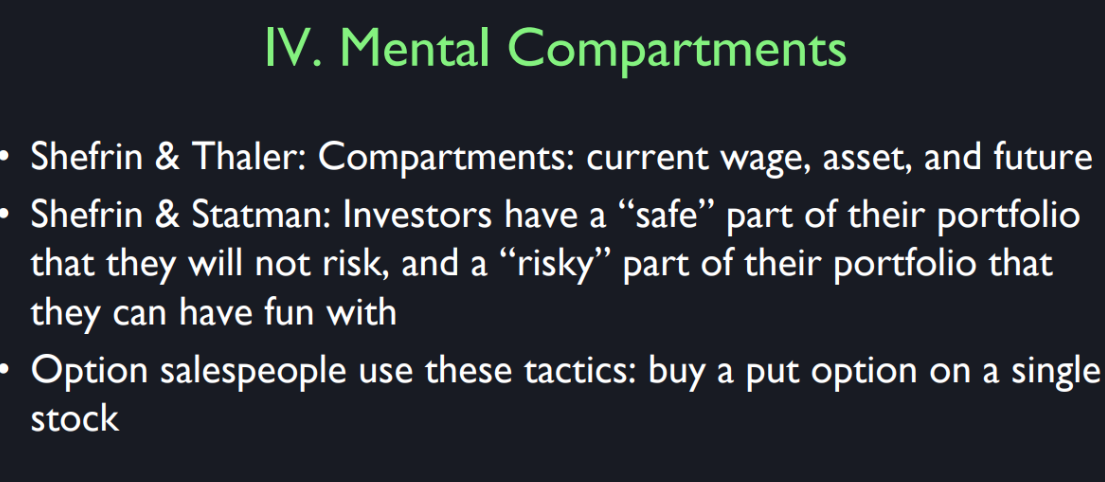
Fourth is mental compartments. So, Hurt Shefrin and Richard Thaler said that people- these are economists now talking about investors, that people don’t look at the whole portfolio the way the capital asset pricing model assumed. The theory says that you shouldn’t care about what your whole portfolio does, what’s it’s expected return and what’s at variance. But that’s not the way people think. In fact, Shefrin and Statman said that people have two portfolios often, or maybe even more than two- men talk about- but let’s just talk about two. You have a safe part of your portfolio that you will not risk and you have a risky part that you can have fun with. In fact, some people even said I talked to my spouse and we agreed that I can have fun investing for 20 percent of my- of our portfolio. Again, see that’s totally at variance with. And then at cocktail parties he or she will boast about how the fun portfolio did, rather than talk about the- They don’t talk about the overall thing, that’s boring. So option salesmen trying to get you to buy a put on a single stock and they will advertise it to you in such a way that does not make any reference to the impact this will have on your whole portfolio, which is probably minuscule. They don’t think that way.
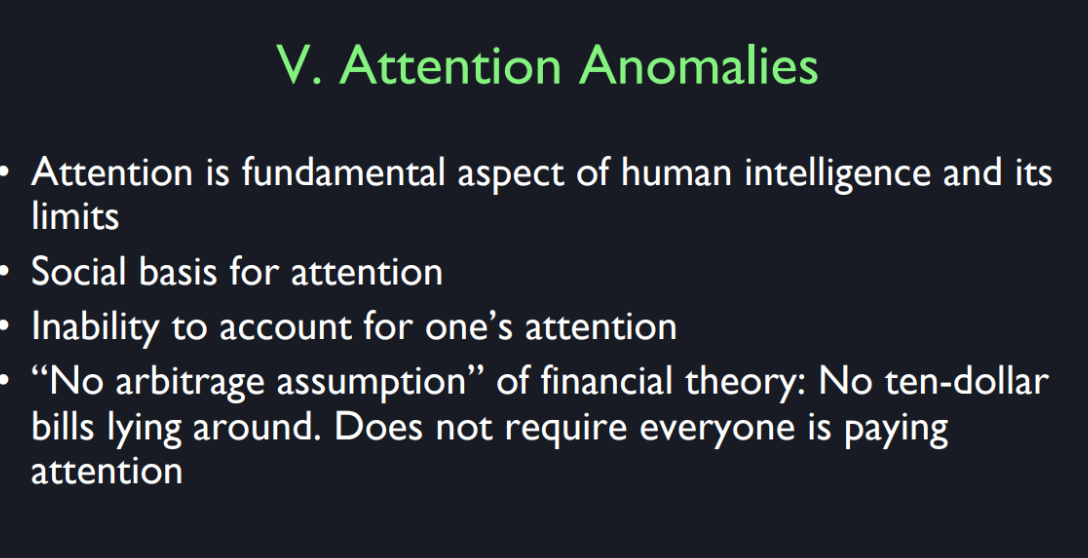
Fifth is attention anomalies, and that is that we tend not to pay atten- But first of all, psychologists have long understood that you can’t pay attention to everything. You have to decide, “Am I going to pay attention to the stock market? Should I watch it every day or is it a waste of my time? Should I be watching other things?” So, the problem is that too many people watch the stock market every day and if the market moves a lot, then they will even pay more attention to it even though a day to day move is irrelevant, generally.
There’s a social basis for attention and that is that you tend to pay attention to the same things that other people pay attention. Now this social basis for attention may have evolved for a good reason. So for example in a primitive caveman society, if somebody else is looking." What’s that over there?" You’ll look too. So will everybody. Maybe it’s maybe it’s a wolf coming to attack or who knows what it is. So we have that tendency to pay attention to everyone else at the same time. But what that means is, there’s going to be mispricings in markets. If everyone is paying attention to some stock, it creates the probability that it will be overpriced.
Now, in finance we tend to talk about the no arbitrage assumption, that is, that there is no way to make money without risk- no 10 dollar bills lying around on the sidewalk. That works counter to a- This is a theory that is not so vulnerable to attention anomalies. Have you ever found a $10 bill lying on the sidewalk? Probably not. Right? Maybe you have once in your life. Doesn’t happen very often. That’s because somebody will pick it up before you got to it. We do have an ability to pay attention to independently of others. So $10 bills get picked up. That means there’s no sure money machine. But when it comes to more ambiguous investing, then we become vulnerable to the attention anomaly. So, some stocks get overpriced and others are just forgotten, they’re underpriced because people aren’t thinking about them.

Anchoring refers to a tendency in ambiguous situations to allow one’s decisions to be affected by some anchor. So, the famous experiment that Kahneman and Tversky did involved a device called the Wheel of Fortune, which you might see on quiz shows. So what they did is they had a- they had a wheel with the numbers that were maybe 1 to 100 on the wheel, and the guy would spin the wheel and it would stop randomly on some number between 1 and a 100. So this is their experiment. They ask them questions that had numerical answers between 1 and a 100. So one of the questions was, “what percent of African nations belong to the United Nations?” Okay? Most people haven’t thought about that. Then they spin the wheel but they said, before you answer I want-I am just going to spin this wheel, ignore it. But they spin the wheel and it comes up with a number between 1 and a 100 and then Okay, now I want to hear the answer to your question. People tended to give a number close to the one that just came up on the wheel. Amazing. So then after the experiment, they pointed it out after the experiment was over they said, “did you know that you tended to pick a number close to the wheel?” And they would say, “no I didn’t, I wouldn’t pay attention to that.” It was subconscious. They were influenced by it, that’s anchoring.
So it it’s the same way I think with stock prices, that stock prices are anchored to past values. Nobody knows what this company is worth but it was worth something yesterday. And so, our opinions tend to be influenced by anchoring just as they were in the Kanneman and Tversky experiment. So, companies know that stock prices are anchored to past values. They also like to do splits with a- if a stock reaches $60 a share, they’ll split it so that it becomes $30 a share just because that seems to be a good solid anchor. I formed a company with my student here at Yale, Alan Weiss- Case-Shiller Weiss incorporated in 1991. And shortly after in the late 1990s, we were trying to raise money for our company and we went to an investment bank that was- heard us out. And he said, "Well, maybe we can come up with money for your business but, could you consider changing the name of your company? I don’t want it to be CSW inc. We want to be CSW.com. Now, if you know this is the dotcom bubble days in the late 1990s. So we had a meeting at our company. Should we change the name? We had a website in the late 90s, so we could call ourselves dotcom. We were selling on the web. But we didn’t do it. That was fake. That was trying to anchor us to the dot.com stocks. But you know there was a horrible dot.com bubble at the at the end of the 90. People would pay anything for a dot.com company. So it just didn’t make a lot of sense.
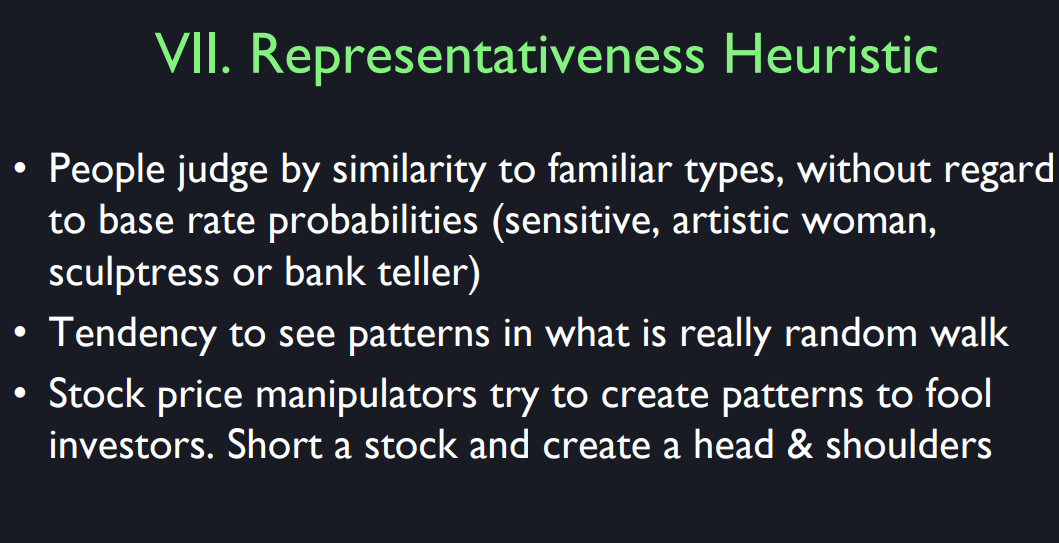
Seven is the Representativeness Heuristic. People judge things by familiarity to familiar types. So, there was a famous example illustrating the representativeness in heuristic, this is Kanneman and Tversky again. They described people in terms of their characteristic and then asked you to guess their occupation. For one of the persons for example, they describe a woman and said that she is sensitive, artistic. Okay. And then, you’re asked the, what would you just guess her occupation is? And the choices involved bank teller or sculptress. Well, people tended to take sculptress rather than bank tellers. Now Kanneman and Tversky said, “That’s totally wrong, because there are so many more bank tellers than there are sculptresses.” It’s not not a rational choice. But they looked to see the best fit rather than what is statistically probable. So for example, 1929 stock market crash is still widely remembered. I don’t know how well it is remembered for your generation but you’ve heard of it. Right? So you tend to look to see is it 1929 again? And if it fits 1929, you exaggerate the probability that we’re fist facing 1929 again.

disjunction effect是指无法在预期未来信息的情况下提前做出决策。
The disjunction effect is the inability to make decisions in advance in anticipation of future information. So for example, Shafir and Tversky actually did experiments with Samuelson’s lunch colleague bet. But then they did a variation of the experiment, they asked people to decide in advance whether they’ll take the second bet. And then most would not take the second bet before they knew the outcome of the first bet. What I’m saying is people couldn’t understand how they will feel later. They don’t anticipate their emotions later. So, they can’t work through a decision tree correctly.
So, with these biases people have, do you think there’s any way to try to mitigate them? Or do you think it’s better to try to accommodate them when we think about planning for our financial futures? Well, one thing that we can do is financial education. And that is important. Many people- there have been studies of the level of knowledge among the general population of financial basics and the general conclusion is, it is extremely low. For example, it’s pointed out that people don’t understand compound interest. But it goes even beyond that, they don’t even understand- a lot of people, maybe a minority. A lot of people if you say, “If the interest rate is 2 percent and there’s no compounding, how much do you have after five years?” They can’t answer that. They’ll say 2 percent. So, I mean- I don’t mean to be disparaging of these people, but there is a definite need for financial education. We also have to try to get a standard for presentation of facts about investments to people that are done in a way that’s not exploitive or manipulated. And we already have a lot of- they go back a long time, rules about how advertising can work and for financial products. It’s a difficult situation. But hey, we have a lot of young professionals who can work as regulators. And it’s not just government regulation, it’s also self-regulation within the industry. Things like better business bureaus and chambers of Commerce that impose a higher standard on business.
Options
Detailed Introduction to Options: Call and Put Options with Examples
Options are financial derivatives that provide the holder with the right, but not the obligation, to buy or sell an underlying asset (such as stocks, bonds, commodities, etc.) at a predetermined price (known as the strike price) before or on a specific date (the expiration date). There are two main types of options: call options and put options.
Call Options
- Definition: A call option gives the holder the right to buy the underlying asset at the strike price before or on the expiration date.
- Usage: Investors typically purchase call options when they expect the price of the underlying asset to rise.
Example
Assume you purchase a call option for a company’s stock:
- Underlying Asset: Stock of XYZ Company
- Strike Price: $50
- Option Premium: $5 (the cost of purchasing the option)
- Expiration Date: Three months from now
Scenario Analysis:
- Stock Price Rises: If the stock price rises to $60 after three months, you can exercise the option to buy the stock at $50 and then sell it in the market at $60, making a profit of ($60 - $50 - $5) = $5.
- Stock Price Stays the Same or Falls: If the stock price stays at $50 or falls below it, you can choose not to exercise the option. Your loss is limited to the option premium of $5.
Put Options
- Definition: A put option gives the holder the right to sell the underlying asset at the strike price before or on the expiration date.
- Usage: Investors typically purchase put options when they expect the price of the underlying asset to fall.
Example
Assume you purchase a put option for a company’s stock:
- Underlying Asset: Stock of XYZ Company
- Strike Price: $50
- Option Premium: $5
- Expiration Date: Three months from now
Scenario Analysis:
- Stock Price Falls: If the stock price falls to $40 after three months, you can exercise the option to sell the stock at $50 while buying it in the market at $40, making a profit of ($50 - $40 - $5) = $5.
- Stock Price Stays the Same or Rises: If the stock price stays at $50 or rises above it, you can choose not to exercise the option. Your loss is limited to the option premium of $5.
Advantages and Risks of Options Trading
Advantages
- Leverage: Options allow investors to control a large amount of the underlying asset for a relatively small investment (the option premium), potentially leading to significant returns.
- Limited Risk: The maximum loss for the buyer of an option is limited to the option premium paid.
- Flexibility: Options can be used for various strategies, including speculation, hedging, and income generation.
- Hedging Tool: Options can serve as a hedge to protect a portfolio against adverse market movements.
Risks
- Time Decay: Options have an expiration date, and the value of an option decreases as it approaches expiration, a concept known as time decay.
- High Risk: While the risk is limited to the option premium for buyers, options trading is inherently risky and can result in the loss of the entire premium.
- Complexity: Options trading is complex, requiring a deep understanding of option pricing, volatility, and market dynamics.
Conclusion
Options are versatile financial instruments that offer various strategies and flexibility, catering to different investment goals and risk appetites. Call options and put options are suitable for scenarios where investors are bullish or bearish on the underlying asset, respectively. Despite the potential for significant returns and hedging opportunities, options trading involves higher risks and complexities. Therefore, investors should thoroughly understand how options work and the associated risks before engaging in options trading.
期权的详细介绍
期权(Option)是一种金融衍生工具,它赋予持有人在特定时间以预定价格买入或卖出标的资产(如股票、债券、商品等)的权利,但不负有必须买入或卖出的义务。期权分为两种主要类型:看涨期权(Call Option)和看跌期权(Put Option)。
看涨期权(Call Option)
- 定义:看涨期权赋予持有人在特定日期之前(或特定日期)以预定价格(执行价格或行权价)购买标的资产的权利。
- 用途:投资者通常在预期标的资产价格将上涨时购买看涨期权。
实际例子
假设你购买了一份某公司股票的看涨期权:
- 标的资产:某公司股票
- 行权价:$50
- 期权费:$5(购买期权所支付的费用)
- 到期日:三个月后
场景分析:
- 股票价格上涨:如果三个月后,股票价格上涨到$60,你可以以$50的价格购买股票,然后在市场上以$60的价格卖出,盈利为($60 - $50 - $5)= $5。
- 股票价格不变或下跌:如果三个月后,股票价格仍为$50或以下,你可以选择不行使期权,损失仅为期权费$5。
看跌期权(Put Option)
- 定义:看跌期权赋予持有人在特定日期之前(或特定日期)以预定价格卖出标的资产的权利。
- 用途:投资者通常在预期标的资产价格将下跌时购买看跌期权。
实际例子
假设你购买了一份某公司股票的看跌期权:
- 标的资产:某公司股票
- 行权价:$50
- 期权费:$5
- 到期日:三个月后
场景分析:
- 股票价格下跌:如果三个月后,股票价格下跌到$40,你可以以$50的价格卖出股票,而在市场上以$40的价格买回股票,盈利为($50 - $40 - $5)= $5。
- 股票价格不变或上涨:如果三个月后,股票价格仍为$50或以上,你可以选择不行使期权,损失仅为期权费$5。
期权交易的优势和风险
优势
- 杠杆效应:期权合约通常只需要支付一小部分的期权费,但可以获得标的资产价格变动带来的较大回报。
- 有限风险:购买期权的最大损失仅为所支付的期权费。
- 灵活性:期权可以用于各种策略,如投机、对冲、组合投资等。
- 对冲工具:期权可以作为对冲工具来保护投资组合免受不利市场变动的影响。
风险
- 时间价值:期权有到期日,时间的流逝会导致期权价值下降(即时间价值损失)。
- 高风险:尽管风险有限,但期权交易本质上是高风险的,可能导致全部期权费的损失。
- 复杂性:期权交易较为复杂,需要深入理解期权定价、波动性和市场动态。
结论
期权作为一种金融工具,提供了多种策略和灵活性,适合不同的投资目的和风险偏好。看涨期权和看跌期权分别适用于对标的资产价格看涨或看跌的情景。尽管期权交易带来了显著的收益潜力和对冲机会,但也伴随着较高的风险和复杂性,因此投资者在进行期权交易之前,应充分了解期权的工作原理和潜在风险。
Using Options for Risk Hedging: Example, Principles, and Function
Principles of Using Options for Hedging
Hedging with options involves taking an options position to offset potential losses in another investment. The primary goal is to reduce the risk of adverse price movements in the underlying asset. By paying a premium, the investor obtains the right to buy or sell the underlying asset at a predetermined price, thus limiting potential losses.
Example of Using Options for Hedging
Scenario: Hedging a Stock Position with Put Options
Imagine you own 100 shares of XYZ Company, which is currently trading at $100 per share. You are concerned that the stock price might drop in the next few months but do not want to sell your shares. To hedge against this potential decline, you decide to buy put options.
- Underlying Asset: 100 shares of XYZ Company
- Current Stock Price: $100 per share
- Strike Price of Put Option: $95
- Option Premium: $3 per share
- Expiration Date: Three months from now
Steps and Analysis:
Buying the Put Option: You purchase one put option contract (representing 100 shares) with a strike price of $95, paying a total premium of $300 ($3 per share * 100 shares).
Stock Price Decline: If the stock price drops to $80 per share before the option’s expiration:
- You can exercise the put option, selling your shares at the strike price of $95.
- Without the put option, your shares would have lost $20 per share (from $100 to $80), resulting in a total loss of $2000 (100 shares * $20 loss per share).
- With the put option, you sell the shares at $95, limiting your loss to the option premium paid. Your net loss would be $500 (100 shares * ($100 - $95)) + $300 (option premium) = $800.
Stock Price Rise or Stability: If the stock price stays at $100 or rises:
- You do not exercise the put option, and your shares retain their value or increase in value.
- Your only cost is the option premium of $300, which serves as an insurance cost against the potential drop in stock price.
Function and Benefits of Hedging with Options
Risk Limitation: Hedging with options limits potential losses. In the example, the maximum loss was limited to the option premium plus any difference between the initial stock price and the strike price.
Cost of Insurance: The option premium acts as the cost of insurance. It is a small price paid to protect against significant adverse movements in the stock price.
Flexibility: Options provide flexibility. If the adverse price movement does not occur, the investor can let the option expire worthless, with the loss limited to the premium paid.
Peace of Mind: Hedging provides peace of mind, allowing investors to retain their positions without the fear of substantial losses due to market volatility.
Conclusion
Using options for hedging is a strategic way to manage and mitigate risks in an investment portfolio. By purchasing put options, investors can protect against potential losses in their stock holdings while maintaining the potential for gains if the stock price rises. The principle behind this strategy is to offset potential losses with gains from the options position, thereby limiting overall exposure to adverse price movements.
使用期权进行风险对冲:例子、原理和作用
使用期权进行对冲的原理
使用期权进行对冲是通过建立期权头寸来抵消另一投资中的潜在损失。主要目标是减少标的资产价格不利变动的风险。通过支付期权费,投资者获得在预定价格买入或卖出标的资产的权利,从而限制潜在的损失。
使用期权进行对冲的例子
情景:使用看跌期权对冲股票头寸
假设你拥有100股XYZ公司的股票,目前股价为每股100美元。你担心未来几个月股价可能会下跌,但又不想卖掉股票。为了对冲这种潜在的下跌风险,你决定购买看跌期权。
- 标的资产:XYZ公司股票100股
- 当前股价:每股100美元
- 看跌期权的行权价:每股95美元
- 期权费:每股3美元
- 到期日:三个月后
步骤和分析:
购买看跌期权:你购买了一份看跌期权合约(代表100股),行权价为每股95美元,总期权费为300美元(3美元/股 * 100股)。
股票价格下跌:如果在期权到期前股价跌至每股80美元:
- 你可以行使看跌期权,以每股95美元的价格卖出你的股票。
- 如果没有看跌期权,你的股票将损失每股20美元(从100美元跌至80美元),总损失为2000美元(100股 * 20美元)。
- 有了看跌期权,你可以以每股95美元的价格卖出股票,限制了损失,净损失为500美元(100股 * (100 - 95)) + 300美元(期权费)= 800美元。
股票价格上升或保持不变:如果股价保持在每股100美元或上升:
- 你可以选择不行使看跌期权,股票价值保持不变或增加。
- 你的唯一成本是期权费300美元,这相当于为对冲股价下跌风险支付的保险费用。
使用期权对冲的作用和优势
风险限制:使用期权对冲可以限制潜在损失。在上述例子中,最大损失被限制在期权费加上股票初始价格和行权价之间的差额。
保险成本:期权费相当于保险成本。这是为了保护股票价格下跌的风险而支付的一小部分费用。
灵活性:期权提供了灵活性。如果不发生价格不利变动,投资者可以让期权失效,损失仅限于支付的期权费。
安心:对冲提供了安心,使投资者能够保留他们的头寸,而不必担心由于市场波动而导致的重大损失。
结论
使用期权对冲是一种管理和减轻投资组合风险的策略。通过购买看跌期权,投资者可以在股价下跌时保护他们的股票持有,同时保持股价上涨时的盈利潜力。这种策略的原理在于,通过期权头寸的收益来抵消潜在的损失,从而限制整体暴露于不利价格变动的风险。
Call Option Example: Tencent Holdings
Scenario
Suppose you are optimistic about Tencent Holdings Limited (Ticker: 0700.HK) and expect its stock price to rise in the next few months. To capitalize on this expectation, you decide to buy a call option on Tencent’s stock.
- Underlying Asset: Tencent Holdings stock
- Current Stock Price: HKD 500 per share
- Strike Price: HKD 520 per share
- Option Premium: HKD 10 per share
- Expiration Date: Three months from now
Example Analysis
Buying the Call Option:
- You purchase one call option contract, which typically represents 100 shares.
- The total cost of the option premium is HKD 1,000 (HKD 10 per share * 100 shares).
Stock Price Increases:
- Suppose after three months, Tencent’s stock price rises to HKD 560 per share.
- You can exercise the call option to buy the stock at the strike price of HKD 520 per share and then sell it at the market price of HKD 560 per share.
- Profit calculation:
- Purchase cost: HKD 520 per share * 100 shares = HKD 52,000
- Sale proceeds: HKD 560 per share * 100 shares = HKD 56,000
- Net profit: HKD 56,000 - HKD 52,000 - HKD 1,000 (option premium) = HKD 3,000
Stock Price Remains Unchanged or Decreases:
- If after three months, Tencent’s stock price stays at HKD 500 per share or falls below, you can choose not to exercise the option.
- The loss is limited to the option premium paid, which is HKD 1,000.
Conclusion
By purchasing a call option, you can gain significant profit potential with a relatively small upfront cost if the stock price rises as expected. Even if the stock price does not increase, the maximum loss is limited to the amount paid for the option premium. In this example, if Tencent’s stock price rises to HKD 560 per share, exercising the call option results in a net profit of HKD 3,000. Conversely, if the stock price remains unchanged or decreases, the loss is capped at the HKD 1,000 option premium.
看涨期权的例子:以腾讯公司为例
情景设定
假设你看好腾讯公司(Ticker: 0700.HK)的股票,预期其股价将在未来几个月内上涨。为了利用这一预期,你决定购买腾讯公司的看涨期权。
- 标的资产:腾讯公司股票
- 当前股价:500港币/股
- 行权价:520港币/股
- 期权费:10港币/股
- 到期日:三个月后
例子分析
购买看涨期权:
- 你购买了一个看涨期权合约,每份期权合约通常代表100股股票。
- 期权费总成本为1000港币(10港币/股 * 100股)。
股票价格上涨:
- 假设三个月后,腾讯股票上涨到560港币/股。
- 你可以行使看涨期权,以520港币/股的价格购买股票,然后以市场价560港币/股卖出。
- 盈利计算如下:
- 买入成本:520港币/股 * 100股 = 52000港币
- 卖出收入:560港币/股 * 100股 = 56000港币
- 净利润:56000港币 - 52000港币 - 1000港币(期权费)= 3000港币
股票价格不变或下跌:
- 如果三个月后,腾讯股票价格仍然是500港币/股或以下,你可以选择不行使期权。
- 损失仅限于支付的期权费,即1000港币。
结论
通过购买看涨期权,你在预期股票价格上涨时,可以以较小的成本获得巨大的收益潜力。即使股票价格不如预期上涨,最大损失也仅限于购买期权时支付的费用。在这个例子中,腾讯股票上涨至560港币/股时,你通过行使看涨期权实现了3000港币的净利润,而如果股票价格没有变化或下跌,你的损失仅为1000港币的期权费。
“Short a Stock and Create a Head & Shoulders” Explained
Shorting a Stock
“Shorting” a stock, or short selling, is a trading strategy where an investor borrows shares of a stock and sells them on the market, hoping to buy them back later at a lower price. The goal is to profit from the decline in the stock’s price. Here’s how it works:
- Borrow shares: The investor borrows shares of the stock from a broker.
- Sell the shares: The investor sells the borrowed shares at the current market price.
- Wait for the price to drop: The investor waits for the stock price to decline.
- Buy back the shares: The investor buys back the same number of shares at the lower price.
- Return the shares: The investor returns the shares to the broker and pockets the difference between the selling price and the buying price.
Head and Shoulders Pattern
The “head and shoulders” pattern is a technical analysis chart pattern that predicts a bullish-to-bearish trend reversal. It consists of three peaks: a higher peak (head) between two lower peaks (shoulders). It indicates that the stock price is likely to fall once the pattern is complete. There are two types:
- Head and Shoulders (Top): Indicates a reversal from an uptrend to a downtrend.
- Inverse Head and Shoulders (Bottom): Indicates a reversal from a downtrend to an uptrend.
Head and Shoulders (Top) Formation
- Left Shoulder: Stock price rises to a peak and then declines.
- Head: Stock price rises again to a higher peak and then declines.
- Right Shoulder: Stock price rises again, but not as high as the head, and then declines.
- Neckline: The support level connecting the low points of the left shoulder and the head.
When the price breaks below the neckline after forming the right shoulder, it signals a potential downtrend.
Inverse Head and Shoulders (Bottom) Formation
- Left Shoulder: Stock price declines to a low and then rises.
- Head: Stock price declines again to a lower low and then rises.
- Right Shoulder: Stock price declines again, but not as low as the head, and then rises.
- Neckline: The resistance level connecting the high points of the left shoulder and the head.
When the price breaks above the neckline after forming the right shoulder, it signals a potential uptrend.
Combining Shorting a Stock with Head & Shoulders
When traders say “short a stock and create a head & shoulders,” they refer to identifying a head and shoulders pattern and using it as a signal to short the stock. Here’s how it works:
- Identify the Pattern: Look for the formation of a head and shoulders pattern on the stock chart.
- Confirm the Pattern: Ensure that the pattern is well-defined with the left shoulder, head, right shoulder, and neckline.
- Short the Stock: Once the stock price breaks below the neckline, initiate a short position, anticipating a further decline in the stock price.
- Set a Target Price: Estimate the price target by measuring the distance from the head to the neckline and projecting it downwards from the breakout point.
- Set a Stop-Loss: Place a stop-loss order above the right shoulder to limit potential losses if the trade does not go as expected.
Example
- Left Shoulder: XYZ stock rises to $120, then falls to $110.
- Head: XYZ stock rises to $130, then falls to $110.
- Right Shoulder: XYZ stock rises to $125, then falls.
- Neckline: Connects the $110 lows.
When XYZ stock falls below $110, a trader shorts the stock, expecting it to drop further. The target might be $90 if the head-to-neckline distance is $20.
By identifying the head and shoulders pattern and shorting the stock, traders attempt to capitalize on the expected downtrend following the pattern’s completion.
“卖空股票并形成头肩形态”的解释
卖空股票
“卖空”股票是一种交易策略,投资者借入股票并在市场上卖出,希望以后以较低的价格买回。这种策略的目的是从股票价格的下跌中获利。以下是具体步骤:
- 借入股票:投资者从经纪人那里借入股票。
- 卖出股票:投资者以当前市场价格卖出借入的股票。
- 等待价格下跌:投资者等待股票价格下跌。
- 买回股票:投资者以较低的价格买回相同数量的股票。
- 归还股票:投资者将股票归还给经纪人,并保留卖出价格与买入价格之间的差额作为利润。
头肩形态
“头肩形态”是技术分析中的一种图表形态,用于预测从上涨趋势到下跌趋势的反转。它由三个峰组成:一个较高的峰(头)在两个较低的峰(肩)之间。这种形态表明一旦形成,股票价格可能会下跌。有两种类型:
- 头肩顶:表示从上升趋势到下降趋势的反转。
- 头肩底(反向头肩形态):表示从下降趋势到上升趋势的反转。
头肩顶形态
- 左肩:股票价格上涨到一个高点,然后下跌。
- 头:股票价格再次上涨到更高的高点,然后下跌。
- 右肩:股票价格再次上涨,但未达到头的高度,然后下跌。
- 颈线:连接左肩和头部低点的支撑线。
当价格在形成右肩后跌破颈线时,表明可能会出现下跌趋势。
头肩底(反向头肩形态)
- 左肩:股票价格下跌到一个低点,然后上涨。
- 头:股票价格再次下跌到更低的低点,然后上涨。
- 右肩:股票价格再次下跌,但未达到头部的低点,然后上涨。
- 颈线:连接左肩和头部高点的阻力线。
当价格在形成右肩后突破颈线时,表明可能会出现上升趋势。
结合卖空股票和头肩形态
当交易者说“卖空股票并形成头肩形态”时,他们指的是识别头肩形态并利用它作为卖空股票的信号。以下是具体操作步骤:
- 识别形态:在股票图表上寻找头肩形态的形成。
- 确认形态:确保形态定义清晰,包括左肩、头、右肩和颈线。
- 卖空股票:一旦股票价格跌破颈线,开始卖空头寸,预期股票价格会进一步下跌。
- 设定目标价格:通过测量从头到颈线的距离并将其向下投影,从突破点开始估计目标价格。
- 设定止损:在右肩上方设置止损单,以限制如果交易未按预期进行的潜在损失。
实例
- 左肩:XYZ股票涨到120美元,然后跌到110美元。
- 头:XYZ股票涨到130美元,然后跌到110美元。
- 右肩:XYZ股票涨到125美元,然后下跌。
- 颈线:连接110美元的低点。
当XYZ股票跌破110美元时,交易者卖空股票,预期它会进一步下跌。如果头到颈线的距离是20美元,则目标价格可能是90美元。
通过识别头肩形态并卖空股票,交易者试图利用形态完成后预期的下跌趋势获利。
Magical Thinking
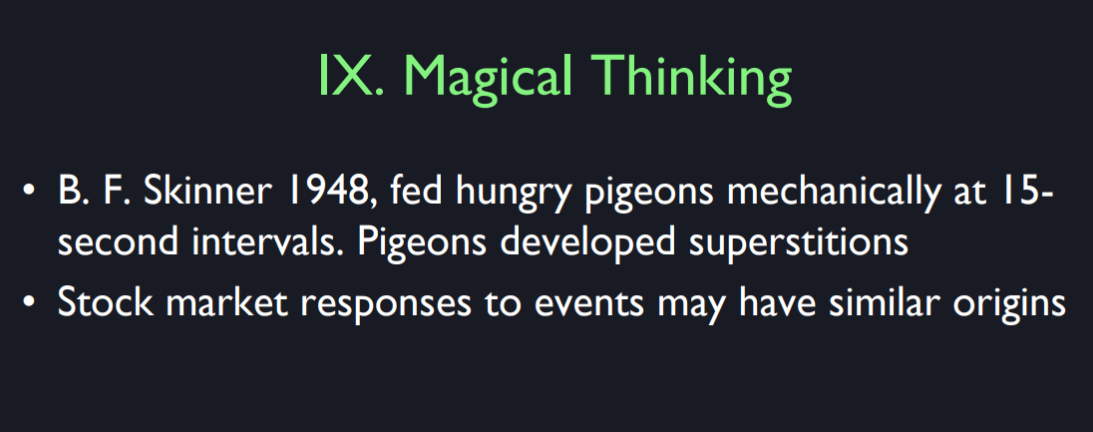
Nine is Magical Thinking. This is a term invented by B.F. Skinner in 1948, describing not human beings but pigeons. The very simple experiment. He had pigeons in cages, and they had a mechanical feeder. These were hungry pigeons and they kept them. They were getting enough food. Maybe this is a cruel experiment, not that cruel. They were just hung like on a diet, and they had a mechanical feeder that would drop one pellet of food every 15 seconds into the cage. This was really annoying to the pigeons because it was hungry and it had to eat at such a slow pace. But what he found was the pigeons started doing bizarre things dancing around or stomping their feet and he wondered what it was while he watched more closely and he discovered that they did the same thing that they did before the last pellet. They noticed that they stamped their foot randomly and then a pellet came out. And so they thought, well maybe that caused the pellet to come out and they’d try it again. Since there was only 15 seconds between 12 pellets, one came out of course. Then, they thought they’d learned that it affects the pellets even though it had not and then we know about the construction that the machine was just passing out a pellet every 15 seconds. But the pigeons started repeating behaviors because they thought they were connected to the pellet. In effect, they develop superstitions.

Then, there’s something else called quasi-magical thinking. In this case, we had this relates to Newcomb’s paradox. Let me tell you about Newcomb’s Paradox. The simplest way is to say, people vote, don’t they? Why do they vote? Okay. Well you know that in reality the probability that the decision will be won by one vote in the election is minuscule, right? There’s millions of people voting. The only way that it’ll make any difference to the outcome is if it’s almost exactly tied, and you went in and broke the tie but you know that that’s one in 100 million chance so you shouldn’t vote because you’re not going to have any impact. But people do vote, and that’s a paradox. What do people think when they vote? Well, what they’ll often say if you ask someone, don’t you know that the probability that you’ll decide the election is zero? Zero. Zero. Zero. So why do it? People will say, “Well, I know but I’m a good citizen.” And if everybody thought that way, we wouldn’t have a functioning system.
But Newcomb thought, well, there is a fallacy here. You’re not going to affect your decision whether you vote. You’re not going to affect what everybody else does. Shafir & Tversky demonstrate this in the lab in which they had the subject was playing a game with a computer and is told that the computer had observed the subject’s behavior, and they said, we have this really neat program that can predict what you’re going to do in your next decision. The computer knows what you’re going to do. So he’s told that the computer, there’ll be two boxes that appear on the screen, Box A and Box B. Now you’re told that the computer has been programmed to put a thousand dollars in box A, and you’re going to have a choice between A or B or both. But the computer knows which people will pick both. If it thinks the subject will pick box B alone, it will put a million dollars in box B. Needless to say, this wasn’t done with real money because this is hypothetical. But they ask people which would you pick, A or B or both? What do you think happened? Well, a lot of people pick B only. I don’t care about that $100, I’ll get the million. But wait a minute, they were told the computer has already decided the answer so why would you take. You should take A too because it’s already there. If what you decide now can’t possibly affect what the computer did in the past, but people do that so that’s a sort of magical thinking.

Ellen Langer is a Professor of Psychology at Harvard, found out that people will bet more on a coin not yet tossed. One option is to say, let’s flip the coin, it falls and we don’t look at it we cover it up. Now, you want to make a bet that comes up heads. People will bet more if it’s not yet tossed as if they think that they can somehow influence the toss by psychic powers.
Do you think there’s some point where the average market participant, the average investor should avoid at trying to make their own decisions about financial markets and should rely on expertise, or do you think that it’s imperative that everyone really achieve the level to where they can take control of their own financial future? Well, I think a medical analogy might be appropriate here. I think people are getting better at managing their illnesses by reading up, learning on the Internet, or various publications. They don’t rely just on their doctor. They’re getting better at recognizing symptoms that might be dangerous and go to the doctor and talk about that but they shouldn’t try to treat themselves, not generally. They should go to a doctor. I think it’s similar with finance. I think that it should be similar, but I think that people don’t respect financial advice as much as they do medical advice. Partly that is warranted I think. I think that medical doctors. My impression, I can’t prove this. Medical Doctors take an oath of loyalty to their patients while in medical school, and I think that colors their thinking. They’re more idealistic about- They’re doing it because they want to help you. Not always. I mean they’re profit oriented too but I think that there are some opportunities for financial advisers to strengthen their commitment to their clients, and I think that government policy could strengthen it further too. So, for example, I have advocated that the government should give a tax break for fees spent on financial advice. If the financial advisor signs a statement of loyalty to the client, and that the advisor will not steer the client toward financial products that profit the advisor, that will help I think. Then, I think we can develop a better sense of loyalty to the client and I would like to see a world where there is more respect for financial advisers, more talk about. If you talk to your neighbor and say, “Do you know a good financial advisor?” And you develop a relation with your advisor so you’re up late at night arguing with your spouse about finances and you say, “Let’s call our advisor.” That would be a good idea, but not many people do that. Not people of modest means that they, or middle class people, they don’t do that very much so I think we want to move toward a world where there is more financial advice and that it’s more focused on the real needs of clients.
Personality Disorders

Now, culture, I talked about earlier,
and social contagion. But there’s so much to say about this, but
culture is our society’s values and norms. Social cognition is our
thinking in generally, and Émile Durkheim in 1897 was
a pioneer in sociology. So, we have a collect, well, actually the word collective
memory was used by Durkheim. We remember the same thing, we talk,
we all have the same facts and statistics in our minds, so
we reach similar decisions. There’s social contagion,
and there’s a tendency for us to adopt beliefs of other people. There’s a mathematical theory of
disease epidemics that can be applied to speculative behavior.
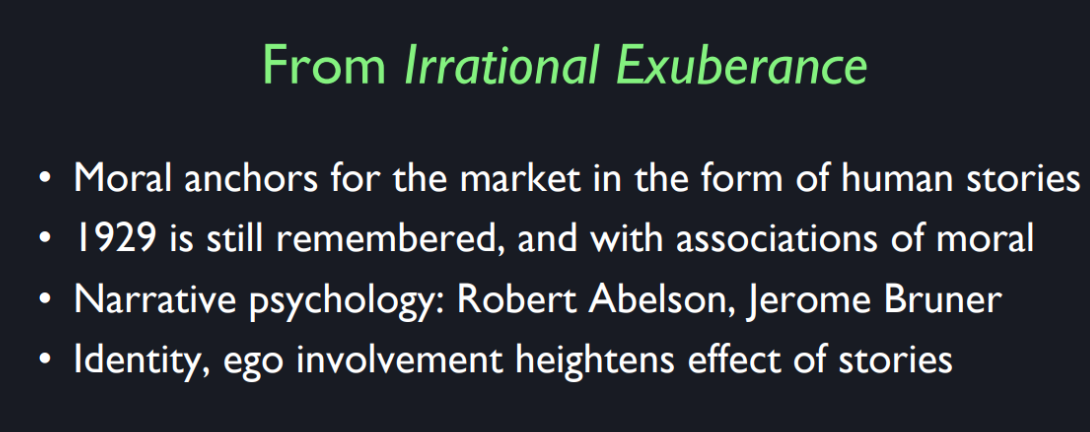
So, I’ve assigned for
this lecture of the course some pages from the book
Irrational Exuberance that I wrote. We talked about moral anchors for
the market in the form of stories. There’s a whole branch of psychology
called narrative psychology which reminds people that the human mind is influenced
fundamentally by stories about people. That we derive motivation
from these stories. Robert Abelson at Yale was
involved with that too. We have identity, a sense of identity, an ego involvement with stories
that we think relate to our life. We have a story of our life, and this
story can be tied in with other events that help promote one’s sense of ego.

And finally, my last of my categories
is antisocial personality disorder. This is a disorder which has been
recognized by psychiatrists, it has been called sociopath, or
sociopathy, or sociopaths, or psychopaths. And so the American Psychological
Association publishes a diagnostic and statistical manual. From their fifth edition, we define
this disorder in the following terms. Identity, egocentric,
self-esteem from personal gain, self-direction, absence of
prosocial internal standards, lack of empathy, incapacity for
intimacy, manipulative, deceitful, callous, hostile, irresponsible,
impulsive, risk-taking. Boy, those are a lot of insults. But what they’re referring
to in the DSM5 is that this is a pattern, that there
are people who show all of this things. There’s something in their
brain that is different, and so certain emotions which we take for
granted are not there. Now, in DSM5 as opposed to DSM4, it used
to be all or nothing [COUGH] diagnoses, now they want to acknowledge gradations,
or levels of. It’s not all or nothing, we might
all be antisocial at some time, but not at others.

There’s also, this is different from
borderline personality disorder, which is more common among women than men. And about 3% of men are antisocial
personality disorder, at least according to the fourth edition,
and only 1% of women. But women, it’s reversed with
borderline personality disorder. So, instability of relationships, extremes of overidealization,
and then devaluations. They swing from thinking this is
a perfect friend to not perfect. Depressed moods lasting hours to days,
inappropriate intense anger, frantic efforts to avoid real or
imagined abandonment.
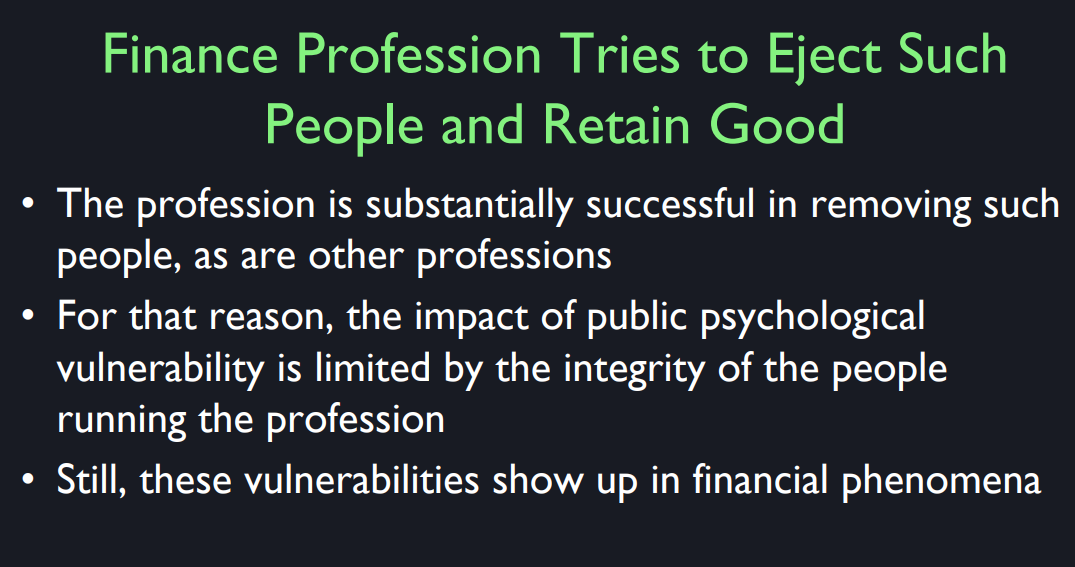
But I want to talk about
antisocial personality disorder. The movie The Big Short suggests that
some people in the finance [LAUGH] profession have antisocial
personality disorder, is that true? Well, there’s a literature on this, I think the answer is no,
those guys are in jail. That the profession like,
the finance profession, like other professions is pretty
successful in discovering these disorders, but on the other hand,
there might be an attraction. If you read the list of symptoms of
antisocial personality disorder, it does fit, but
I think that it’s not true. That, like in any other profession,
we are successful, and you can’t hide these things for
too long, and you’ll end up caught. It’s unfortunate we have
to deal with these, it’s 3% of our male population has this
disorder, we have to live with it.
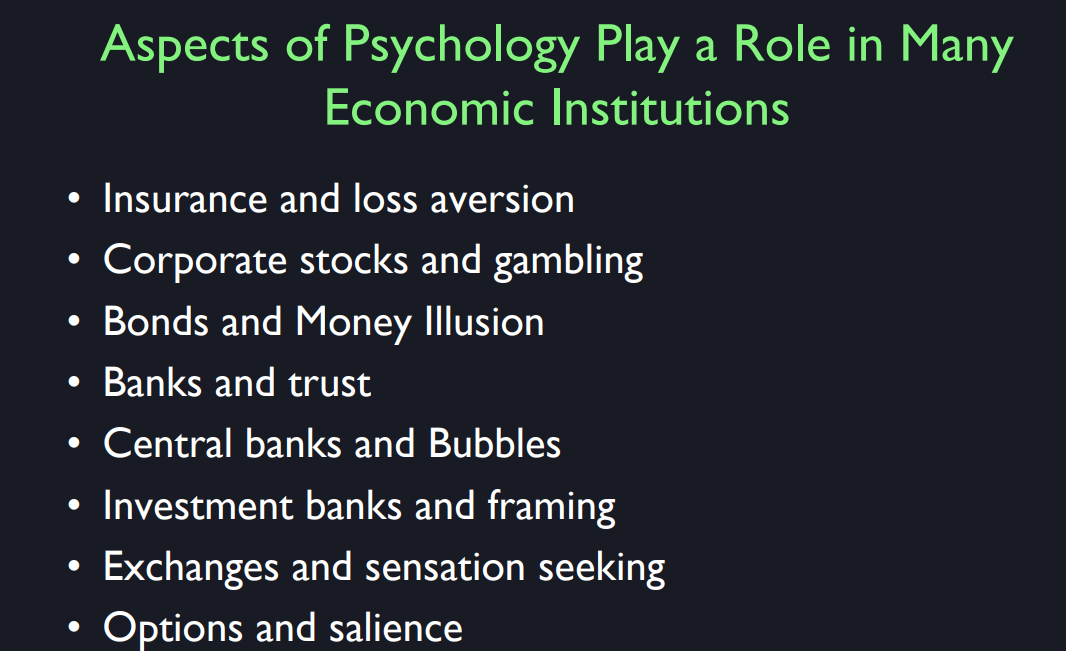
Anyway, I’m just going to conclude
with these psychological principles that I talked about are involved in many
things that happen in the financial world.
Lesson #7 Quiz

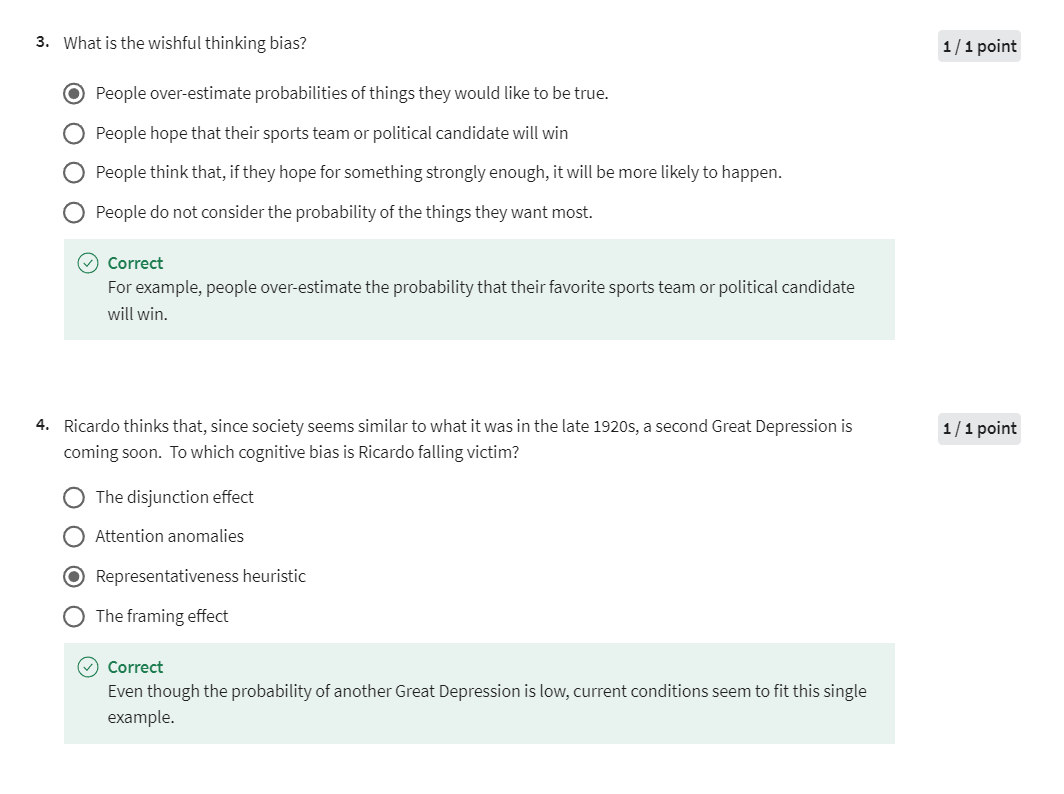

Module 2 Honors Quiz
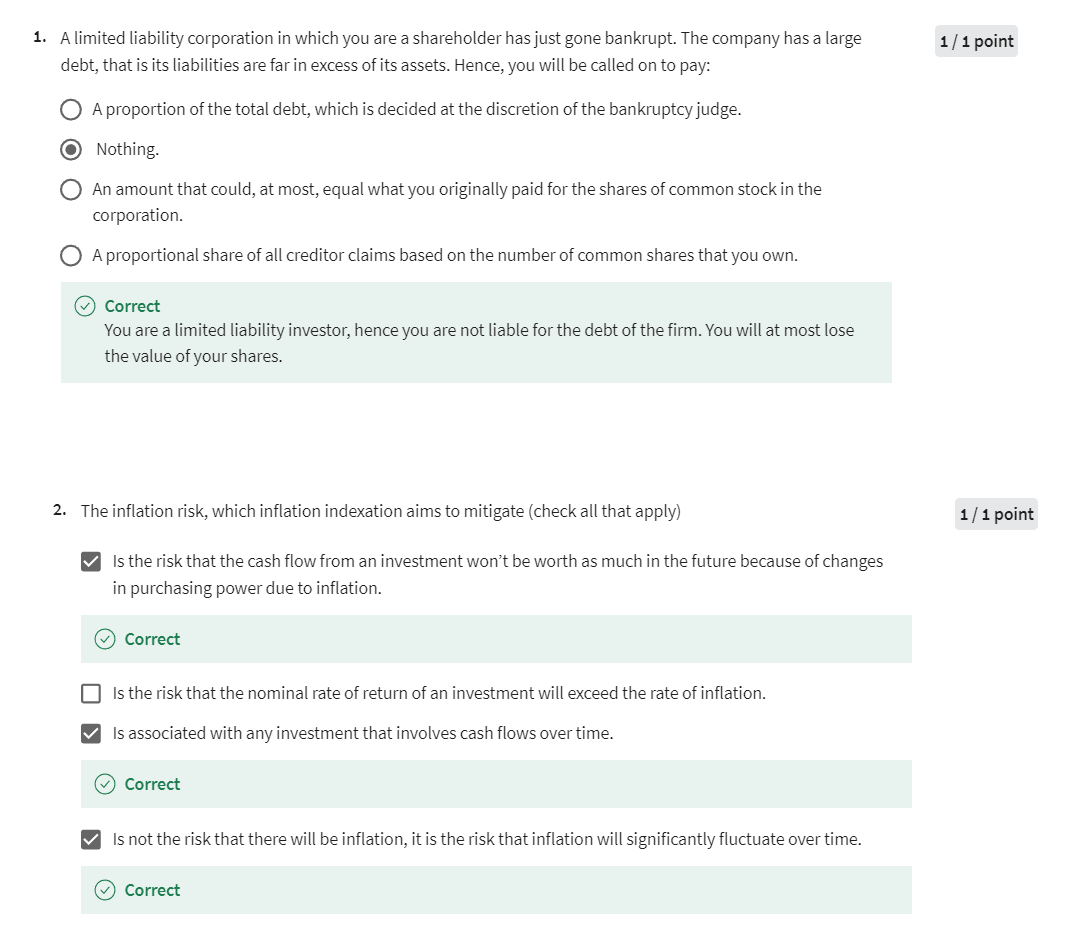
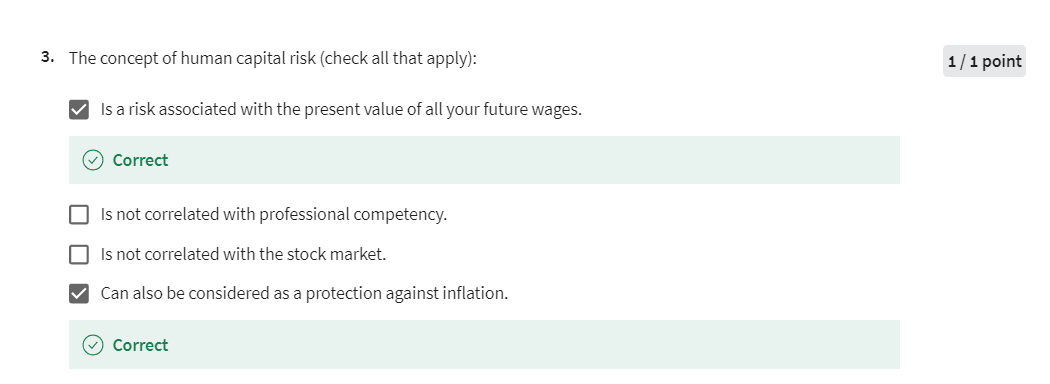

The random walk hypothesis of the Efficient Market Theory posits that:
0 / 1 point
Historical stock prices follow a random walk.
Stock price volatility follows a random walk.
Historical stock returns follow a random walk.
Short-term investment returns are inherently unpredictable.
第四题经过排除法,是选Short-term investment returns are inherently unpredictable.
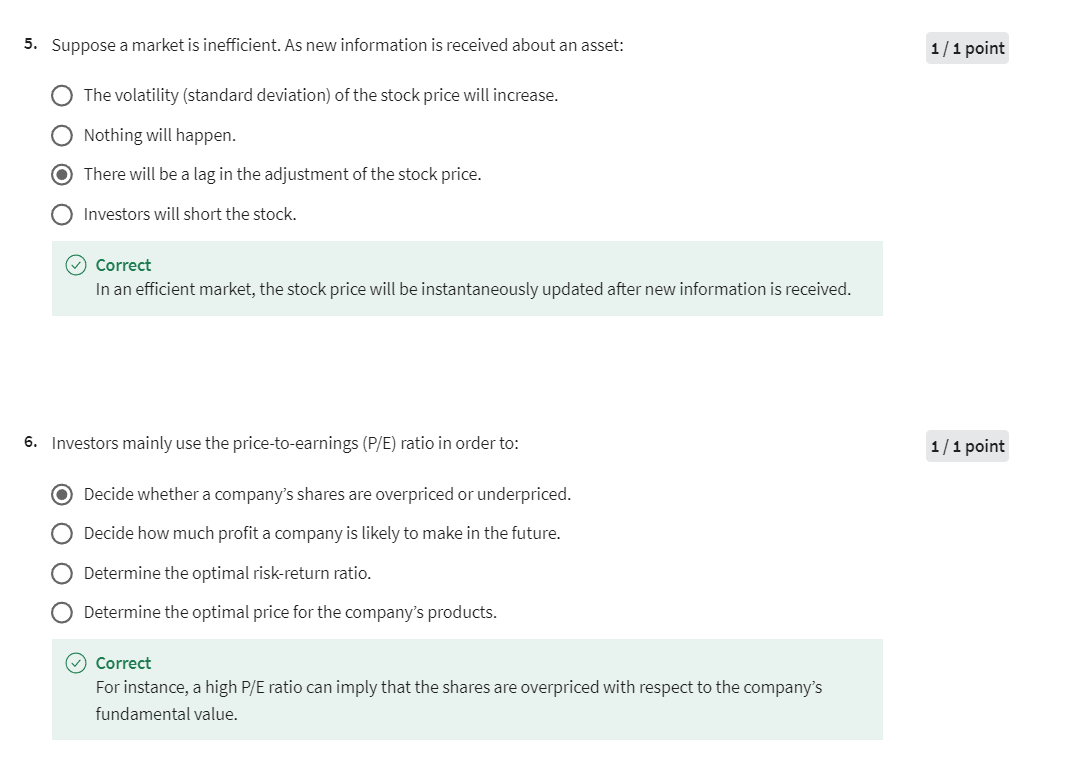
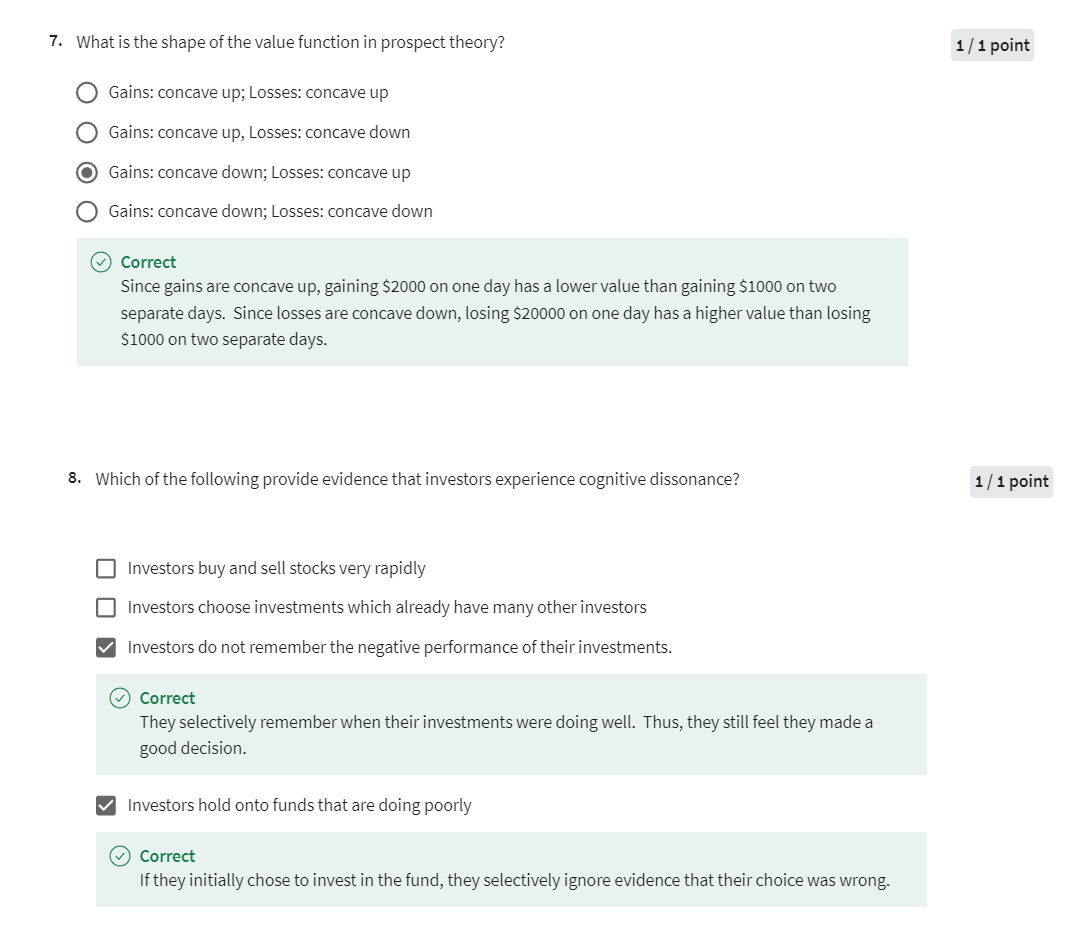


后记
2024年6月16日22点15分完成Week 2的学习,在这周的笔记中,使用GPT4o补充了很多知识点,加深自己对金融学的理解;虽然时间花费比较多,但是收获相应地增大。